ALPS ALPINE 9ZUA145 Car Navigation Unit User Manual 68 29530Z12 A c3 comm FCC
Alpine Electronics Inc Car Navigation Unit 68 29530Z12 A c3 comm FCC
Contents
- 1. (Short-Term Confidential) User Manual_1
- 2. (Short-Term Confidential) User Manual_2
- 3. (Short-Term Confidential) User Manual_3
(Short-Term Confidential) User Manual_3
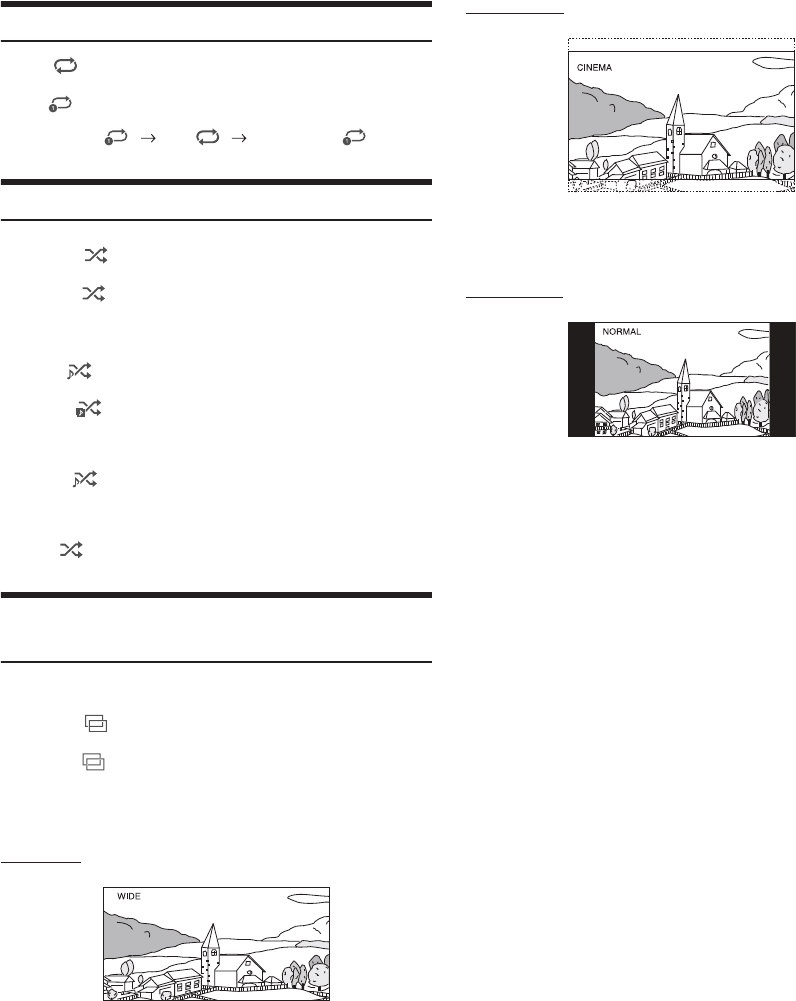
60-EN
Repeat Play
Touch [ ] to repeatedly play back the currently track.
The tracks (files) will be played repeatedly.
Touch [ ] again to deactivate Repeat play.
Random Play (Shuffle)
1Touch [ ].
The Random Play mode select pop up screen is displayed.
• The [ ] button displays the currently selected mode.
2Select your desired Random Play mode.
The selected Random Play mode changes the button.
Switching Display Modes (During Video File Play
Back)
You can switch the Display Mode while playing a Video File.
1Touch [ ].
The Display Mode select pop up screen is displayed.
• The [ ] button displays the currently selected mode. (e.g.
[Normal])
2Select your desired Display Mode.
Wide mode
In Wide mode, the monitor displays a normal picture wider to fit in a
wide-screen monitor by evenly stretching out the picture
horizontally.
Cinema mode
In Cinema mode, the monitor displays a normal picture by stretching
out the picture horizontally and vertically. This mode is good for
displaying a cinema type picture at the 16:9 ratio.
Normal mode
In Normal mode, the monitor displays a normal picture at the center
of the screen with a vertical black band at each side.
Track Repeat OFF Track Repeat
Song : All files in the iPod are played back in random
sequence.
Album : The songs on each album are played back in
proper order. Upon completing of all the songs on
the album, the next album is selected randomly.
This continues until all albums have been played.
Songs : Song shuffle randomly plays back songs within a
selected category (playlist, album, etc.). The songs
within the category are played just once until all
songs have been played.
OFF : Random mode Off.

61-EN
Pandora® internet radio is your own FREE personalized radio now
available to stream music on your Smartphone (which runs Android OS,
iOS or BlackBerry OS).
Just start with the name of one of your favorite artists, songs or classical
composers and Pandora® will create a “station” that plays their music and
more music like it.
The unit enables you to interact with your Pandora® account by
connecting an iPhone and smartphone that has the latest version of the
Pandora® application installed.
iPhone Pandora main screen example
Function mode
Bluetooth Pandora main screen example
Function mode
Station name
Artist Name
Song Name
Album Name
Playing time
Artwork display
Track/Artist bookmark icon
Listening to Pandora®
1Launch the Pandora® on the smartphone.
2Press the (AUDIO) button to select Pandora® or
Bluetooth Pandora® mode.
The display shows the Pandora mode screen.
• You can select and change the source in the Menu screen (page
@@) or Favorites screen (page @@).
3To pause playback, touch [ / ].
4To skip to the next song, touch [ ].
• The operation to replay a previous song is not available.
• Pandora® limits the number of skips allowed on their service. If you
attempt to skip songs beyond the limit, “You’ve reached your skip limit.”
is displayed.
• Even if you reconnect an iPhone without launching Pandora
Application while the power is off, Pandora mode (not iPod mode) is
displayed when power is turned back on.
• Depending on the signal status, song may be stopped during playback.
• While receiving an advertisement, you cannot operate any buttons
other than [ / ] (play/pause) and [ ] (Search).
• The playback time may not be correctly displayed.
• The display content varies when ads are received.
Pandora® internet
radio (optional)
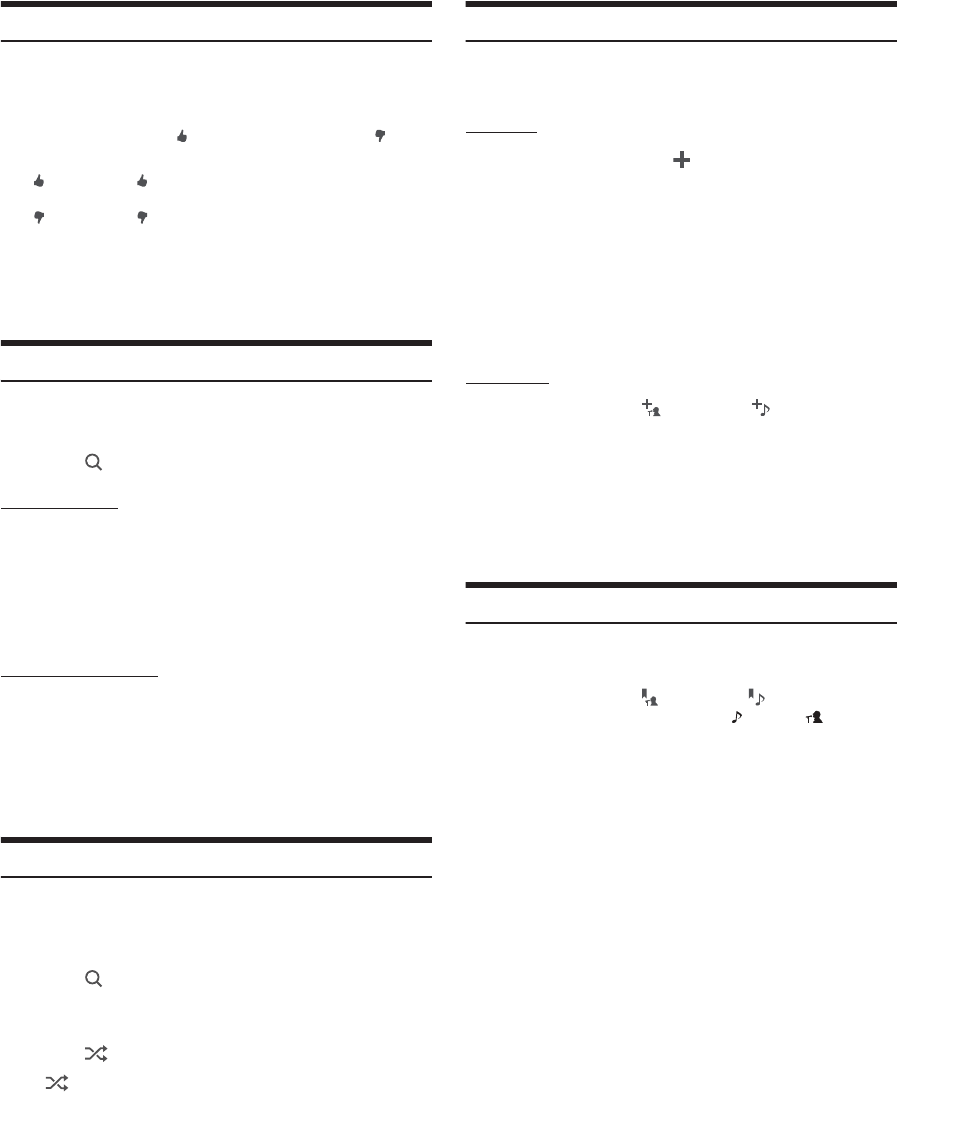
62-EN
“Thumbs” Feedback
You can personalize your stations with “Thumbs Up” or “Thumbs
Down” feedback, which the system takes into account for future music
selections.
During playback, touch [ ] for thumbs up, or touch [ ] for
thumbs down.
• In some situations, “Thumbs” feedback may not be available.
Searching for a Desired Station
You can display your station list and select stations directly from the
unit.
1Touch [ ] (Search) to activate the Search mode.
Alphabet Search
2Touch [By A-Z].
The “By A-Z” search mode is activated and the station names are
listed alphabetically.
3Touch the desired station.
Pandora will play that station.
Search by Date Added
2Touch [By Date].
The “By Date” search mode is activated and the station names
are listed by the date they were added to the account.
3Touch the desired station.
Pandora will play that station.
QuickMix
Use QuickMix to create a playlist based on two or more of your Pandora
stations. Edit your QuickMix station selections on the Pandora
Compatible Application for iPhone when it is not connected to the unit.
1Touch [ ] (Search) to activate the Search mode.
The “By A-Z” or “By Date” search mode is activated and the
station name is displayed.
2Touch [ ] (QuickMix).
• The indicator lights, and the songs from the created stations are
played back in random sequence.
Creating a New Station
Basing on the currently playing song or artist, a personalized Pandora
station can be created. The new station will play more music like it.
Free word
1During playback, touch [ ] (New Station).
The Key Pad screen is displayed. You can enter a keyword and
search for Artist/Song.
2Enter a keyword and touch [OK].
3Touch the desired list.
The new station is automatically applied.
• For details of how to input characters from the keypad, refer to “How to
Input Characters and Numbers (Keypad)” (page @@).
Artist/Track
During playback, touch [ ] (Artist) or [ ] (Track).
• The created station is saved to your station list.
• When the Smartphone is not connected to this unit, you can create
personalized Pandora® stations using the Pandora® Application on your
Smartphone. You can also create stations on the web at
www.pandora.com.
• In some situations, creating a new station may not be available.
• You cannot perform this operation while driving.
Bookmarking a Desired Track or Artist
The currently playing song or artist can be bookmarked and saved to
your Pandora account.
During playback, touch [ ] (Artist) or [ ] (Track).
The current track or artist is bookmarked. “ ” icon or “ ” icon is
displayed.
• Your bookmarks can be viewed on your “Profile” page at
www.pandora.com.
• In some situations, bookmarks may not be available.
: The “ ” indicator appears in the display. Pandora® will
add similar music to your station.
: The “ ” indicator is displayed. Pandora® will ban that
song from your station, and the current song is skipped.
If the number of skips allowed has reached its limit, the
current song continues to play back.
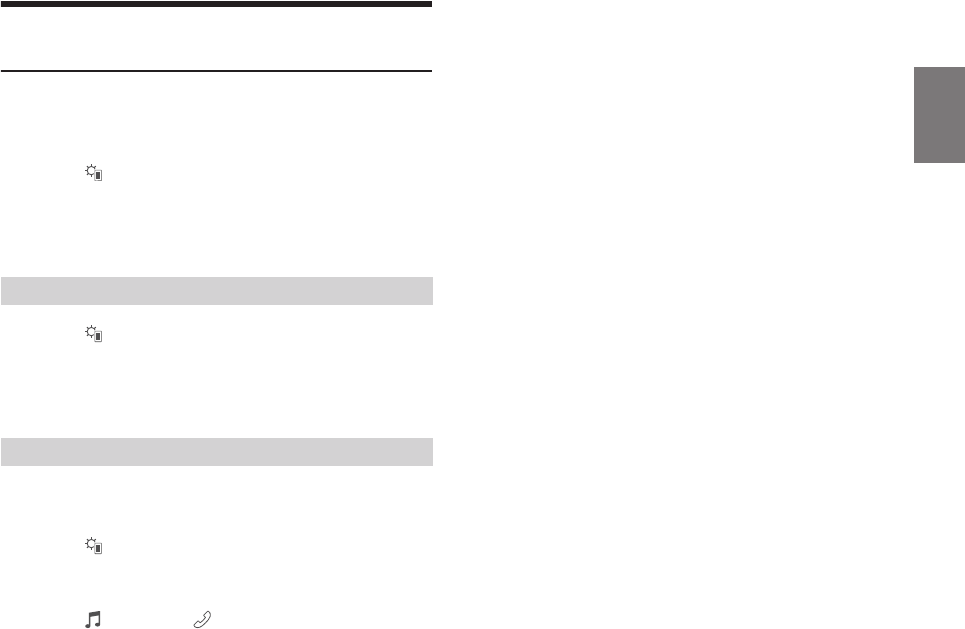
63-EN
Connecting a Bluetooth Device (Bluetooth
Pandora® Only)
Registering a Bluetooth device in the unit enables automatic connection.
If it does not connect automatically, run through the connection
procedure again.
1Touch [ ] (Settings).
The Device Setting select pop up screen is displayed.
2Touch [Reconnect].
Bluetooth connection will start.
1Touch [ ] (Settings).
The Device Setting select pop up screen is displayed.
2Touch [Disconnect].
The Bluetooth connection is disconnected.
If multiple Bluetooth devices are registered in this device, you can
change the connection among the registered devices.
1Touch [ ] (Settings).
2Touch [Change].
3Touch [ ] (Audio) or [ ] (Hands-free) of the selected
device.
The connection will transfer to the selected device.
Disconnecting the Bluetooth Connection
Changing the connecting Bluetooth Device

64-EN
SiriusXM Tuner operation:
When an optional SiriusXM Tuner is connected to this unit, the
following operations may be performed.
SiriusXM main screen example
Function mode
The Function mode switch is different depending on Tune Start mode
and Replay mode.
< When Tune Start mode is not available>
< When Tune Start mode is available>
< During Replay mode>
Tag Indicator
When Tagging is available, the Tag indicator is shown.
Info area
Station Info. Mode:
Channel No/Long Channel Name/Category Name
Song Info.Mode:
Artist Name/Song Name/Album Name
Album Art
The image that corresponds with the channel currently being
received is displayed.
• You can change the artwork position. For details, see “Switching
the Artwork Position” (page @@).
Preset mode button
Touch or swipe to the right when you use the Preset mode
screen.
Preset mode screen example
Preset button
Swipe vertically in the list to change pages.
Search mode button
Swipe to the right when you use the Search mode screen.
SiriusXM Satellite
Radio Operation
(Optional)
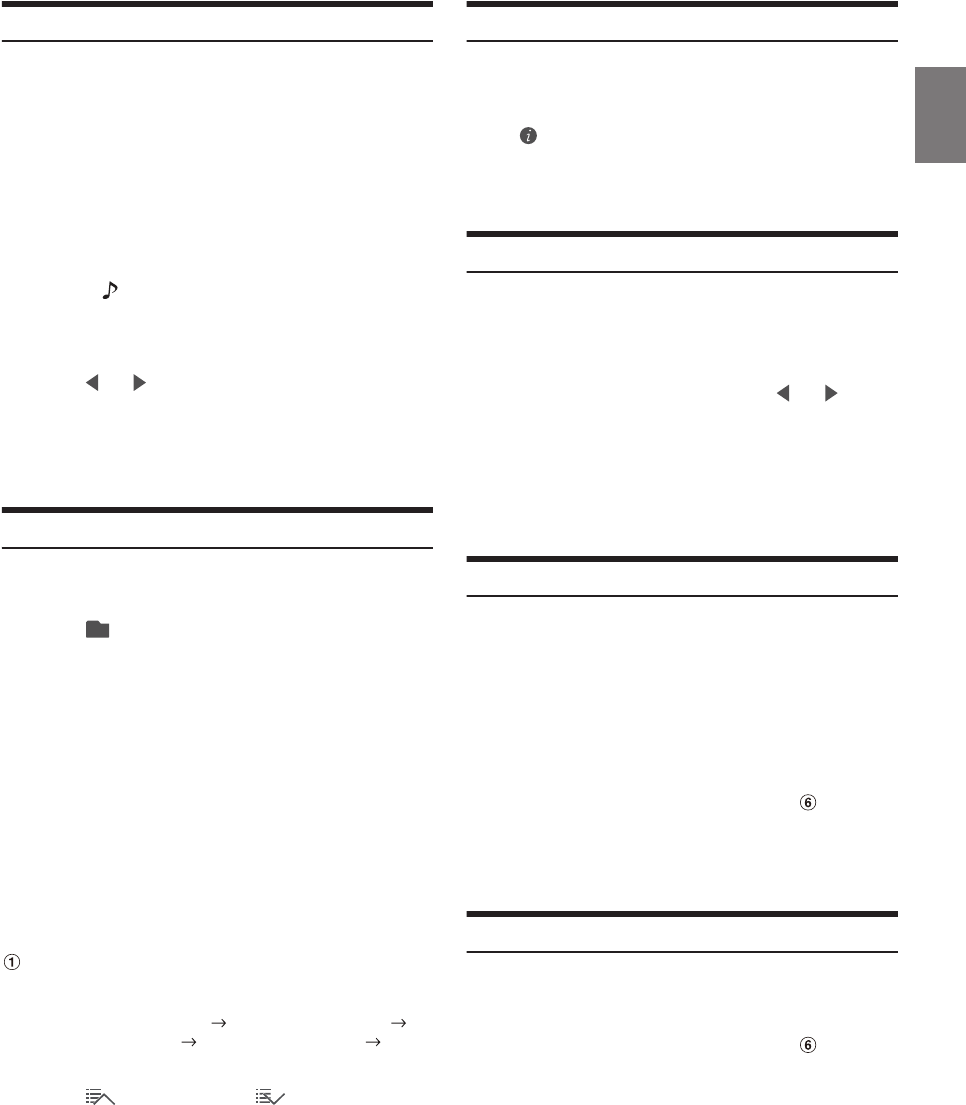
65-EN
Receiving Channels with the SiriusXM Tuner
About SiriusXM Satellite Radio
Everything worth listening to is on SiriusXM, getting over 130 channels,
including the most commercial-free music, plus the best sports, news,
talk and entertainment. A SiriusXM Tuner and Subscription are
required. For more information, visit www.siriusxm.com/activatenow,
or call 1-866-635-2349.
To activate SiriusXM Canada service, go www.xmradio.ca and click on
“ACTIVATE RADIO” in the top right corner, or call 1-877-438-9677.
• The SiriusXM Satellite Radio controls on this unit are available only
when a SiriusXM Tuner is connected.
1Press the (AUDIO) button to select SiriusXM mode.
The display shows the SiriusXM mode screen.
• You can select and change the source in the Menu screen (page
@@) or Favorites screen (page @@).
2Touch [ ] or [ ] to select the desired channel. Touching
and holding either button will rapidly browse through
the channels.
• Refer to the SiriusXM Tuner User Guide for details on how to install the
SiriusXM Tuner.
Tuning Channels by Category
Channels are grouped into categories based on the type of content heard
on the channels.
1Touch [ ] (Category) on the SiriusXM main screen to
activate the category browsing mode.
The channels within the category of the current channel are
listed.
Category browsing mode screen example
Touching the [Info] button changes the display of
information for the channels in the category with the
following three options.
Channel No./Channel Name Channel No./Artist Name
Channel No./Song Title Channel No./Content Info
Channel No./ Channel Name
2Touch [ ] (Category Up) or [ ] (Category Down)
on the category browsing mode screen to select a
desired category.
The Category Name is shown at the top of the display.
3Select the desired channel.
• If no operation is performed for 10 seconds, the category browsing mode
is canceled.
Changing the Display
Text information, such as the channel name, artist name/feature, and
song/program title, is available with SiriusXM or channel. The unit can
display this text information as explained below.
Touch [ ] (Info).
Each time you touch this button, the Station Info. mode and the Song
Info. mode switch alternately. For displayed contents, see “SiriusXM
main screen example” (page @@).
Checking the SiriusXM Radio ID Number
To subscribe to the SiriusXM Satellite Radio service, it is necessary to
locate and identify the Radio ID of your SiriusXM Tuner. You can check
the Radio ID on the bottom surface of the SiriusXM Tuner box. You can
also check it from this unit by performing the following procedure.
1While receiving SiriusXM Radio, touch [ ] or [ ] to
select channel “0”.
The unit displays the ID number.
2To cancel the ID number display, change the channel
other than “0”.
• The SiriusXM Radio ID does not contain the letters I, O, S, or F.
Storing Channel Presets
You can store 18 of your favorite SiriusXM channels for easy recall with
Preset buttons.
1Touch the Preset number you want to store, for at least 2
seconds.
The selected channel is stored.
2Repeat the procedure to store up to 17 other channels.
A total of 18 channels can be stored in the preset memory.
• For details on switching to the Preset mode screen, see in “Preset
mode screen example” (page @@).
• If you store a new channel into a preset which already has a channel
assigned, the current channel will be cleared and replaced with the new
one.
Tuning Channels using Presets
Touch any one of the Preset numbers you have already
stored in the Preset mode screen.
The preset station is received.
• For details on switching to the Preset mode screen, see in “Preset
mode screen example” (page @@).
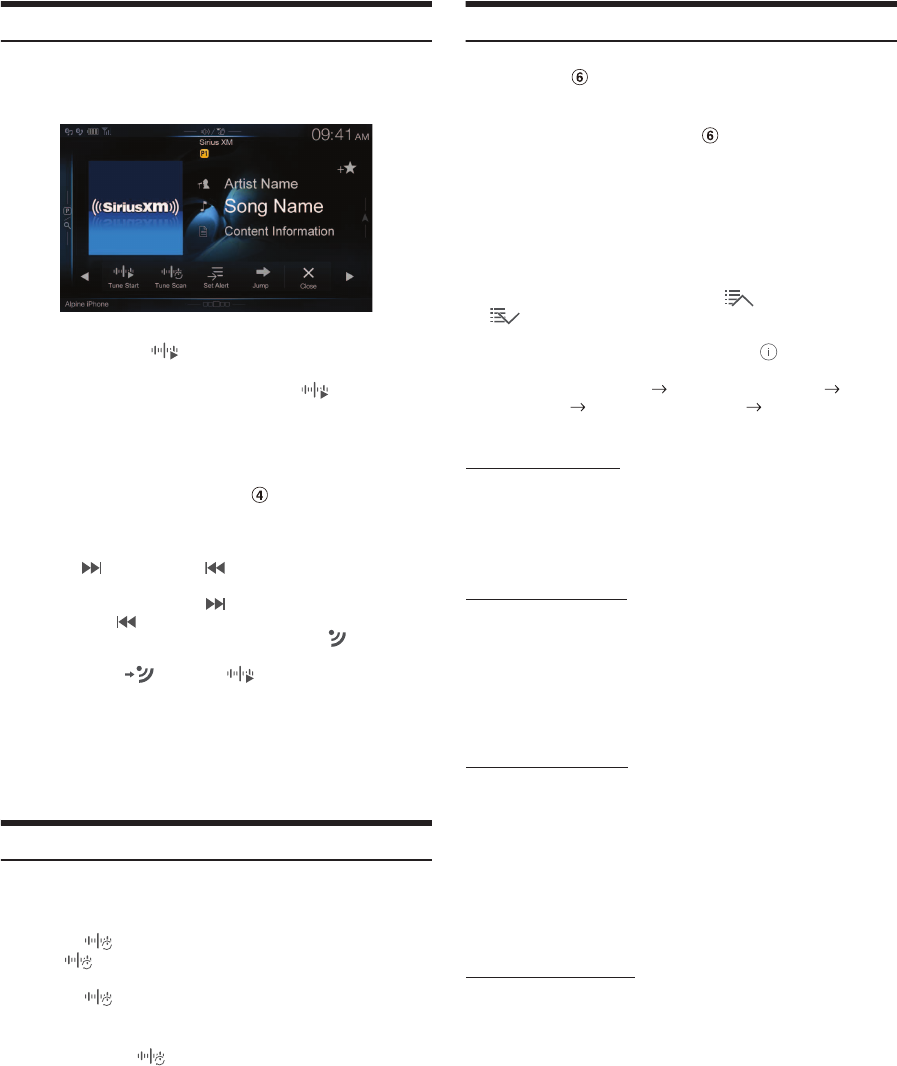
66-EN
Tune Start Function
Use Tune Start to play music content from its beginning on programmed
preset stations. The user can, therefore, enjoy the full track (i.e. song)
rather than hearing what’s left from its current live playback position.
1Touch and hold [ ] (Tune Start) for at least 2 seconds
to activate or deactivate the Tune Start function.
When the Tune Start function is activated, [ ] (Tune Start) is
highlighted.
2On the Preset Mode screen, touch the Preset number.
Tune Start mode will begin.
• To switch to the Preset mode screen, see in “SiriusXM main screen
example” (page @@).
• The number of preset channels that Tune Start can access differs
depending on the SiriusXM Tuner Box.
• Touching [ ] (Track Up) or [ ] (Track Down) will move a track
up/down.
• To fast reverse, touch and hold [ ] (Track Up) and to fast forward,
touch and hold [ ] (Track Down).
• During Tune Start mode, the difference between the “ ” indicator
and the current time is displayed (ex. -15:00).
• When you touch [ ] (Live) or [ ] (Tune Start) during Tune
Start, the program currently selected in Tune Start mode changes to the
program currently being broadcast.
• This function is available only when SiriusXM Tuner-SXV200 is
connected.
• Preset stations that play other than music-type content will start playing
the channel from the current live play point when selected.
Tune Scan Function
While listening to SiriusXM Satellite Radio, you can scan through all the
songs you missed from your current band of preset channels.
1Touch [ ] (Tune Scan).
The [ ] (Tune Scan) highlighted during Tune Scan mode.
2Touch [ ] (Tune Scan) during scan playback, tune
scan mode will be canceled and the selected track will be
played back normally.
Touch and hold [ ] (Tune Scan) for at least 2 seconds during
scan playback to cancel Tune Scan mode. The tuner returns to
the channel before Tune Scan was initiated.
• This function is available when SiriusXM Tuner-SXV200 is connected.
• If no operation is performed during the scanning process, when
scanning finishes, the next mode depends on the SiriusXM Tuner.
• During Tune Scan mode, the artist and song name will be displayed.
• The SiriusXM Tune scans through the songs from the preset music
channels on the current band only, scanning from oldest to newest.
• The number of Preset channels and the play times that can perform
Tune Scan differ depending on the SiriusXM Tuner box.
Search Function
1Touch the Search mode button on the Preset mode
screen.
The Search list screen appears.
• To switch into Search mode, see in “Preset mode screen
example” (page 46).
Search item:
All Channels / Category Name*1 / My Music / My Games /
Featured*2
*1 The Category name for the channel currently being received is
displayed.
*2 Displayed only when the SiriusXM Tuner-SXV200 is connected.
• You can switch the category by touching [ ] (Category Up) or
[ ] (Category Down) on the List screen after selecting a Search
item other than Featured.
• You can switch the display format by touching [ ] (Info) in the List
screen after selecting a Search item.
Channel No./Channel Name Channel No./Artist Name Channel
No./Song Title Channel No./Content Info Channel No./Channel
Name
Searching by Channel
2Touch [All Channels].
All Channels will be displayed in a list.
3Touch the selected channel.
Searching by Category
2Touch Category Name.
The channels within the category of the current channel are
listed.
3Touch the selected channel.
The channel you selected is received.
Searching by My Music
2Touch [My Music]*.
The artist names and song titles that you have stored and are
currently playing will be displayed in a list.
*Displayed only when the stored song or artist is broadcasting.
3Touch the desired artist/song.
The channel of the selected artist/song being broadcast is
received.
Searching by My Games
2Touch [My Games]*.
The sport teams that you have stored and the game is currently
broadcasting will be displayed in a list.
*Displayed only when the game of stored team is broadcasting.
3Touch the desired team.
The channel of the selected game being broadcast is received.
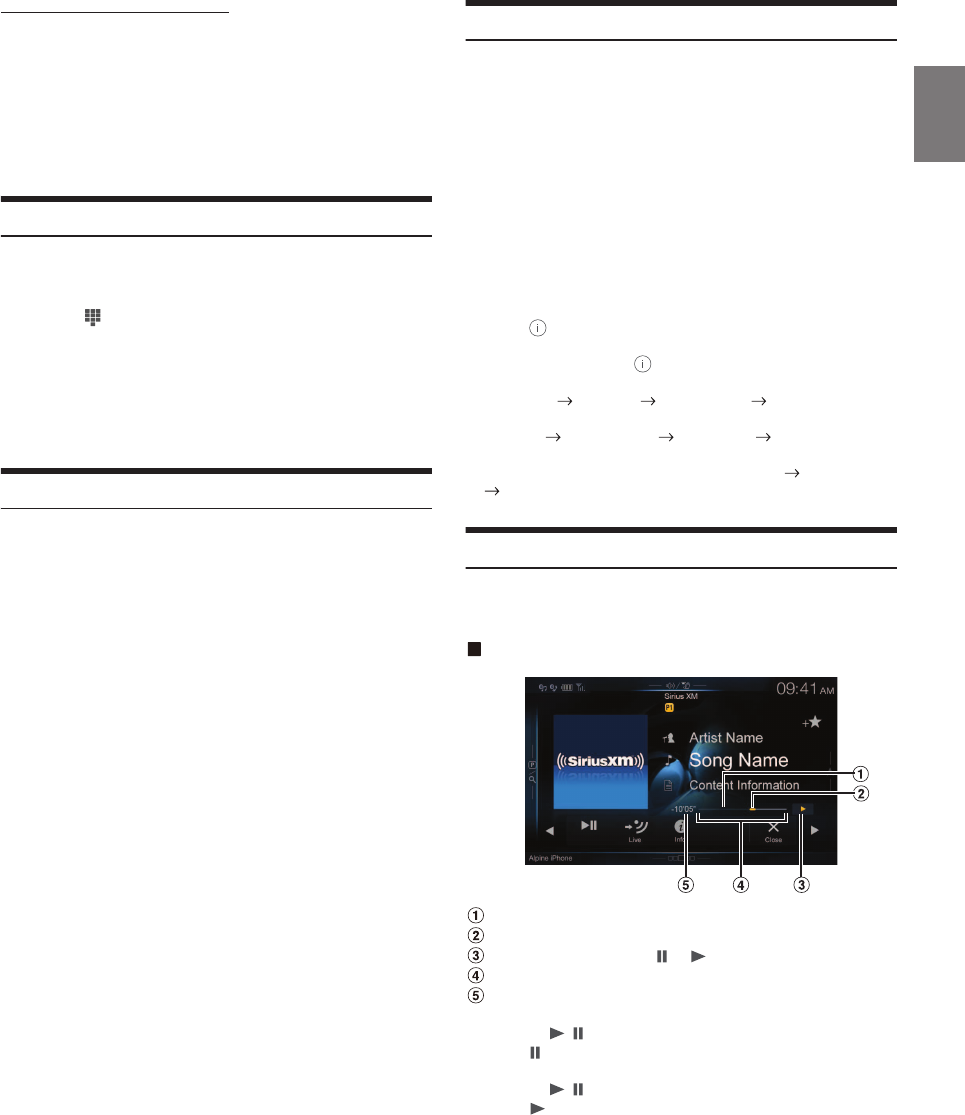
67-EN
Searching by Featured Favorites
1Touch [Featured]*.
The Category that SXM recommends will be displayed in a list.
*Displayed only when the SiriusXM Tuner-SXV200 is connected.
2Touch the desired category.
3Touch the desired channel within the selected category.
Selecting the Channel Directly
You can directly select the channel number on the display of the
numeric keypad.
1Touch [ ] (Direct Tune).
The numeric keypad input screen is displayed.
2Touch to input the channel number.
3Touch [Enter].
The selected channel is received.
Storing the desired Song/Artist
While listening to SiriusXM Satellite Radio, you can be alerted when
your favorite songs or artists are playing on other channels. An
interruption Alert will be displayed when a matching artist or song is
found on another channel. For receiving interruption Alert information,
see “Receiving and Tuning to an Alert”.
1Touch [##] (Set Alert) for at least 2 seconds on the
SiriusXM mode screen.
The Memory type selection screen is displayed.
2Touch the ”Artist Saved” or “Song Saved” to select the
store type.
Scrolling text of the Artist’s name (Song Title), Total registrations,
and Remaining number of registration slots is displayed for 2
seconds, then the Artist or Song is registered as an Artist alert or
Song alert.
• The maximum number of registered Teams, Artists, and Songs is 50.
For details on how to register a Favorite Team, see “Setting the Favorite
Sports Team Alerts” (page @@).
• “Artist /Song Unavailable” appears on the display if both the artist and
song is not available to be stored.
• “Artist (Song) Unavailable” is displayed if just the artist (song) is not
available to be stored.
“Artist (Song) Saved” is displayed if this Artist (Song) was previously
stored.
• If there is no memory space, “Alert Memory Full” is displayed, and then
you are asked whether you want to replace a stored item. If you select
“OK,” then the list of stored alert items is displayed. Touch the item that
you want to replace.
Receiving and Tuning to an Alert
Whenever a stored sports team, artist, or song is playing on another
channel, an interruption Alert appears on the unit display. To tune to the
game, artist or song identified by the alert, follow the steps below:
1When stored information is broadcast, after displaying
“Song Alert”, “Artist Alert” or “Game Alert,” the screen
changes to My Music list*1 or My Games list*2 display.
*1 Only for Song Alert and Artist Alert.
*2 Only for Game Alert.
2Touch the channel on the list you want to receive.
The display changes to the selected channel and the channel is
received.
• Touch [ ] (Info) on the My Music list/My Games list screen, the
information of the broadcasting channels will be changed.
Each time you touch the [ ] (Info), the display changes as below.
My Music list (Artist Alert):
Artist name Song Title Channel name Artist name
My Music List (Song Alert):
Song Title Channel Name Artist Name Song Title
My Games list:
League Short Name/Team Abbrev/Team Nickname Channel name
League Short Name/Team Abbrev/Team Nickname
Replay Function
In SiriusXM mode, you can pause, rewind and replay of live Satellite
Radio.
Replay mode screen example
Buffer usage
Current Replay point
Replay status indicator ( or )
Replay range
Time to live
1Touch [ / ] to Pause playing of the channel content.
The “ (Pause)” indicator and replay progress bar is displayed.
2Touch [ / ] again to resume playing the content.
The “ (Play)” indicator lights up and offset playback
commences.
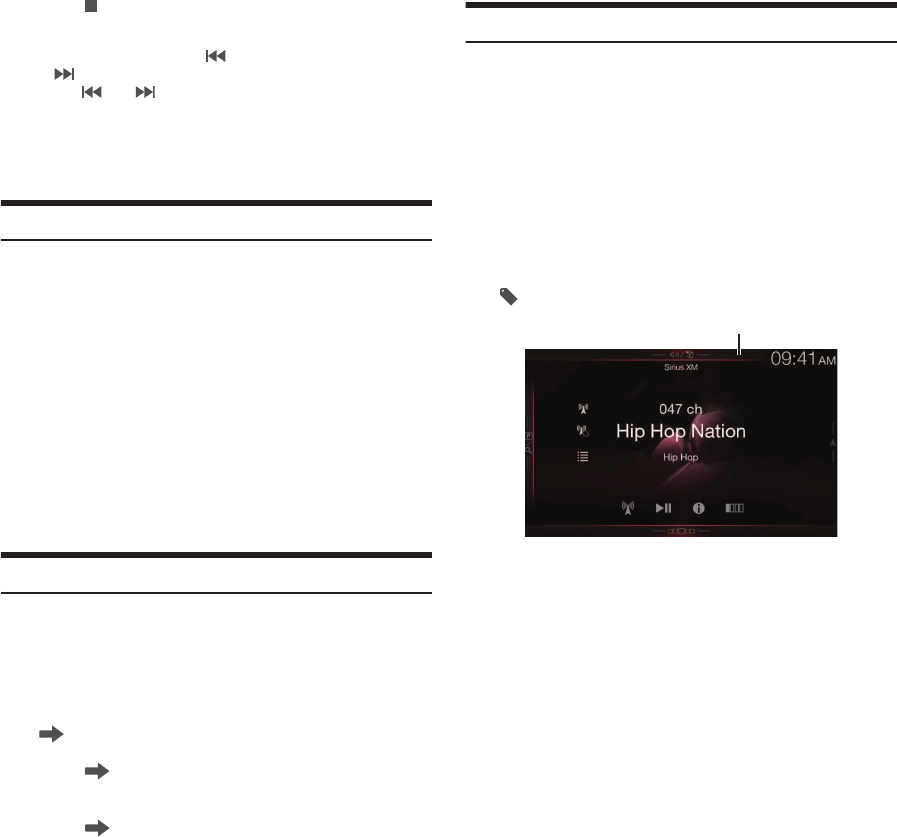
68-EN
3Touch [ ] to exit Instant Replay and listen to live
content.
• To fast reverse, touch and hold [ ] and to fast forward, touch and
hold [ ].
• Touching [ ] or [ ] will move a track up/down.
• If you change channels while in Replay mode, the contents of the replay
buffer are emptied.
• The allowed recording time differs depending on the SiriusXM Tuner
box.
Parental Lock Function
This function can help restrict the listening of channels to children of
appropriate age levels only. For information on setting the Parental
Control passcode, see “Setting the Parental Lock” (page @@).
When a locked channel is selected, “Channel <xxx> Locked” is displayed
and then the numeric keypad appears for you to enter the passcode.
Input the 4-digit passcode you set in “Setting the Parental
Lock” (page @@).
The initial number is 0000.
• If you input a wrong passcode, “Incorrect Pass Code entered” is
displayed.
• After entering the correct passcode, you can access all locked channels
without entering the passcode again until the unit is powered off and
then back on.
Using Jump Memory and Jump Recall function
The Jump Channel is a special channel that you can jump to with the
press of a dedicated button and then jump back to the previous channel.
This channel is often used to select your favorite SiriusXM traffic and
weather report channel.
1To store the Jump channel in memory, touch and hold
[ ] (Jump) for at least 2 seconds.
2Touch [ ] (Jump) to recall and tune to the saved Jump
channel.
3Touch [ ] (Jump) again to receive the previous
channel.
• While receiving the Jump channel, you cannot perform other
operations.
• Only one channel can be stored as the jump source channel. When you
want to store a new channel, the old channel will be cleared and the new
one will be memorized.
Storing the Tag information
iTunes Tagging lets you tag songs heard on SiriusXM channels. Using
this unit in conjunction with an optional SiriusXM Tuner and a Tagging
compatible iPod/iPhone, you can tag the music that you listen to, then
transfer the tag information to your iPod/iPhone, and later, when your
iPod/iPhone is connected to iTunes, you can preview, buy and download
your tagged songs. For details, refer to the Owner’s Manual of the
Tagging compatible iPod/iPhone.
The “Tag” indicator will appear when a song playing on a SiriusXM
channel has tag information available.
When Tagging is available, the “Tag” indicator is shown.
When a desired song is heard on an SiriusXM channel, touch
the [ ] (Tag) to save its tag information.
If no iPod/iPhone is connected, “Tag count X” is displayed (X is the
total amount of the tag information stored in this unit).
• During tagging, the iPod/iPhone takes priority to save the tag
information. If no iPod/iPhone is connected, the tag information is
saved to this unit.
• When the memory of iPod/iPhone is full, “iPod memory full.” is
displayed. The tag information will be stored to the unit.
• If the tagging operation is interrupted by a hands-free phone call, the
tagging operation will be canceled and the unit will display “Cannot
Tag”.
• This unit can store up to 50 pieces of tag information. When the
memory of the unit is full, “Tag count 50. Tuner memory full. Connect
iPod.” may be displayed.
• When the iPod/iPhone is disconnected from the unit during tagging, its
tag information will be stored in the unit.
• If there is stored tag information on the unit, when an iPod/iPhone
supporting the tag function is connected, the stored tag information will
be transferred to the iPod/iPhone automatically. When the iPod/
iPhone memory becomes full, “iPod memory full <xx> remaining.” may
be displayed, and any remaining tag information on the unit will not be
transferred to the iPod/iPhone.
• If tag information already exists, “Already Tagged” will be displayed
when you try to tag information again.
Tag indicator
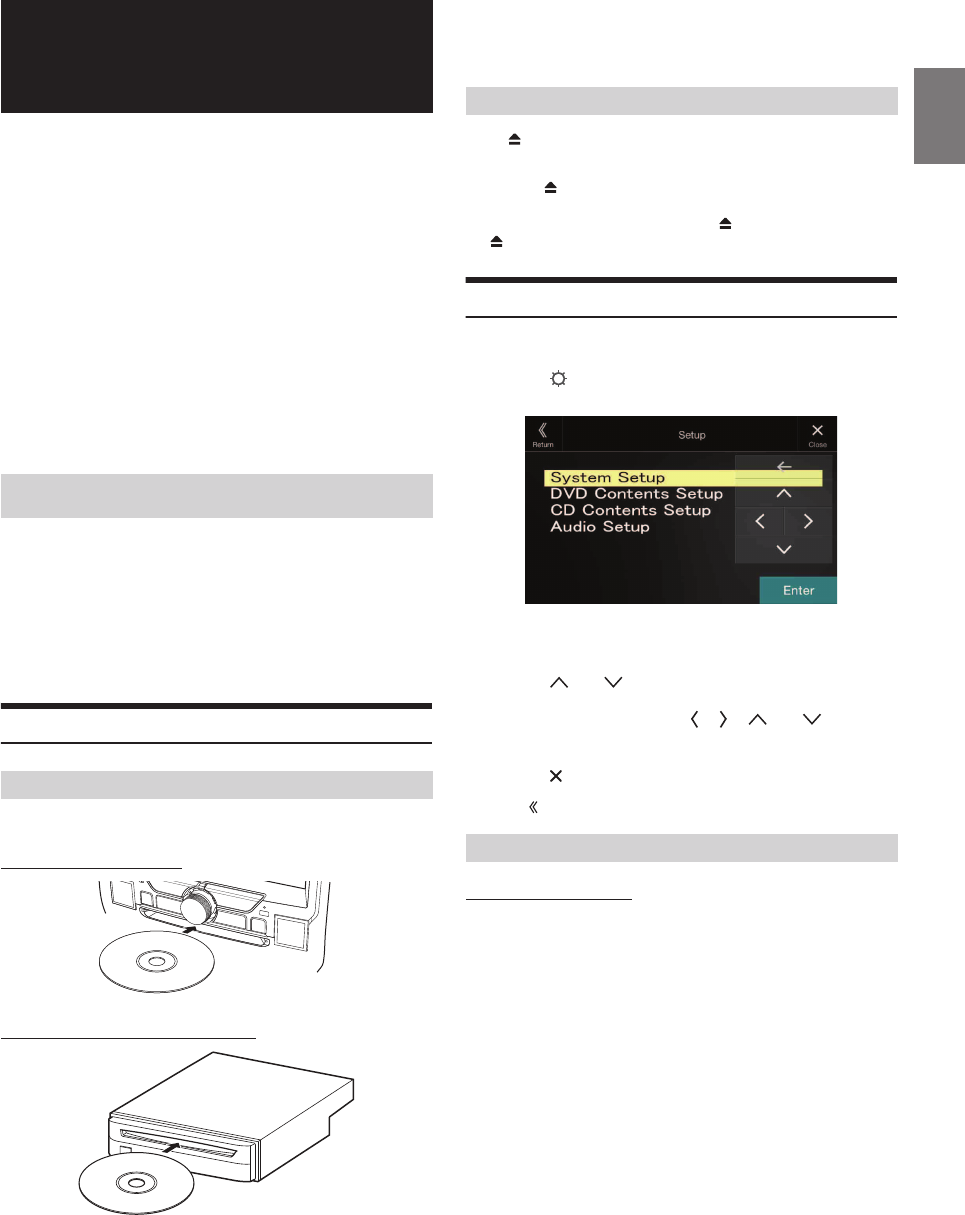
69-EN
Devices supporting HDMI can connect and play back through this unit
(for example, an optional DVE-5300 (DVD Player), iPhone or other
Smartphones). When making HDMI connections, you need to set
HDMI on the unit suitable for the connected device. For details, see
“HDMI Setup” (page 45).
• The HDMI/MHL connecting cable differs depending on the connected
device corresponding to HDMI. Prepare optional HDMI/MHL
connecting cable sets suitable for your device.
When you connect an optional DVE-5300 (DVD Player), you
can operate it from the unit. For details on how to operate
the DVD player, see “DVD Player Operation” (page 69).
For details on how to operate iPhones and Smartphones, see
“HDMI Operation” (page 78).
• The HDMI connector is for use exclusively with a standard DVD
Player. Other HDMI devices (i.e. iPhone, etc.) cannot be used.
You can operate discs using the Remote Control unit supplied with the
DVE-5300 (DVD Player). For detailed notes on handling and operating
the Remote Control unit, see “About Remote Control Operation (X110
with DVE-5300X only)” (page 97).
• For precautions concerning the use of discs, usable discs, and formats,
see “Cautions about Discs (X110 with DVE-5300X only)” (page 99)
and “About the Supported Formats” (page 101).
Inserting/Ejecting a Disc
Insert the disc with the label side facing up.
For X110 with DVE-5300X
For X108U/INE-W967HD (DVE-5300)
Insert the disc until it is automatically pulled into the unit.
• Do not touch the surface of the disc directly with your fingers.
• Before inserting or removing the disc, always turn the ignition key to
ACC or ON.
• You cannot remove or insert the disc with the ignition key turned to
OFF.
Press (Eject) button.
When the disc has been ejected part way, take it out.
• Press the [ ] (Eject) button on the front panel of the optional DVD
Player (DVE-5300).
• If the disc cannot be ejected by pressing [ ] (Eject), press and hold
[ ] (Eject) again for at least 2 seconds.
DVD Player SETUP
You can setup only when a disc is not inserted or playback pauses.
1Touch [ ] (Setup).
The Setup main screen is displayed.
Setting items:
System Setup / DVD Contents Setup / CD Contents Setup / Audio Setup
2Touch [ ] or [ ] to select the setting item.
3Touch [Enter] , then touch [ ], [ ], [ ] or [ ] to
change the setting item.
4Touch [ ] to return to the main source screen.
• Touch [ ] (Return) to return to the previous display.
Switching the Bar Color
Select the colors (8) used for highlighting items in the System Setup
screen.
Setting items:
Bar Color
Setting contents:
Blue / Green / Light blue / Amber (Initial setting) / Aqua blue / Yellow / Red /
White
HDMI Device
(Optional)
DVD Player Operation
Inserting the Disc
Removing the Disc
System Setup
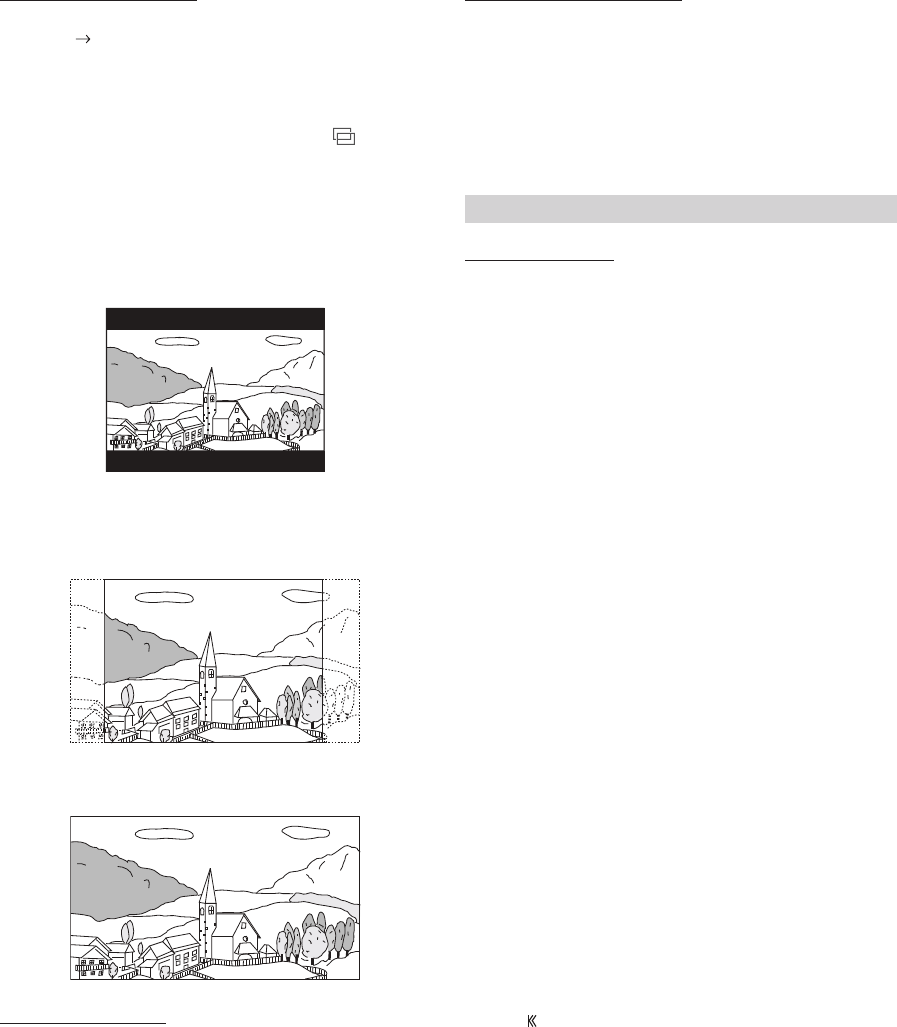
70-EN
Setting the TV Screen Mode
Setting item:
TV Screen Aspect
Setting contents:
16:9 (Initial setting) / 4:3LB / 4:3PS
• For some discs, the picture may not be set to the selected screen size.
(For details, refer to the explanation on the disc’s jacket.)
• You can also switch the TV Screen mode by touching [ ] (Display
Mode) on the display of this unit. For details, see “Switching Display
Modes (During Video File Play Back)” (page 60).
4:3 LETTER BOX:
Select this when connected to a conventional 4:3 size (normal TV
aspect ratio) monitor. There may be black stripes visible at the top
and bottom of the screen (when playing a 16:9 size movie). The width
of these stripes will depend upon the original aspect ratio of the
theatrical release of the movie.
4:3 PAN-SCAN:
Select this when connected to a conventional 4:3 size monitor. The
picture will fill the entire TV screen. However, due to the mismatch in
aspect ratio, parts of the movie at the extreme left and right sides will
not be visible (when playing a 16:9 size movie).
16:9 WIDE:
Select this when connected to a wide screen TV. This is the factory
setting.
Delaying Image Output
Use this function when an external audio processor is connected.
Depending on the connected audio processor, the audio and image
currently played back may not be output at the same time. In this case,
you can output an image delayed by 0.1 second by setting to On.
Setting item:
Video Delay
Setting contents:
Off (Initial setting) / On
• If a disc with a high compression rate is played back, the image and
audio may be distorted.
Returning to the Initial Setting
You can return the contents you previously set to the initial factory
settings.
Setting item:
Setup Initialize
Setting contents:
Yes / No (Initial setting)
Setting the language
The audio language, subtitle language and menu language can be set
according to your preferences.
Once set, this becomes the default language. This function is convenient
when you always want to listen in English. (Not all discs allow changing
the default language. If not, the factory default language applies.)
Setting item:
Languages
Setting contents:
Audio / Subtitle / Menu
Further Setting contents:
Auto (Initial setting) / Off (Subtitle only) / English / French / Japanese /
Italian / German / Swedish / Spanish / Chinese / Russian / Others
• If you change the language setting when the disc is in the unit, the
setting is decided with one of the following operations.
- Disc eject.
- Turn OFF the main unit.
- Switch the source on the head unit.
• To temporarily change the language of the current disc, either do so
from the DVD menu or using the operation described in the section
“Switching the Audio Tracks” (page 77).
• If the disc does not include the selected language, the disc’s default
language is set.
• Languages set upon shipment from the factory:
Audio language : Auto
Subtitle language : Auto
Menu language : Auto
• Touch [ ] (Return) to return to the previous display.
On: Output image is delayed by 0.1 second.
Yes: Returns to the initial setting.
No: Does not returns to the initial setting.
DVD Contents Setup
Audio: Set the audio track language.
Subtitle: Set the language of the subtitles displayed on the
screen.
Menu: Set the language used for the menus (title menu, etc.).
Auto: The disc is played with the audio language or subtitle
language set as the priority language for the disc.
Off: Subtitles are not displayed. (Subtitle only)
Others: Set this to play the disc with a language other than one
of the languages displayed. Touch [Enter], then use the
numeric keypad (“0” to “9”) to input the 4-digit language
code. Then touch [Enter] again. For the language codes,
refer to “List of Language Codes” (page 104).
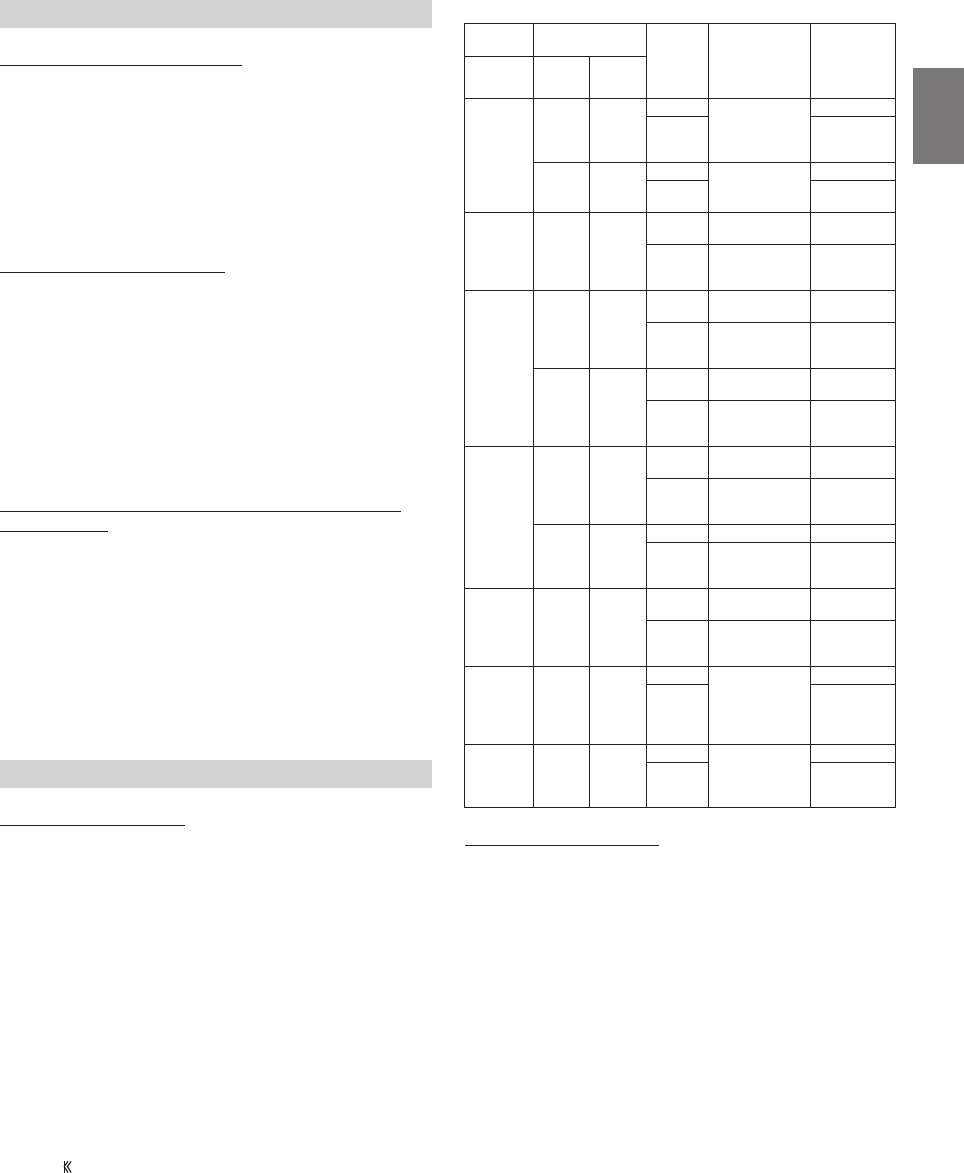
71-EN
Playing MP3/WMA/AAC/WAV Data
Setting item:
CD Play Mode
Setting contents:
CD-DA / Compress (Initial setting)
This unit can play back CDs containing both CD and MP3/WMA/AAC/
WAV data (created in Enhanced CD (CD Extra) format).
Setting the Video CD Play Mode
When playing a Playback Control (PBC) enabled video CD, you can
choose to set PBC On or Off.
Setting item:
VCD Play Mode
Setting contents:
PBC On (Initial setting) / PBC Off
• You can set PBC On or Off directly by pressing MENU.
Displaying the Disc Status Automatically (CD/MP3/WMA/
AAC/WAV only)
When playing a CD/MP3/WMA/AAC/WAV file, you can choose to
display the Disc Status (track number, etc.) automatically.
Setting item:
Audio Display
Setting contents:
Off / On (Initial setting)
Setting the Digital Output
Use the following procedure to set the digital audio signal output from
the DVE-5300 (DVD Player).
Setting item:
Digital Out
Output Modes:
Dolby D / DTS
Setting contents:
Bitstream / LPCM (Initial setting)
• Touch [ ] (Return) will return to the previous screen.
• Set to “LPCM” to connect to the unit.
Digital audio output
Setting the Downmix Mode
This function applies to Dolby Digital, DTS stream sound.
Setting item:
Downmix Mode
Setting contents:
Stereo (Initial setting) / Surround Encoded
CD Contents Setup
CD-DA: Only CD data can be played back.
Compress: Only MP3/WMA/AAC/WAV data can be playedback.
PBC On: The PBC menu is displayed.
PBC Off: The PBC menu is not displayed.
On: The Disc Status is displayed automatically while playing
back.
Off: Disc Status is not displayed automatically while playing
back.
Audio Setup
Bitstream: Select “Bitstream” when you want to connect a digital
audio processor to play Dolby Digital or DTS audio.
When “Bitstream” is selected, the HDMI audio will be
muted. The DVE-5300 (DVD Player) optical output must
be used for the external processor.
LPCM: The audio signal recorded on the disc is converted to 48
kHz/16 bit (for DVDs) or 44.1 kHz (for video CDs and CDs)
linear PCM audio signals for output.
Disc Audio recording
format Digital
output
setting
Optical digital
audio output
(when a digital
audio processor is
connected)
Digital audio
output (HDMI
output)
Format Fs Q
LPCM
(DVD, CD)
48/96kHz 16/20/
24bit
Bitstream LPCM 2ch
Down mix
(48kHz/16bit)
—
LPCM
LPCM 2ch
Down mix
(48kHz/16bit)
44.1kHz 16bit
Bitstream LPCM 2ch
(44.1kHz/16bit)
—
LPCM LPCM 2ch
(44.1kHz/16bit)
Dolby Digital
(DVD) 48kHz 16/18/
20bit
Bitstream Bit stream
(Max 7.1ch) —
LPCM
LPCM Encode
2ch Down mix
(48kHz/16bit)
LPCM Encode
2ch Down mix
(48kHz/16bit)
DTS
(DVD, CD)
48/96kHz 16/20/
24bit
Bitstream Bit stream
(Max 6.1ch) —
LPCM
LPCM Encode
2ch Down mix
(48kHz/16bit)
LPCM Encode
2ch Down mix
(48kHz/16bit)
44.1kHz 16/20/
24bit
Bitstream Bit stream
(Max 5.1ch) —
LPCM
LPCM Encode
2ch Down mix
(44.1kHz/16bit)
LPCM Encode
2ch Down mix
(44.1kHz/16bit)
MPEG1
(DVD, Video
CD)
48kHz 16bit
Bitstream Bitstream
(Max 5.1ch) —
LPCM
LPCM Encode
2ch Down mix
(48kHz/16bit)
LPCM Encode
2ch Down mix
(48kHz/16bit)
44.1kHz 16bit
Bitstream Bit stream —
LPCM
LPCM Encode
2ch
(44.1kHz/16bit)
LPCM Encode
2ch
(44.1kHz/16bit)
MPEG2
(DVD) 48kHz 16bit
Bitstream Bit stream
(Max 5.1ch) —
LPCM
LPCM Encode
2ch Down mix
(48kHz/16bit)
LPCM Encode
2ch Down mix
(48kHz/16bit)
MP3/
WMA/
AAC
8/11.025/
12/16/
22.05/24/
32/44.1/
48kHz
16bit
Bitstream LPCM Encode
2ch (32kHz,
44.1kHz or
48kHz/16bit)
—
LPCM
LPCM Encode
2ch (32kHz,
44.1kHz or
48kHz/16bit)
WAV 44.1kHz 16bit
Bitstream LPCM Encode
2ch
(44.1kHz/16bit)
—
LPCM
LPCM Encode
2ch
(44.1kHz/16bit)
Stereo: Stereo Downmix.
Surround
Encoded:
Surround compatible Downmix.
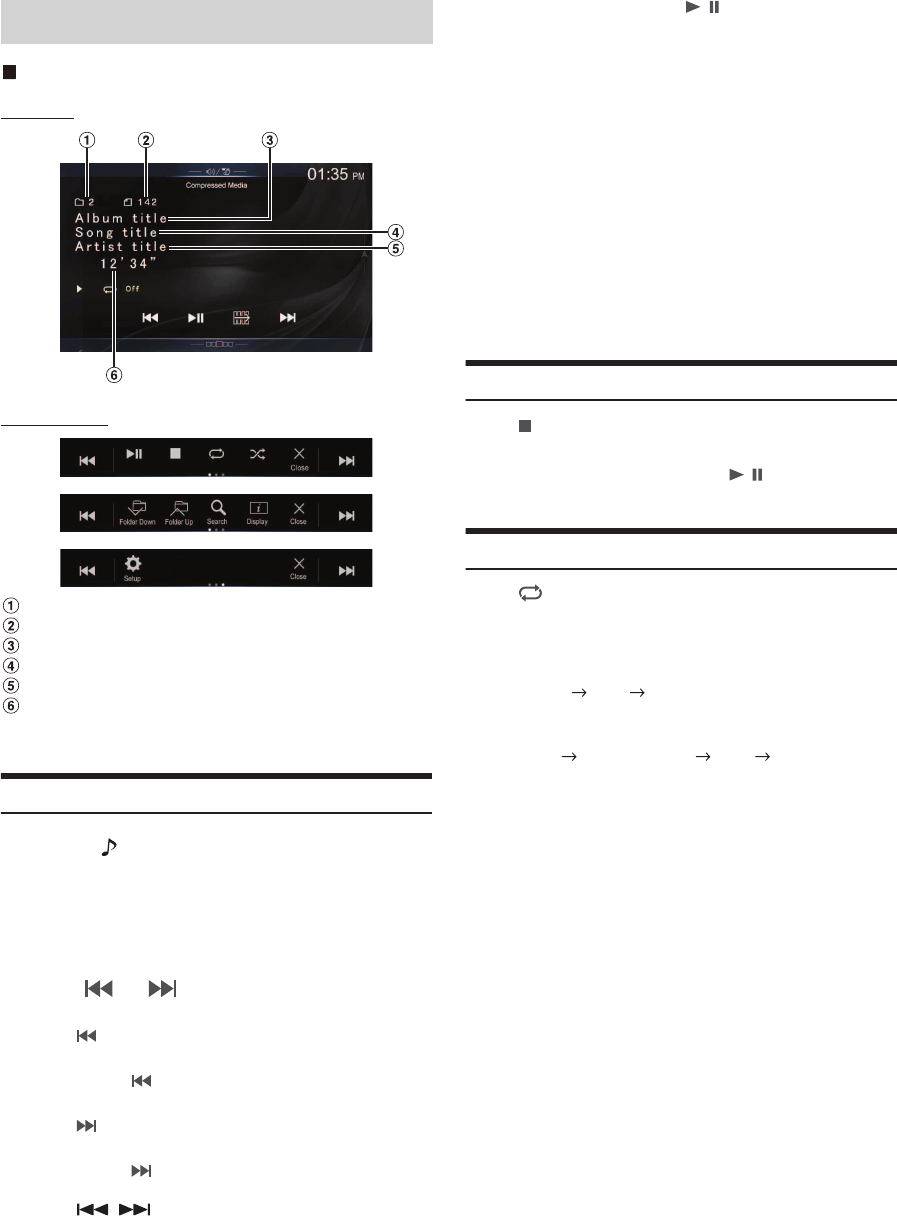
72-EN
MP3/WMA/AAC main screen example
Info mode
Function mode
Current song no.
Total song no.
Album title
Song title
Artist title
Elapsed time
• If there is no CD text, the message “No Text” appears.
Playback
1Press the (AUDIO) button to select DVD (CD) mode.
The display shows the DVD (CD) mode screen.
• You can also select and change from the Menu screen (page 21) or
Favorite screen (page 24).
When a disc is inserted into the disc slot of the DVD Player, with
the label side facing up, the unit starts playback of the disc.
2Touch [ ] or [ ] to select the desired track (file).
Returning to the beginning of the current (or previous) track (file):
Touch [ ].
Fast reverse :
Touch and hold [ ].
Advancing to the beginning of the next track (file) :
Touch [ ].
Fast forward :
Touch and hold [ ].
• The , buttons provide the same functions above.
3To pause playback, touch [ / ].
• The unit can play back MP3/WMA/AAC/WAV files saved to CD or
DVD.
For further information about playing or storing MP3/WMA/AAC/
WAV files, see pages 101 and 102 before using the unit.
• Any file protected by DRM (Digital Rights Management) copy
protection, cannot be played back on this unit.
• If a disc contains both audio data and MP3/WMA/AAC/WAV data,
this unit plays back only the audio data.
• The track display for CD audio data playback shows the track numbers
recorded on the disc.
• If an MP3/WMA/AAC/WAV disc with many files and folders is played,
it may take longer than normal to start playback.
• The playback time may not be correctly displayed when a VBR
(Variable Bit Rate) recorded file is played back.
• For details on switching the HDMI source when you have connected the
HDMI selector and two HDMI devices, see “HDMI Operation” (page
@@).
Stopping Playback
Touch [ ] during playback.
“STOP” indicator is displayed, and playback stops.
• Playback starts from the beginning when [ / ] is touched while
playback is stopped.
Repeat Play
Touch [ ] to repeatedly play back.
The tracks (files) will be played repeatedly.
The repeat mode switches every time the button is touched.
*Only files in a folder are repeatedly played back.
• If the Repeat Play mode is activated during MIX playback, the MIX
mode will be canceled.
CD/MP3/WMA/AAC/WAV
CD:
Track Repeat Off Track Repeat
MP3/WMA/AAC:
Repeat File Repeat Folder* Off Repeat File
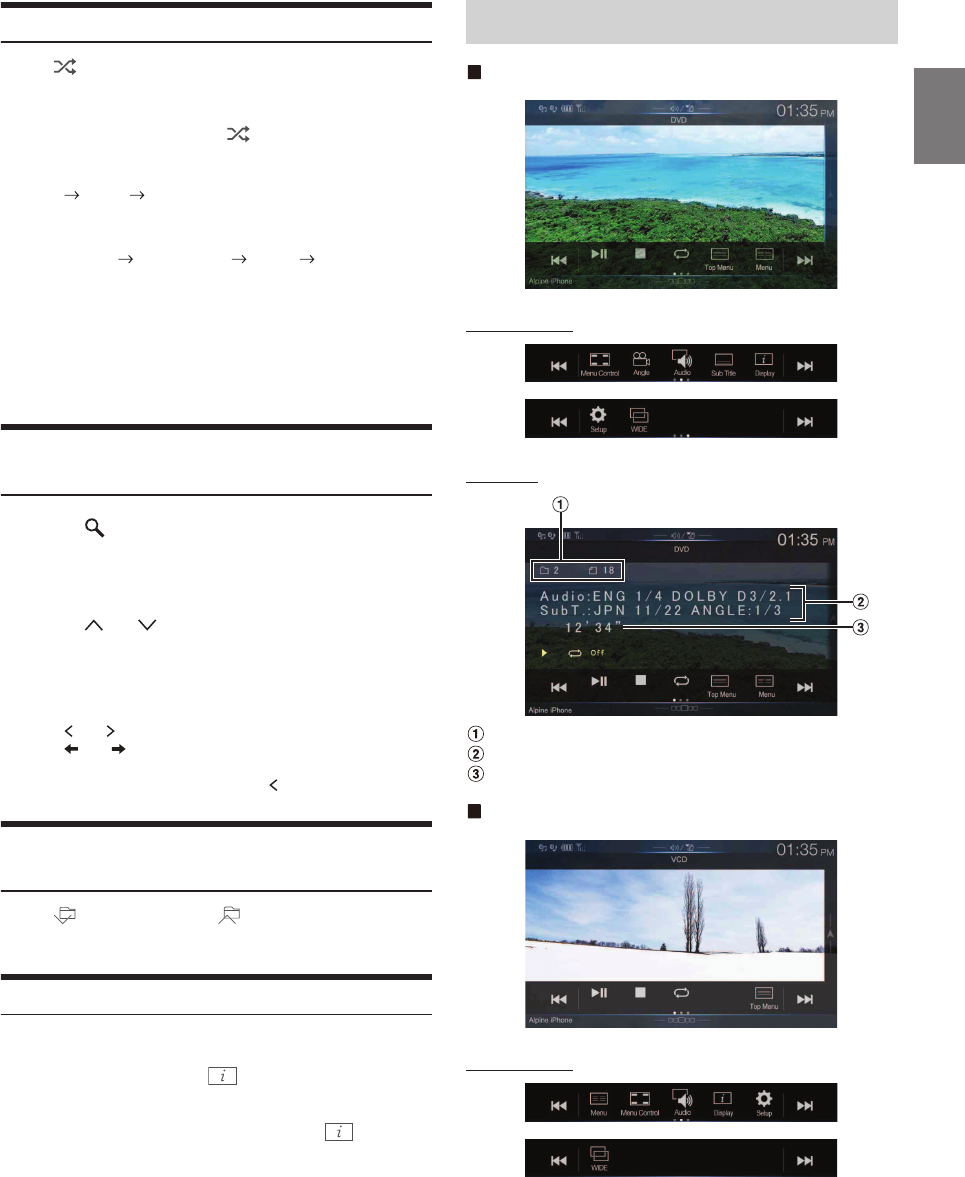
73-EN
MIX (Random Play)
Touch [ ] during playback.
The tracks (files) on the disc will be played back in a random
sequence.
The MIX mode switches every time [ ] is touched.
*1 Only files in a folder are played back in random sequence.
*2 All files on the disc will be played back in a random sequence.
• If the MIX mode is activated during Repeat playback, the Repeat Play
mode will be canceled.
• If you select a track by using the search mode, the MIX play mode will
be canceled.
File/Folder Name Search (Concerning MP3/
WMA/AAC/WAV)
1Touch [ ] (Search) during playback.
The search mode is activated.
The mode is changed to the search mode, and the list select
panel appears.
2Touch [ ] or [ ] in the list select panel to select Folder
or File, then touch [Enter].
When selecting Folder, select File following same procedure,
then touch [Enter].
• When there are 9 or more names on the list, a page number is displayed.
Touch [ ] or [ ] to change the page.
• Touch [ ] or [ ] to change the list select panel location from right to
left or vice-versa.
• To return to the previous hierarchy, touch [ ].
Selecting Folders (Concerning MP3/WMA/AAC/
WAV)
Touch [ ] (Folder Down) or [ ] (Folder Up) to select the
folder.
Info Mode Function
You can display the DISC information.
1During playback, touch [ ] (Display).
The playback status is displayed.
2The playback status display closes when [ ] (Display)
is touched.
• For details on the display example, see Info mode in “MP3/WMA/AAC
main screen example” (page 72).
DVD Video main screen example
Function mode
Info mode
Title no./Chapter no.
Audio signal output/Subtitle/Angle
Elapsed time
Video CD main screen example
Function mode
CD:
MIX Off MIX
MP3/WMA/AAC:
MIX Folder*1MIX Disc*2Off MIX Folder*1
DVD
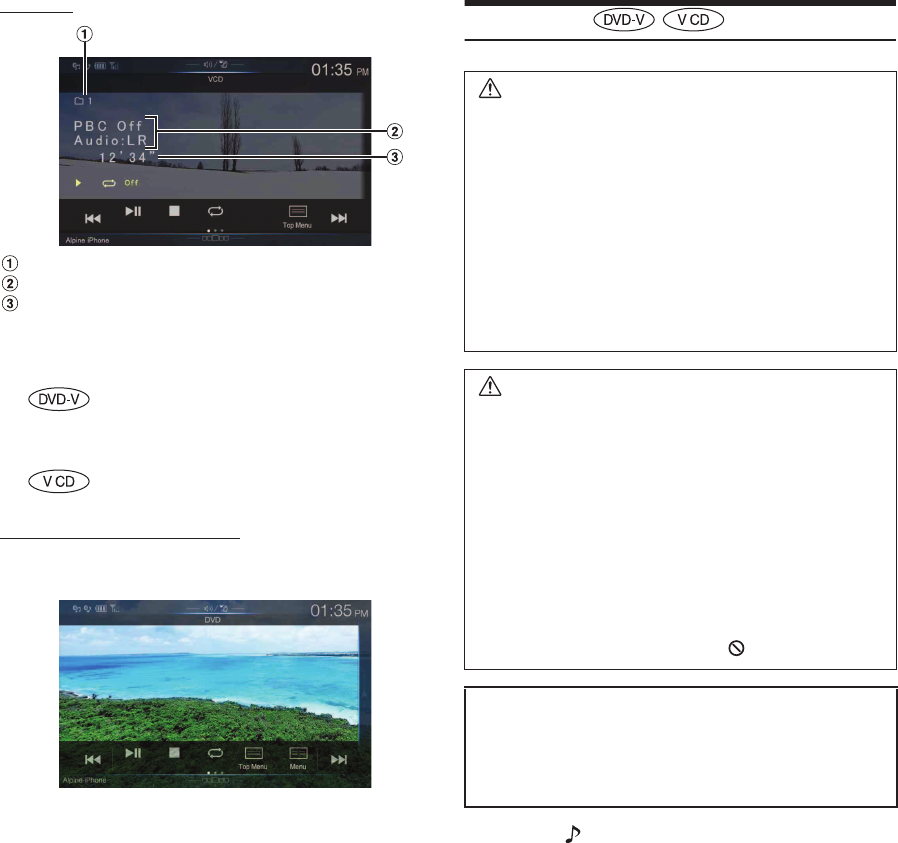
74-EN
Info mode
Current track no.
Playback control (PBC)/Current audio status
Elapsed time
Disc types that can be used for each heading are represented
by the following marks.
The DVD operation screen display
Touch the screen while the DVD playback screen is displayed.
To display the operation screen, touch [Control].
• The operation screen changes to the visual screen in the DVD mode for
5 seconds after an operation has been performed.
• If you try to activate the DVD while driving, the display will show the
warning-Picture off for your safety.
• Some operations cannot be carried out depending on the disc or
playback screen.
Playing a Disc
1Press the (AUDIO) button to select DVD (CD) mode.
The display shows the DVD (CD) mode screen.
When a disc is inserted into the disc slot of the DVD Player, with
the label side facing up, the unit starts playback of the disc.
• The reverse side of a double-sided DVD will not be played
automatically.
Remove the disc, turn it over, and reinsert it.
• DO NOT insert discs containing maps for the navigation system. Doing
so could result in damage.
• For details on switching the HDMI source when you have connected the
HDMI selector and two HDMI devices, see “HDMI Operation” (page
@@).
DVD Commercial Video discs (used for the
distribution of movies, etc.) or a DVD-R/DVD-
RW, DVD+R/DVD+RW recorded in a video mode
can be used.
Video-CD discs can be used.
WARNING
It is dangerous for the driver to watch the DVD while
driving the vehicle. The driver may be distracted from
looking ahead and an accident could occur.
Install the unit correctly so that the driver cannot watch
DVD unless the vehicle is stopped and the emergency
brake is applied.
If the unit is not installed correctly, the driver will be able
to watch DVDs while driving the vehicle and may be
distracted and could cause an accident. The driver or
other people could be severely injured.
CAUTION
• Not all functions will operate for every DVD. See the
individual DVD’s instructions for details on the features
supported.
• Fingerprints on a disc may adversely affect playback. If
a problem occurs, remove the disc and check for
fingerprints on the playback side. Clean the disc if
necessary.
• If you switch the power or Ignition key OFF or change
sources during playback, playback will continue where
you left off when you resume playback.
• If you try to perform an invalid operation (based on the
type of disc being played), the following mark is
displayed on the monitor screen:
• Play Position Memory Function
Even if you turn power off or switch the Ignition key to
OFF during playback or change the source, playback
will continue from the point where playback stopped
when the power is turned ON again.
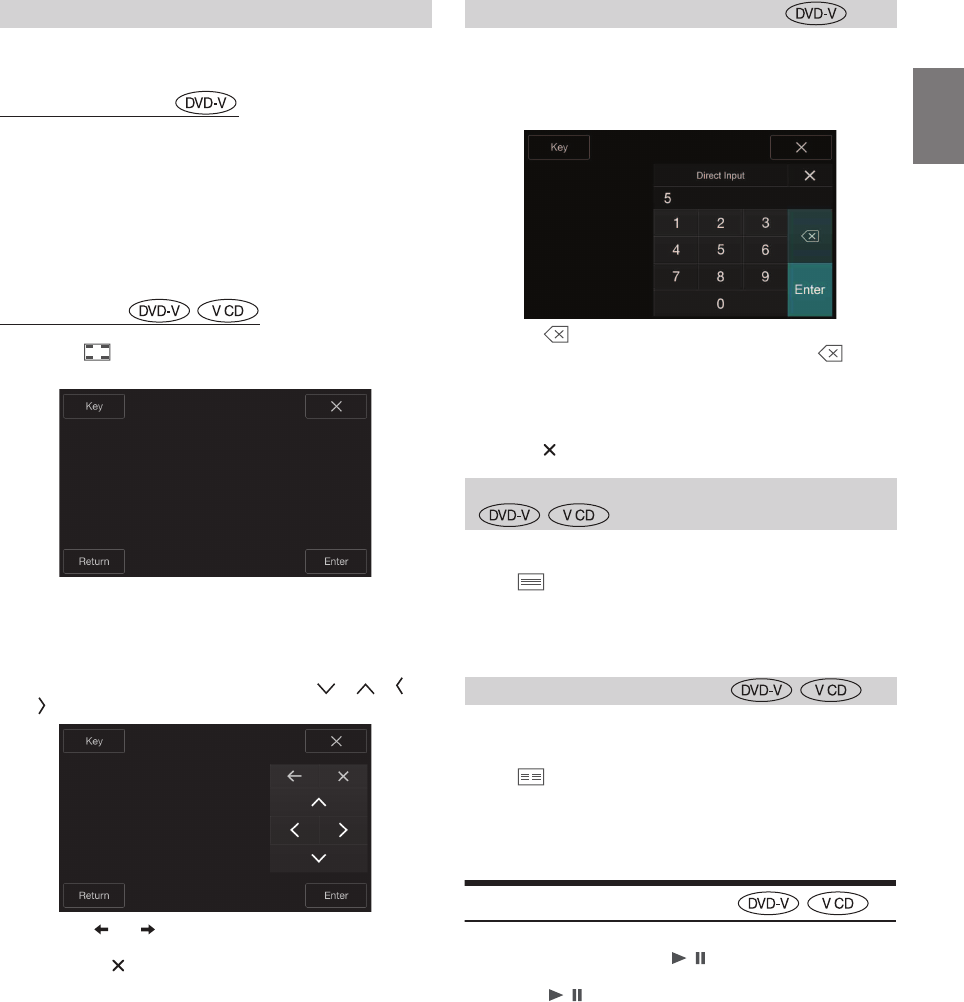
75-EN
On DVD mode, menu screens may appear automatically. If this
happens, perform the operation described below to start playback.
Direct Menu Operations
1Touch the screen while the DVD menu is being
displayed.
Directly touch operation switches displayed on the screen to
operate.
• To display the operation screen, touch [Control].
2Touch the DVD menu directly.
Menu Operations
1Touch [ ] (Menu Control).
The menu operation mode will be displayed.
2Touch [Key].
The Key panel is displayed.
Touch [Return] to return to the previous display.
3Select a desired menu item by touching [ ], [ ], [ ] or
[ ].
• Touch [ ] or [ ] to change the Key panel location from right to
left or vice-versa.
• Touching [ ] in the operation panel returns to the screen in step
1.
• Touching [Key] displays the numeric keypad input mode screen.
For details of the numeric keypad input mode screen, see
“Numeric Keypad Input Operations” (page 75).
4Touch [Enter] to confirm the selected item.
1Touch [key] again in the menu operation mode.
The numeric keypad input mode screen appears
2Touch a desired number.
Touch [ ] to delete an entered number.
To delete all the numbers you have entered, touch [ ] for at
least 2 seconds.
3Touch [Enter] on the numeric keypad input mode screen
to confirm your selection.
Touch [ ] to hide the keypad display.
When a DVD contains two or more titles, the top menu screen appears.
Touch [ ] (Top Menu).
The top menu screen appears.
• To perform necessary operations, see “If a Menu Screen Appears”
(page 75).
With a DVD having two or more menus, a menu screen will appear for
the programmes available, in addition to the main programmes.
Touch [ ] (Menu).
The Root menu screen appears.
• To perform necessary operations, see “If a Menu Screen Appears”
(page 75).
Playing Still Frames (Pausing)
1During playback, touch [ / ].
2Touch [ / ] to resume playback.
• No sound is played during the still frame mode.
• The image or sound may stop temporarily when playback starts from
the pause mode. This is not a malfunction.
If a Menu Screen Appears
• Some operations cannot be performed depending on the disc.
Numeric Keypad Input Operations
Displaying the Top Menu Screen
Displaying the Menu Screen
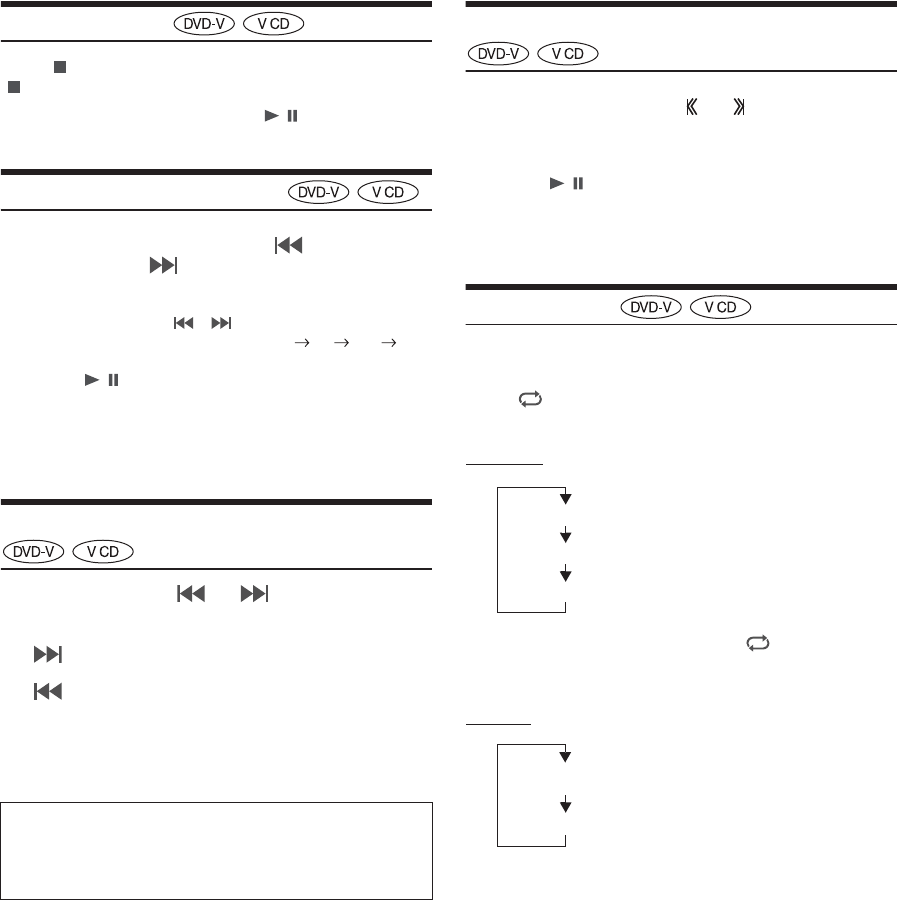
76-EN
Stopping Playback
Touch [ ] during playback.
“ ” indicator is displayed, and playback stops.
• Playback starts from the beginning when [ / ] is touched while
playback is stopped.
Fast-forwarding/Fast-reversing
1During playback, touch and hold [ ] (Fast-reverse) or
touch and hold [ ] (Fast-forward).
Touch and hold for more than 1 second to forward/reverse at
double speed.
Every time you touch [ ]/[ ] during fast- reverse/fast-
forward, the speed changes as follows: 2x 8x 32x 2x.
2Touch [ / ] to return to normal playback.
• No sound is played back during fast-forwarding/fast-reversing.
• On DVD mode, the menu screen may reappear during fast-forwarding/
fast-reversing.
• This operation may not be possible on certain discs.
Finding the Beginnings of Chapters/Tracks/Files
During playback, touch [ ] or [ ].
The chapter/track/file switches each time the button is touched, and
playback of the selected chapter/track/file starts.
• Some DVDs do not have chapters.
• Be sure to turn PBC off before starting the search. See “Setting the Video
CD Play Mode” (page 71).
Forward/Reverse frame-by-frame Playback
1In the pause mode, touch [ ] or [ ].
The picture advances by one frame each time the button is
touched.
2Touch [ / ] to return to normal mode.
• No sound is output during forward frame-by-frame playback.
• You can only execute reverse frame-by frame playback when playing
DVD-V.
Repeat Playback
Use this function to play the disc’s titles, chapters or tracks, etc.,
repeatedly.
Touch [ ] to repeatedly play back.
The repeat mode switches every time the button is touched.
DVD Video
• The Repeat mode is always turned off when [ ] is touched and held
for at least 2 seconds.
• Only discs containing a Playlist can be displayed.
Video CD
• Display may vary depending on the connected devices.
• The track/disc repeat modes cannot be used on Video CDs with
playback control (PBC). These modes can be carried out after turning
PBC off. See “Setting the Video CD Play Mode” (page 71).
• For some discs it is not possible to switch the repeat mode.
: Touch this to start playback from the beginning of the
following chapter, track or file.
: Touch this to start playback from the beginning of the
current chapter, track or file.
Supplementary explanations
“Chapters” are divisions of movies or musical selections on DVDs.
“Tracks” are divisions of movies or musical selections on Video
CD.
The chapter is played repeatedly.
The title is played repeatedly.
Playback returns to normal mode.
Chapter
Title
Off
The track is played repeatedly.
Track
The disc is played repeatedly.Off
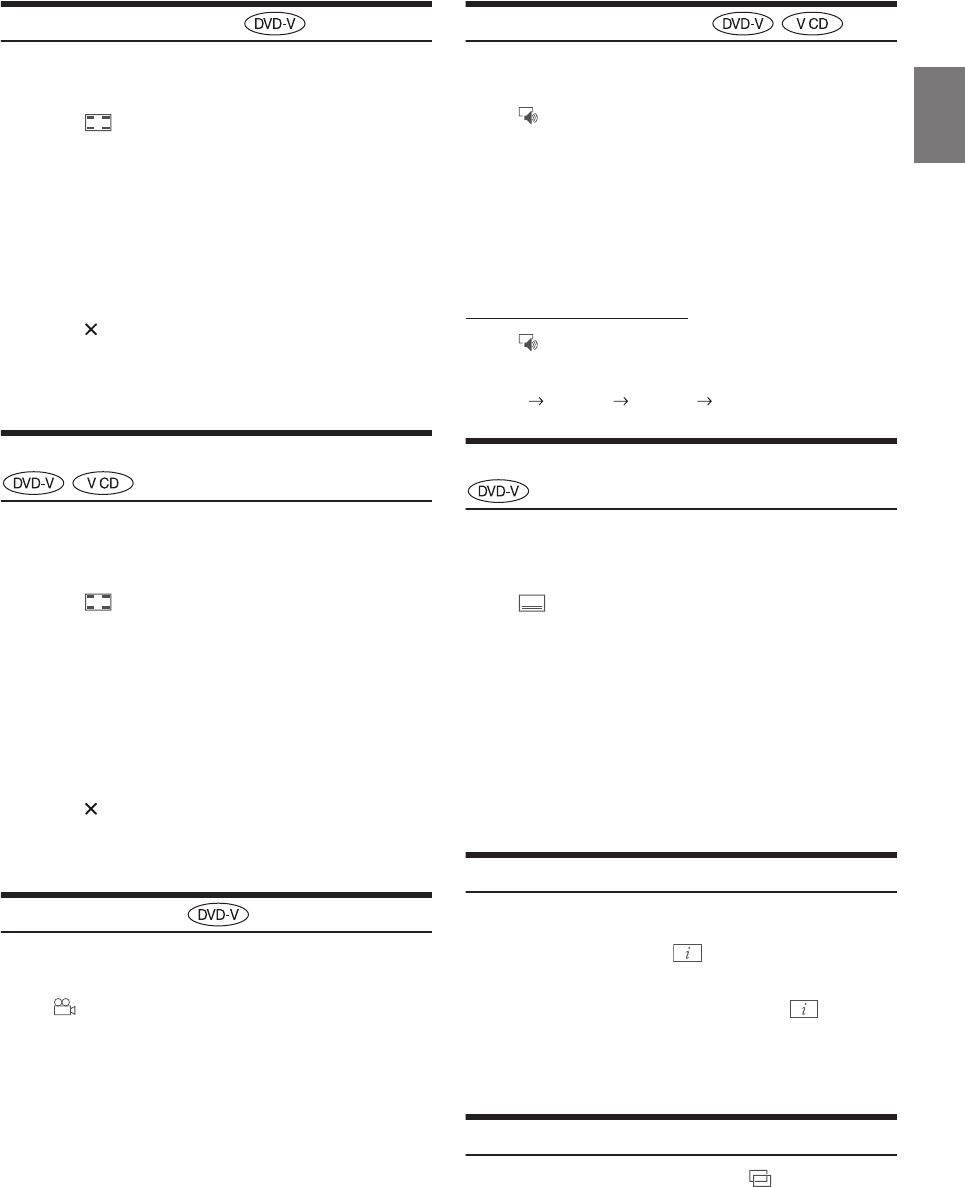
77-EN
Searching by Title Number
Use this function to easily find positions on the DVD using the DVD’s
titles. Perform operations while playback is stopped.
1Touch [ ] (Menu Control).
The menu operation mode screen appears.
2Touch [Key] again in the menu operation mode.
3Enter a desired title by touching its number.
See page 75 for operation of the numeric keypad.
4Touch [Enter].
Playback will start from the number selected.
5Touch [ ].
• This function cannot be used on discs on which no title numbers are
recorded.
• Some disc may not accept any operation.
Searching Directly by Chapter Number
Use this function to easily move to the beginnings of the chapters on the
disc. Perform operations during playback, during PRE-STOP or while
playback is paused.
1Touch [ ] (Menu Control).
The menu operation mode screen appears.
2Touch [Key] again in the menu operation mode.
3Touch and enter the chapter number you want to play.
See page 75 for operation of the numeric keypad.
4Touch [Enter] to confirm your selection.
Playback will start from the selected chapter.
5Touch [ ].
• This function is not available for a disc on which chapters are not
stored.
Switching the Angle
On DVDs in which scenes have been filmed from multiple angles, the
angle can be switched during playback.
Touch [ ] (Angle).
The angle switches between the angles recorded on the disc every
time the button is touched.
• Some time may be required for the angle to change.
• Depending on the disc, the angle may switch in one of two ways.
- Seamless: The angle switches smoothly.
- Non-seamless: When the angle is switched, a still picture is displayed
first, after which the angle switches.
Switching the Audio Tracks
DVDs with multiple audio tracks or languages allow switching the
sound during playback.
Touch [ ] (Audio).
The sound switches between the alternate audio tracks recorded on
the disc every time the button is touched.
• The alternate track selected becomes the default setting every time the
power is turned on or the disc is replaced. If the disc does not include
that track, the disc’s default language is selected instead.
• Not all discs will allow changing the alternate audio tracks during
playback. In these cases, select audio tracks from the DVDs menu.
• There may be a delay before the selected alternate track begins to play.
Video CDs with multiplex audio
Touch [ ] (Audio).
The left and right channels will be output as shown below, each time
the button is touched.
Audio: LL Audio: RR Audio: LR Audio: LR
Switching the Subtitles (Subtitle Language)
With DVDs on which multiple subtitle languages are recorded, the
subtitle language can be switched during playback; moreover, subtitles
can be hidden.
Touch [ ] (Sub Title).
Touching this button repeatedly selects sequentially the subtitle
languages recorded on the disc, and then turns the subtitles OFF.
• There may be a delay before the selected subtitle appears.
• Not all discs will allow changing the subtitles during playback. In these
cases, select subtitles from the DVDs menu.
• The subtitle language selected becomes the default setting every time the
power is turned on or the disc is replaced. If the disc does not include
that language, the disc’s default language is selected instead.
However, the subtitle language may differ depending on the disc.
• For some discs, the subtitles will be displayed even when this is set to
OFF. However, the subtitle language may differ depending on the disc.
Info Mode Function
You can display the DISC information.
1During playback, touch [ ] (Display).
The playback status is displayed.
2The playback status display closes when [ ] (Display)
is touched.
• For details on the display example, see Info mode in “DVD Video/Video
CD main screen example” (pages 73, 74).
Switching Display Modes
You can switch the Display Mode by touching [ ] (Display Mode).
For details, see “Switching Display Modes (During Video File Play
Back)” (page 60).
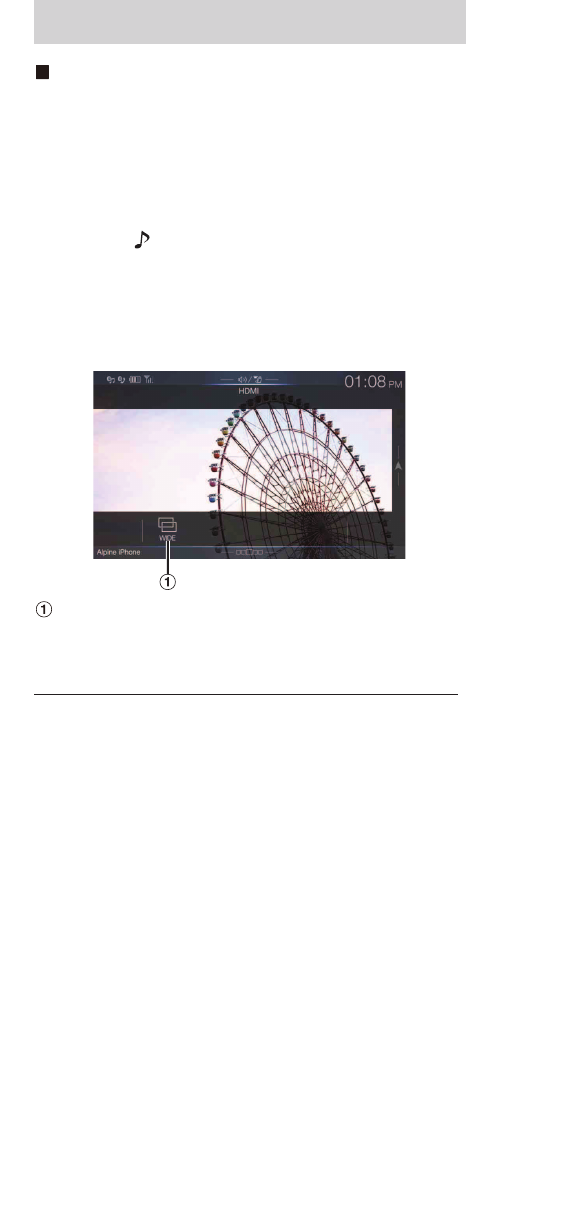
78-EN
iPhone, Smartphone, etc.
The output of your electronic device will be mirrored on this unit
through the HDMI connector. Control from this unit is not possible.
• The electronic device must possess an HDMI output interface.
• Not all devices with an HDMI output interface can be recognized by
this unit.
• Use only the Alpine Special HDMI connection cable.
1Press the (AUDIO) button to select HDMI mode.
The display shows the HDMI mode screen.
• You can select and change the source in the Menu screen (page 21)
or Favorite screen (page 24).
2In HDMI player mode, the screen of the device displays
the content of electronic equipment by mirror image.
You can select Display Mode.
For details, see “Switching Display Modes (During Video File Play
Back)” (page 60).
Switching the source when two HDMI devices are connected
You can switch the source only when you have connected the HDMI
selector and “Setting the HDMI selector On/Off ” is set to “On.”
Screen example when the HDMI Setup is “HDMI 1”
Touch [ ] (HDMI 2).
The HDMI source changes to HDMI 2, and the Function button
changes to [ ] (HDMI 1).
Each time you touch [ ] (HDMI 1)* or [ ] (HDMI 2), the HDMI
source changes.
*When HDMI Setup is “DVD,” the Function button is changed to [ ]
(DVD).
HDMI Operation
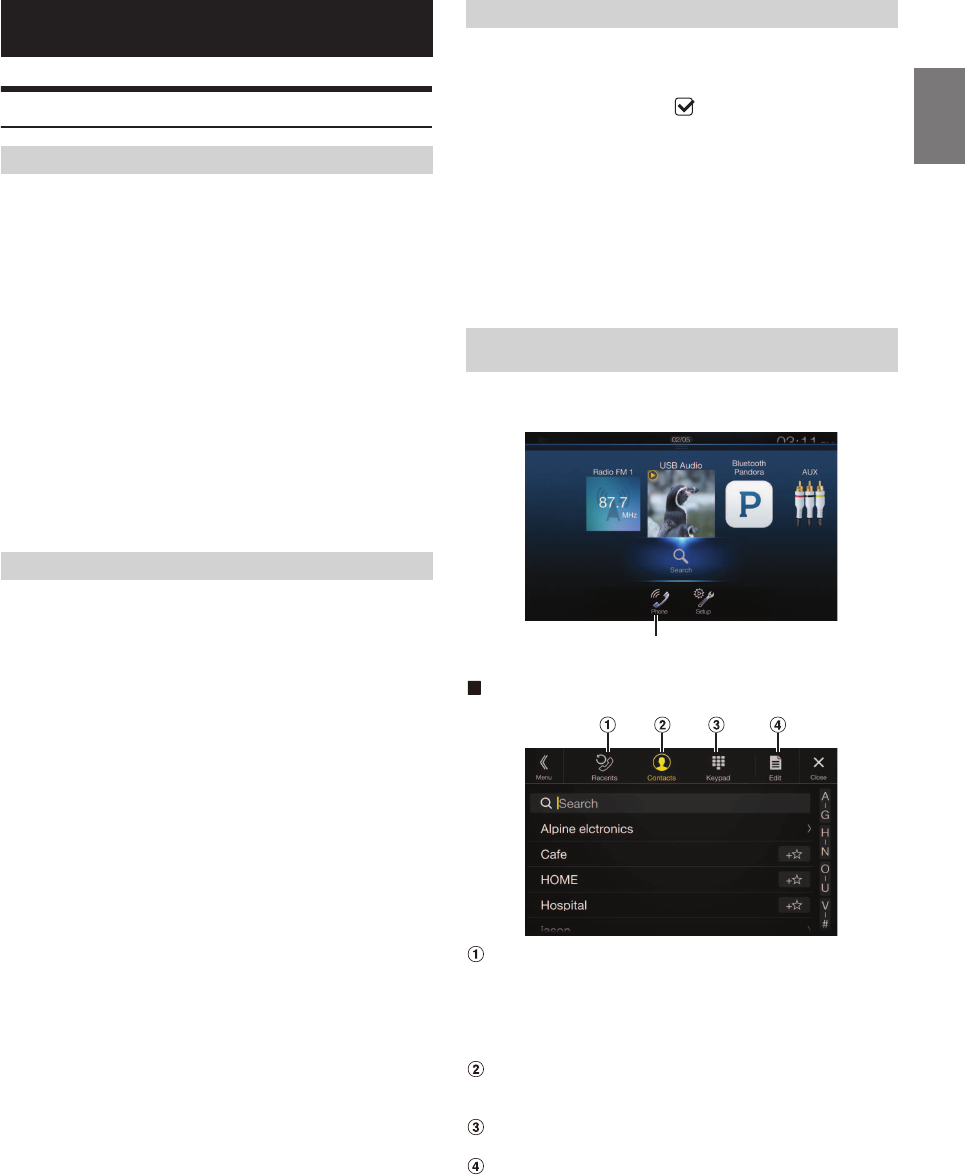
79-EN
Setup Before Using
Bluetooth is a wireless technology allowing communication between a
mobile device or personal computer over short distances. This enables a
hands-free call or data transmission between Bluetooth compatible
devices. Bluetooth transmission is available in the unlicensed 2.4 GHz
spectrum if the distance between devices is within 10 meters. For details,
refer to the Bluetooth website (http://www.Bluetooth.com/).
• Depending on the Bluetooth version, a Bluetooth compatible device
may not be able to communicate with this unit.
• Proper function of this unit with all Bluetooth compatible devices is not
guaranteed. For handling of the Bluetooth compatible device, consult
your Alpine dealer or Alpine website.
• Depending on the surroundings, Bluetooth wireless connection may be
unstable.
• When you place a call, or perform setup operations, be sure to stop your
car in a safe place.
• Depending on the connected Bluetooth compatible device(s), the
function may differ. Also refer to the Owner’s Manual of the connected
device(s).
Hands-free calls are possible when using a HFP (Hands-Free Profile)
compatible mobile phone with this unit.
• Avoid performing a hands-free call in heavy traffic or on narrow or
winding streets.
• Close the windows while calling to reduce background noise.
• If both calling parties are using hands-free devices, or the call is made in
a noisy location, difficulty hearing the other person’s voice is normal.
• Depending on telephone line conditions or certain mobile devices used,
voices may sound unnatural.
• When using a microphone, speak as directly as you can into the
microphone to obtain the best sound quality.
• Certain mobile phone features are dependent on the capabilities and
settings of your service provider’s network. Additionally, certain features
may not be activated by your service provider, and/or the provider’s
network settings may limit the feature’s functionality.
Always contact your service provider about feature availability and
functionality.
All features, functionality, and other product specifications, as well as
the information contained in the Owner’s Manual are based upon the
latest available information and are believed to be accurate at the time
of printing.
Alpine reserves the right to change or modify any information or
specifications without notice or obligation.
Before using the hands-free phone/audio function, the following
settings need to be made.
1Set “Bluetooth” to “On” ( ).
2Register a Bluetooth device in this unit (page 30).
• See “Bluetooth Setup” (page 30).
• You can search for this unit using a Bluetooth compatible device, and
then connect that Bluetooth compatible device to this unit. The device
name of this unit is “ALPINE NAVI” and the initial number of the
passcode is “0000.” Also refer to the Owner’s Manual of the connected
device(s).
• Before using the hands-free function, make sure “Setting the Hands-free
Connection” (page @@) is set to “Aftermarket.”
Touch [Phone] in the Menu screen to display the Phone menu screen
(page 79).
Phone menu screen example
Recent Events list*
You can display up to 60 items, such as phone numbers of the
most recent incoming calls, missed calls and outgoing calls, and
contact names that are registered in the Phone Book. When 60
items exist in the list, the oldest item is deleted when a further
item is to be added.
Contacts list*
You can make a phone call from the Phone Book, or edit the
Phone book.
Keypad screen
Use to type a phone number.
Edit*
Use to edit the Contacts list.
*When you connect two Hands-Free Phones, the information of the
Bluetooth device set to Priority1 is displayed.
Bluetooth Operation
About Bluetooth
About the Hands-free Phone
Before Using Bluetooth
Hands-free Phone Control
[Phone] button
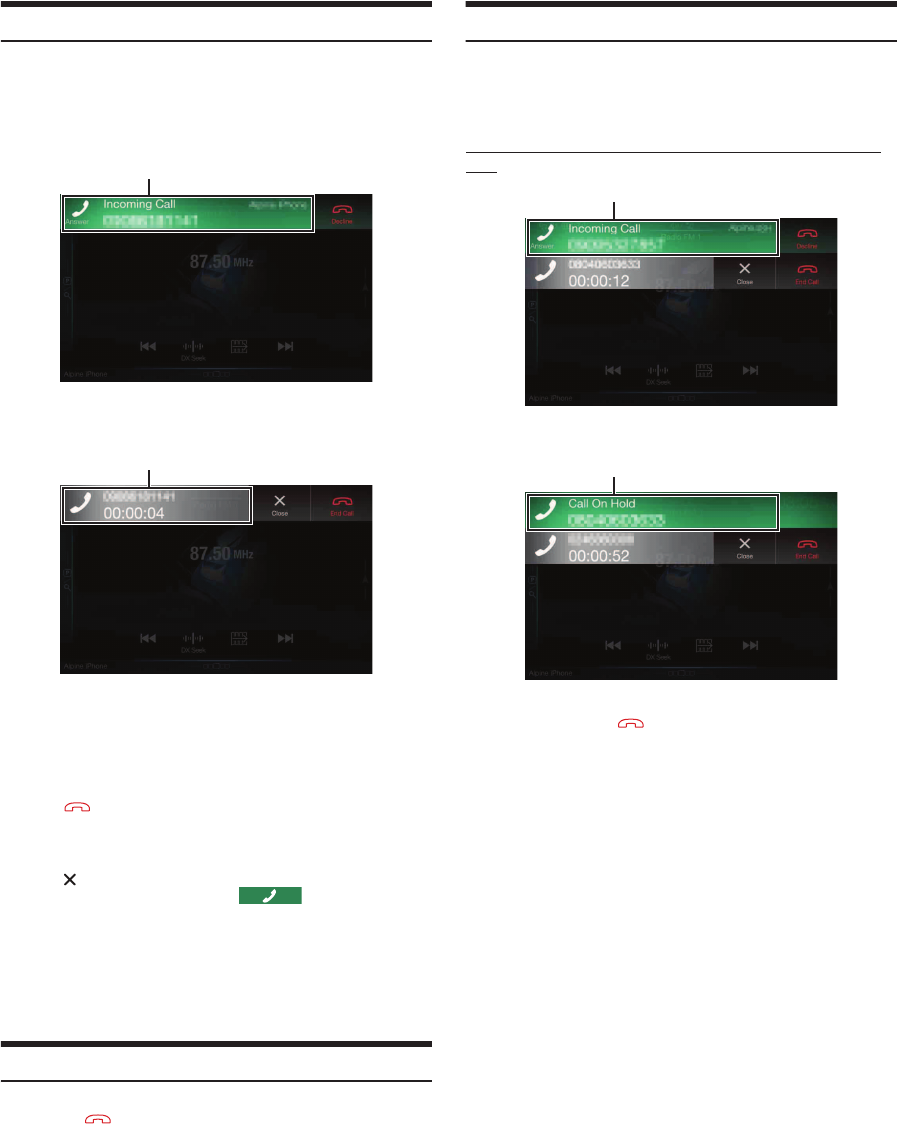
80-EN
Answering a Call
Incoming calls are announced by the received call ring tone and a
displayed message (PHONE No., etc.).
1An incoming call triggers the ringtone and an incoming
call display.
2Touch incoming call notification screen.
The call starts.
• During a call, the audio for the current mode on the unit is muted. After
calling, playback will resume.
• When the caller’s number is transmitted to the system, if the caller’s
name is stored in the phone book, the name is displayed. If the name is
not stored, the number is displayed. When neither the name or the
number is unavailable, “Unknown” is displayed.
• Touch [ ] (Decline) to reject an incoming call.
• By touching the call info area during phone call, you can change to the
Phone Operation screen and adjust the speech volume, etc. For details,
see “Operations During a Conversation” (page 83).
• Touch [ ] during a conversation to hide the call info area. To display it
again, Touch or swipe downward on [ ] on the upper part of
the screen.
• During an incoming call or a conversation on the Priority1 (Priority2)
Hands-Free Phone, if there is an incoming call on the Prority2
(Priority1) Hands-Free Phone, you cannot answer the call on the
Prority2 (Priority1) Hands-Free Phone without first ending the call on
the Prority1 (Priority2) Hands-Free Phone.
Hanging up the Telephone
1Touch [ ] (End Call).
The call finishes.
Call Waiting Function
If a call comes in from another phone during a call, a notice is displayed
on the screen. This function can only be used if the connected mobile
phone has a call waiting function service included.
Second incoming call during a conversation in the call info
area
By touching the second incoming call notification screen, you can put
the current call on hold and answer the second call.
• To switch a party, touch the on-hold screen.
• To finish a call, touch [ ] (End Call).
Incoming call notification screen
Call info area
Second incoming call notification screen
On-hold screen
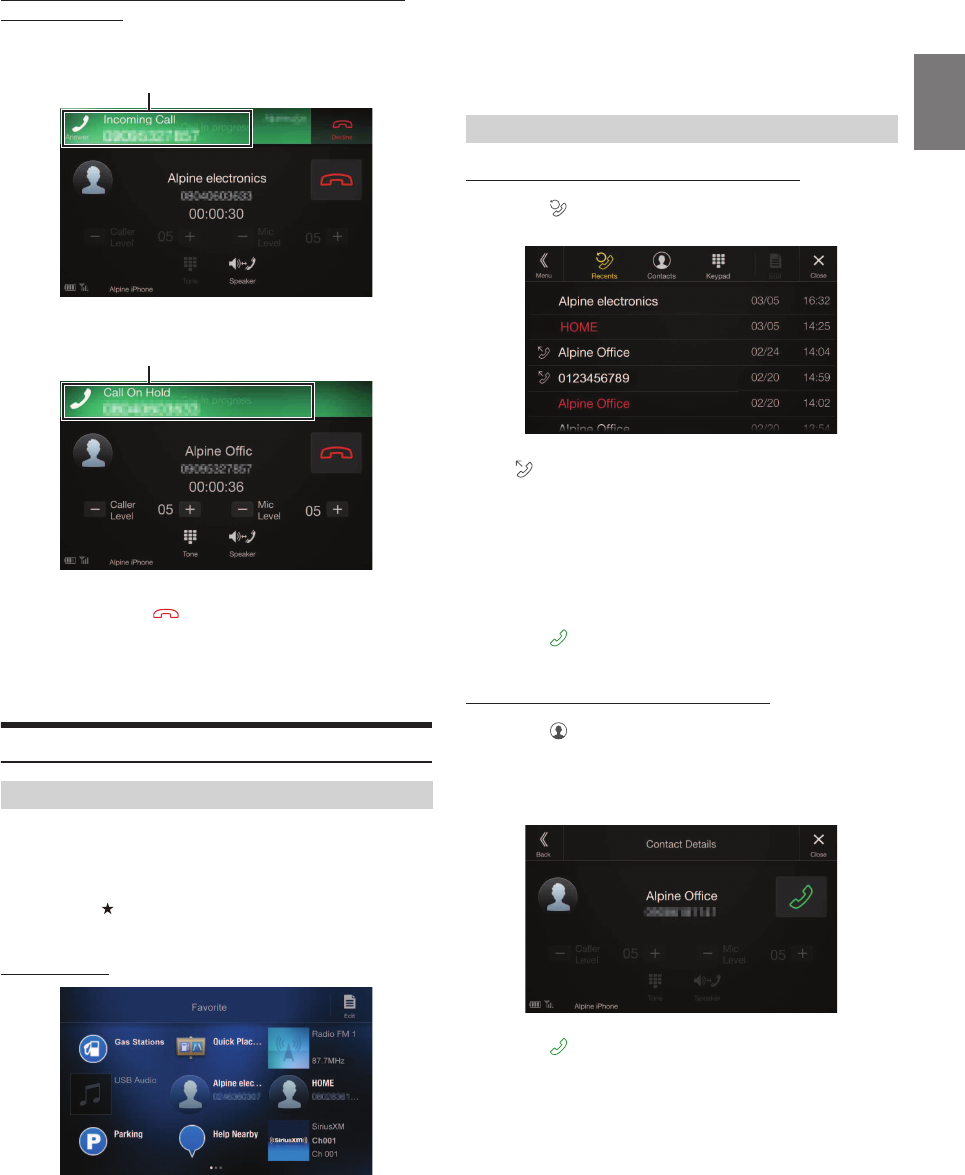
81-EN
Second incoming call during a conversation in the Phone
Operation screen
• The display or operation may differ depending on the connected mobile
phone or the caller’s mobile phone.
By touching the second incoming call notification screen, you can put
the current call on hold and answer the second call.
• To switch a party, touch the on-hold screen.
• To finish a call, touch [ ] (End Call).
• This unit supports only the Call Waiting function of a mobile phone.
The second call function and three-way calling function of a mobile
phone cannot be operated from this unit. Also the screen display may
malfunction.
Calling
You can make a phone call using the Short Cut function of numbers that
have been registered in Favorite. For details, see “Favorite Function”
(page 24).
1Press the (Favorite) button.
The Favorite screen is displayed.
Favorite screen
2Touch the Short Cut icon.
A contact’s name, phone number, and a confirmation message
of the phone number are displayed.
3Touch [Call].
The phone call is started.
Making a phone call from the Recent Events list
1Touch [ ] (Recents) to change to the Recent Events list
screen.
Dialled history:
Names or Numbers/Date
Received history:
Names or Numbers/Date
Missed Incoming history:
Names or Numbers/Date
2Touch the name of the contact you want to call.
The Detail info screen is displayed.
3Touch [ ].
The phone call is started.
Calling from the Contacts list (Phone Book)
1Touch [ ] (Contacts) to change to the Contacts list
screen.
2Touch the name of the contact you want to call.
The Phone Operation screen is displayed.
3Touch [ ].
The phone call is started.
Calling by Favorite Function
Second incoming call notification screen
Call On Hold screen
Making a phone call using the Phone Menu
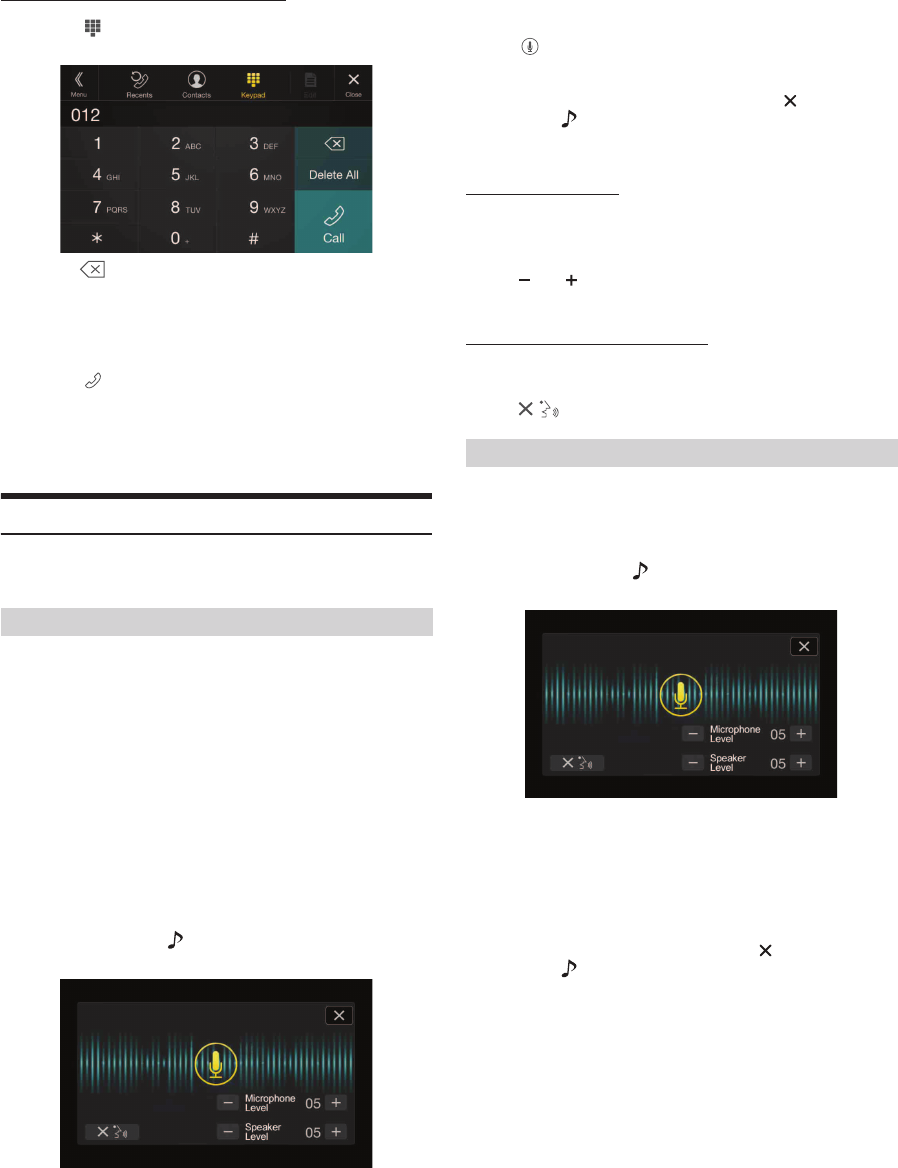
82-EN
Entering a Phone Number to Make a Call
1Touch [ ] (Keypad).
The number input screen (Keypad) appears.
Touch [ ] to delete an entered number.
Touch [Delete All] to delete all entered numbers.
2Enter the phone number you wish to call.
• You can enter up to 31 digits.
3Touch [ ] (Call).
A confirmation message of the phone number appears.
4Touch [Call].
The phone call is started.
Using Voice Recognition function
You can use Siri function of your iPhone or make a telephone call by
using voice operation of your smartphone.
You can use the Siri function of your iPhone. To use this function, set
the Siri setting of your iPhone to ON.
• Connect your iPhone to the unit via Bluetooth, then set to “Hands-free”
or “Both” (page 30).
• The available functions differ depending on the connected iPhone.
• Ask Siri to play a track from the music library applies only to USB
source.
• Siri and other streaming services are enabled by connecting to
compatible smartphones that are able to receive data. Please ensure that
cellular data and/or Wi-Fi is turned on in the smartphone to enjoy
these features.
• Extensive use of Siri or other streaming services may increase your
phone’s data usage. Please check with your phone company to ensure
you have an appropriate Data plan.
1Press and hold the (AUDIO) button for at least 2
seconds.
The Voice Control mode screen is displayed.
2Speak into the microphone supplied with this unit.
• If no speech is detected, the unit may pause depending on version
of the connected iPhone. In that case, touch the microphone icon
[ ] in the center of the Voice Control mode screen. You can
continue to use the Voice Control mode.
3To finish the Voice Control mode, touch [ ] or press and
hold the (AUDIO) button for at least 2 seconds.
• Depending on the iPhone, the Siri function may finish automatically.
Adjusting the volume
Adjust the speaker/microphone volumes in Voice Control mode.
Perform the same procedure to adjust the speaker/microphone volumes
of hands-free phone.
Touch [ ] or [ ].
Adjust the speaker and microphone volumes.
Stopping input to the microphone
If the surrounding sound (road noise, etc.) is loud, you may wish to cut
input to the microphone for 3 seconds.
Touch [ ].
You can make a telephone call by using voice operation.
• Connect your smartphone to the unit via Bluetooth, then set to “Hands-
free” or “Both” (page 30).
1Press and hold the (AUDIO) button for at least 2
seconds.
The Voice Dial mode screen is activated.
2Say the telephone number* or name* you want to call,
into the microphone.
*The number and name depend on the voice dial information stored
in the smartphone.
3To finish the Voice Dial mode, touch [ ] or press and
hold the (AUDIO) button for at least 2 seconds.
• You can perform this operation only when a voice dial compatible
smartphone is connected.
• The Voice Dial function performance depends on the recognition range
of the smartphone and mounting location of the microphone.
Note when the microphone is mounted.
• Voice dial operation depends on the function being available on the
smartphone. For details, refer to the owner’s manual of the smartphone.
• Depending on the smartphone, the Voice Dial operation may finish
automatically.
Using Siri
Voice Dial Function
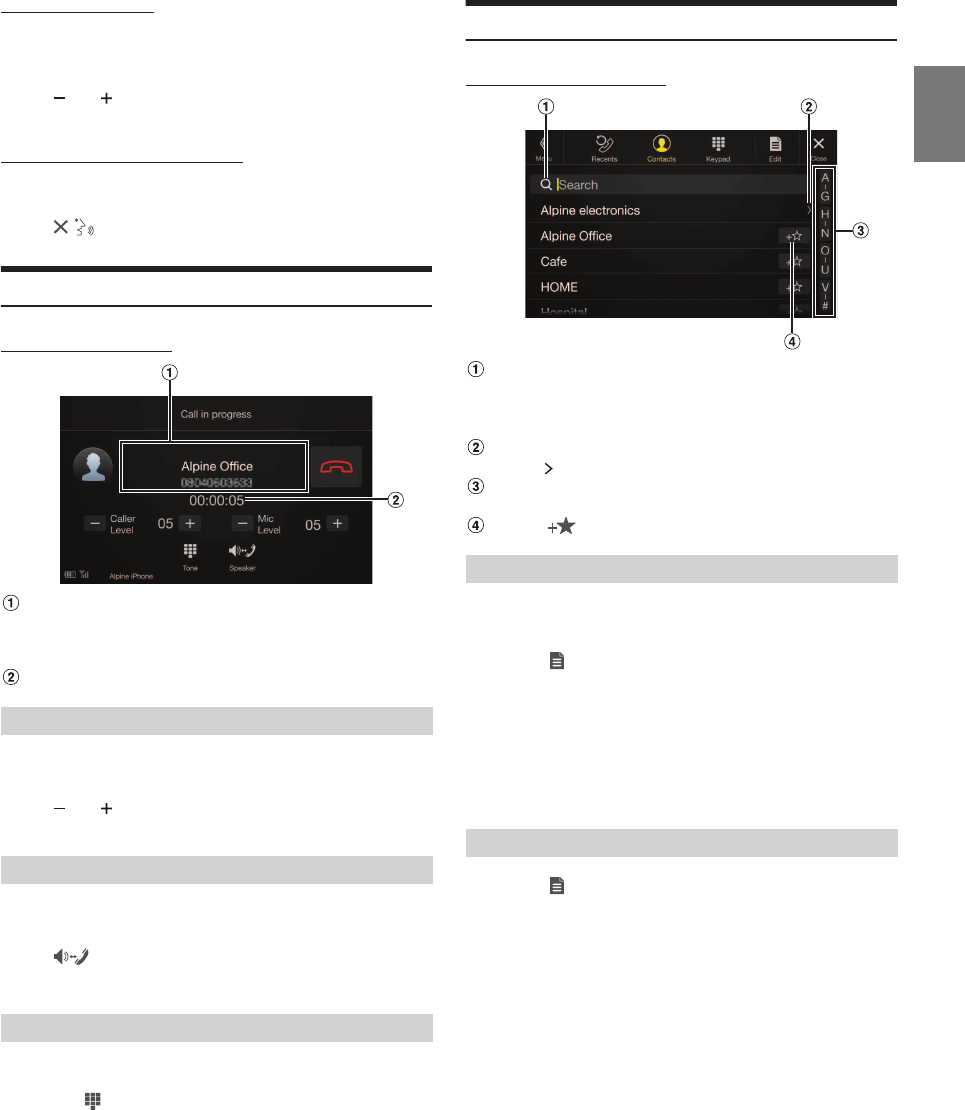
83-EN
Adjusting the volume
Adjust the speaker/microphone volume in Voice Dial mode. Perform
the same procedure to adjust the speaker/microphone volume of hands-
free phone.
Touch [ ] or [ ].
Adjust the speaker and microphone volumes.
Stopping input to the microphone
If the surrounding sound (road noise, etc.) is loud, you may wish to cut
input to the microphone for 3 seconds.
Touch [ ].
Operations During a Conversation
Phone Operation screen
Name and phone number
• If registered with a Group, the Group Name is also displayed.
Although, depending on the connected mobile phone, it may not
be displayed.
Conversation time
You can adjust Caller Level and Mic. Level (Microphone Level) during a
phone call.
Touch [ ] or [ ].
You can adjust the volume in 11 levels.
The voice output for calls is switchable between car speakers and the
mobile phone speaker.
Touch [ ].
• Depending on the mobile phone, this operation may not be possible.
Transmits a DTMF (Touch-Tone) during a call.
1Touch [ ] (Keypad).
The number input screen (Keypad) appears.
2Input number.
• You can transmit a Touch-Tone signal during a call.
Phone Book Function
Phone Book screen example
Use to search by directly inputting a name or phone number
with the Keypad.
For details, see “How to Input Characters and Numbers
(Keypad)” (page 23).
Displayed when multiple phone numbers are registered.
Touch [ ] to display the registered phone number list.
Use to narrow down your search for names, etc.
For details, see “Alphabet Search Function” (page 59).
Touch [ ] to register as Favorite.
You can synchronize the system’s phone book with the mobile phone’s
phone book.
1Touch [ ] (Edit).
2Touch [Download].
3Touch [SYNC].
Synchronization of the phone books starts.
• You can store up to 1,000 registered name in the phone book.
• You can store up to 5 phone numbers by one person’s name.
1Touch [ ] (Edit).
2Touch [Download].
3Touch [Add].
Stays on standby for connection of the mobile phone.
• Touch [Cancel] to cancel the standby mode.
4The mobile phone accesses this unit and then transfers
the phone book from the mobile phone to this unit.
• Mobile phone connection is canceled while the phone book is being
transferred.
Adjusting the Speech Volume
Changing the Voice Output
DTMF (Touch-Tone) Function
Synchronizing the Phone Book
Adding the Phone Book
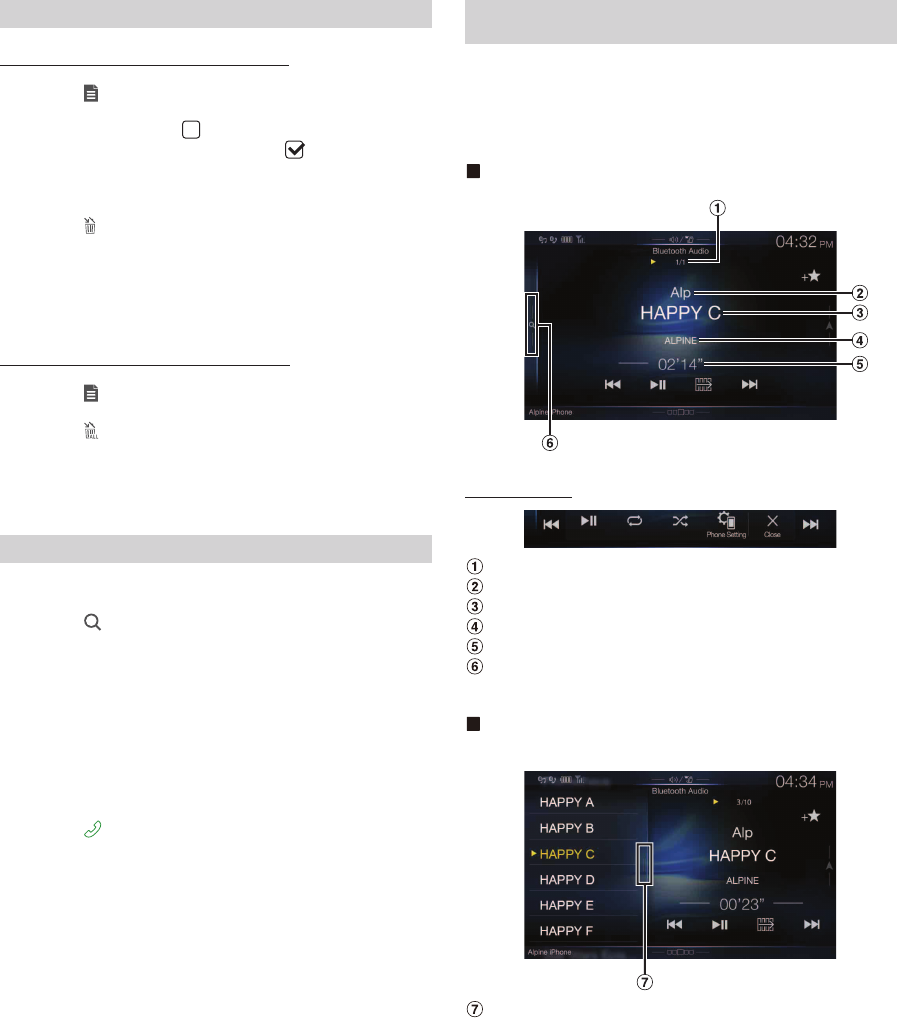
84-EN
Deleting One Entry from the Phone Book
1Touch [ ] (Edit).
2Touch the checkbox [ ] of the contact name (or phone
number) you want to delete. A tick ( ) appears in the
checkbox.
• You can choose up to 10 names and numbers at a time.
3Touch [ ] (Delete).
The confirmation screen is displayed.
If multiple phone numbers are registered, they are all deleted.
4Touch [OK].
The selected number is deleted.
Deleting All Entries from the Phone Book
1Touch [ ] (Edit).
2Touch [ ] (Delete All).
The confirmation screen is displayed.
3Touch [OK].
All entries of the phone book are deleted.
You can make a call using the phone book search function.
1Touch [ ] (Search).
The Input User Name screen (Keypad) is displayed.
2Input the string of letters of the name that you want to
search, then touch [OK].
A list of names beginning with the string of letters you entered is
displayed.
3Touch the name you want to call.
The Phone Operation screen is displayed.
4Touch [ ].
The phone call is started.
• For details of how to input characters using the keypad, see “How to
Input Characters and Numbers (Keypad)” (page 23).
• If there are fewer than five registered items in the phone book, you
cannot use the phone book search function.
If a Bluetooth compatible mobile phone, portable player, etc. is
connected by wireless, you can play back a song (operation is
controllable from the unit).
• Operation may vary, depending on the Bluetooth compatible device.
Bluetooth Audio main screen example
Function mode
Current track no./Total song no.
Artist title
Song title
Album title
Elapsed time
Touch or swipe to the right to use the Quick Search mode
and Full Search mode.
Quick Search mode screen example
Swipe vertically in the list to change pages.
Full Search button
Swipe to the right when using Full Search mode.
• The displayed onscreen buttons may differ depending on the AVRCP
version.
• Song title/Artist title/Album title/Elapsed time do not display for
AVRCP Ver. 1.0.
Deleting the Phone Book Entries
Searching in the Phone Book
Bluetooth Audio
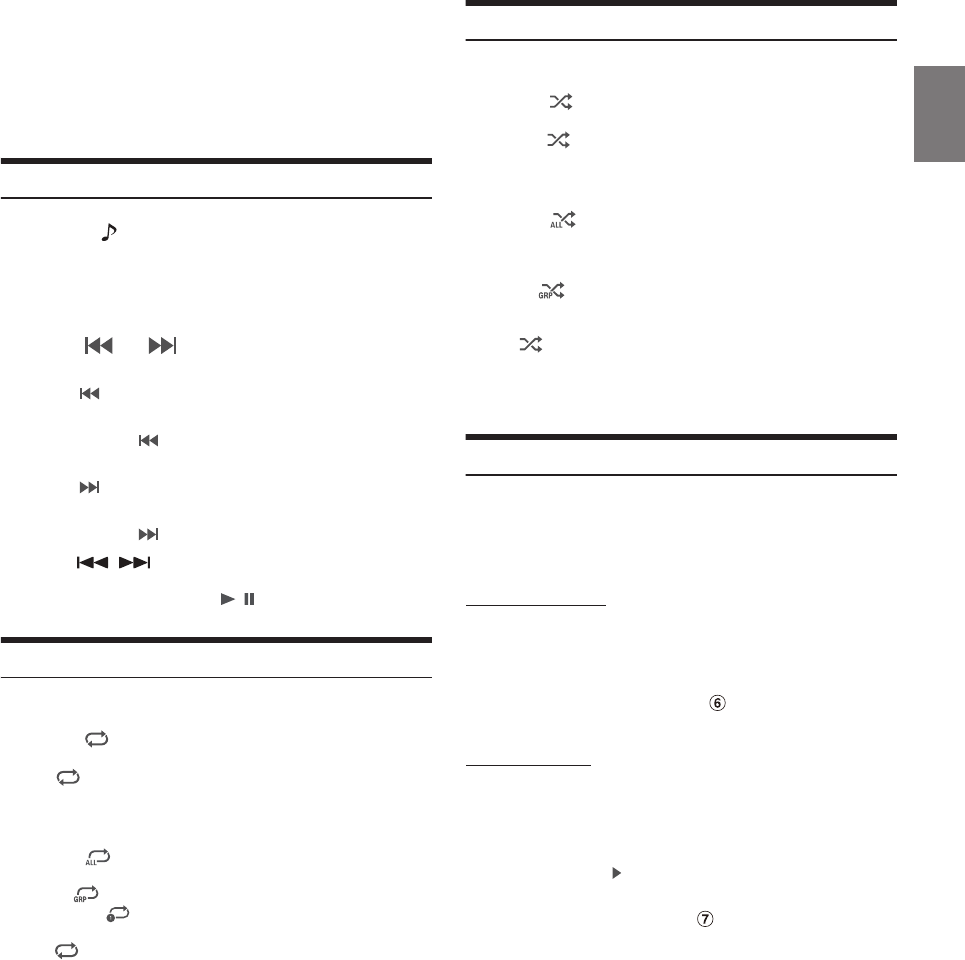
85-EN
• To play back audio, a mobile phone or a portable player conforming to
A2DP (Advanced Audio Distribution Profile) or AVRCP (Audio/Video
Remote Control Profile) is required.
Not all functions work with all devices.
• During a call, sound on the Bluetooth audio source is paused.
Compatible AVRCP versions: 1.0, 1.3, 1.4, 1.5
• Available functions may differ depending on the AVRCP version.
Playback
1Press the (AUDIO) button to select Bluetooth Audio
mode.
The display shows the Bluetooth Audio mode screen.
• You can also select and change the source in the Menu screen
(page 21) or the Favorite screen (page 24).
2Touch [ ] or [ ] to select the desired track (file).
Returning to the beginning of the current file:
Touch [ ].
Fast backward the current file:
Touch and hold [ ].
Advance to the beginning of the next file:
Touch [ ].
Fast forward the current file:
Touch and hold [ ].
• The , buttons provide the same functions above.
3To pause playback, touch [ / ].
Repeat Play
Available for AVRCP Ver. 1.3, 1.4 and 1.5 only.
1Touch [ ].
The Repeat mode select pop up screen is displayed.
•[ ] displays the currently selected mode.
2Select your desired Repeat mode.
The selected Repeat mode changes the button.
• Operations may differ depending on the connected Bluetooth
compatible device.
Random Play
Available for AVRCP Ver. 1.3, 1.4 and 1.5 only.
1Touch [ ].
The Random Play mode select pop up screen is displayed.
• The [ ] button displays the currently selected mode.
2Select your desired Random Play mode.
The selected Random Play mode changes the button.
• Operations may differ depending on the connected Bluetooth
compatible device.
Search Function
Available for AVRCP Ver. 1.4 and 1.5 only.
The displayed list differs with the connected Bluetooth device.
You can search for your desired song by using one of two modes; the
Quick Search mode and the Full Search mode.
Quick Search mode
Touch your desired Group name or File name.
The selected Group*1 or file is played back.
*1 The first file in the selected Group is played back.
• To switch into Quick Search mode, see in “Bluetooth Audio main
screen example” (page 84).
Full Search mode
Touch your desired Group name*2 or File name.
When you select a File name, the selected song is played.
When you select a Group name, repeat the same procedure to select
another Group name or File name.
*2 When you touch the [ ] by a Group name, the unit plays from the first
song in the Group.
• To switch into Full Search mode, see in “Quick Search mode screen
example” (page 84).
• To switch the displayed list or return to the previous page in the List
screen, see “About Basic Operation for List Screen” (page 18).
All Track : Once all of the songs have finished playing, play
back is repeated, starting with the first song.
Group : Only files in a group are repeatedly played back.
Single Track : Only the track currently playing is repeatedly
played back.
Off : Repeat mode Off.
All Track : All songs in the BLUETOOTH compatible devices are
played back in random sequence. Any one song does
not play back again until all songs have been played
back.
Group : A Group is selected randomly and songs in the Group
are played back in order. After all songs are played in
the Group, the next Group is selected randomly.
Off : Random mode Off.
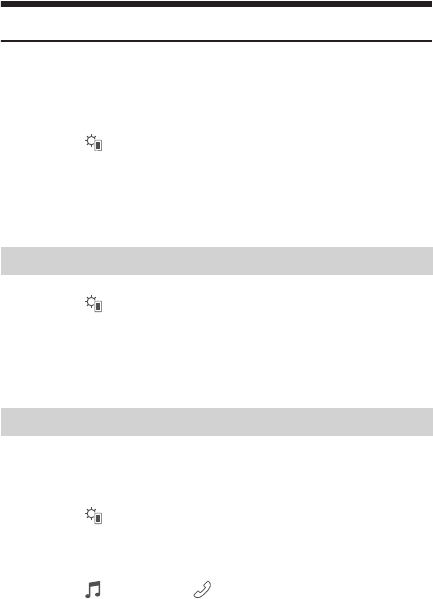
86-EN
Connecting a Bluetooth Device
Registering a Bluetooth device in the unit enables automatic connection.
If it does not connect automatically, run through the connection
procedure again.
1Touch [ ] (Phone Setting).
The Device Setting select pop up screen is displayed.
2Touch [Reconnect].
Bluetooth connection will start.
1Touch [ ] (Phone Setting).
The Device Setting select pop up screen is displayed.
2Touch [Disconnect].
The Bluetooth connection is disconnected.
If multiple Bluetooth devices are registered in this device, you can
change the connection among the registered devices.
1Touch [ ] (Phone Setting).
2Touch [Change Phone].
3Touch [ ] (Audio) or [ ] (Hands-free) of the selected
device.
The connection will transfer to the selected device.
Disconnecting the Bluetooth Connection
Changing the connecting Bluetooth Device
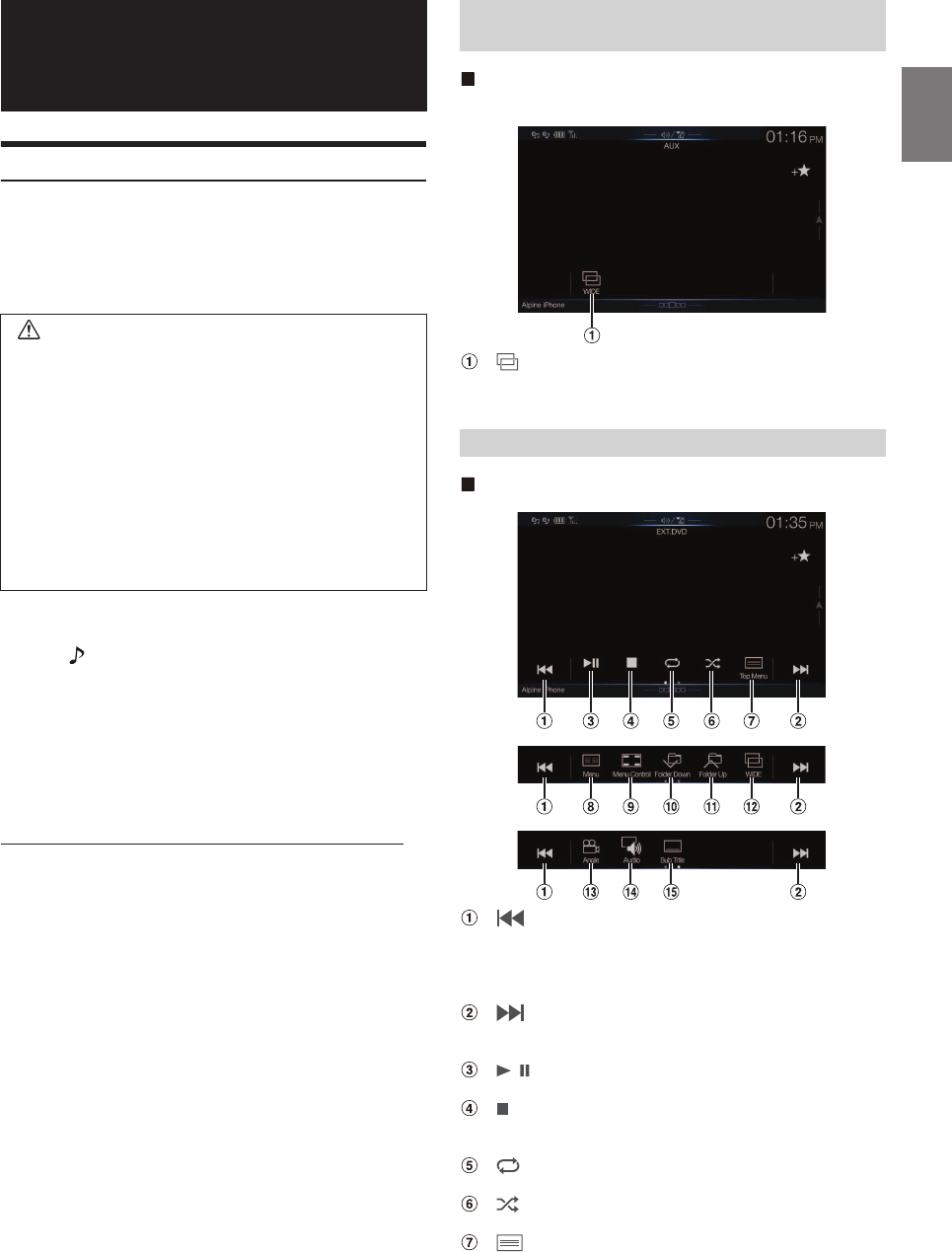
87-EN
Operating Auxiliary Devices (Optional)
To operate devices connected to the AUX terminals of the unit, follow
the procedure described below.
• Set AUX to “On.” See “AUX Setup” (page 44).
• Depending on the connected unit, the onscreen buttons may not work,
or their operation may differ.
• If you try to activate the auxiliary device while driving, the display will
show the warning-Picture off for your safety.
Press the (AUDIO) button to select Auxiliary (AUX)* mode.
The display shows the Auxiliary (AUX) mode screen.
*The name which is given as the mode name in “Setting the Auxiliary
(AUX) Name” (page 45) is displayed.
• You can select and change the source in the Menu screen (page 21) or
Favorite screen (page 24).
• For details on the connected auxiliary device, refer to its owner’s
manual.
AUX Operation Screen Display During Video File Playback
Touch the screen.
The Auxiliary (AUX) operation screen is displayed.
• The operation screen changes to the visual screen in the Auxiliary
(AUX) mode for 5 seconds after an operation has been performed. To
hide the Auxiliary (AUX) operation screen, touch the video display
area.
Example for AUX, AUX DVD, GAME, USB Player mode
display
[ ] (Display Mode)
For details, see “Switching Display Modes (During Video File Play
Back)” (page 60).
External DVD player display example
[ ]
Touch the switch to go back to the beginning of the current
chapter/track/file. Touch the switch once more to find the
beginning of the previous chapter/track/file. Touch and hold to
fast reverse.
[ ]
Touch the switch to advance to the beginning of the next
chapter/track/file. Touch and hold to fast forward.
[ / ]
Switches between play and pause.
[ ]
Touching during play initiates a pre stop. Touching again stops
play.
[ ]
Starts/Stop repeat play.
[ ]
Starts/Stop M.I.X. play.
[ ] (Top Menu)
Calls up the Top Menu screen.
Auxiliary Device
(Optional)
WARNING
It is dangerous (and illegal in many states) for the driver
to watch TV/video while driving the vehicle. The driver
may be distracted from looking ahead and an accident
could occur.
Install the unit correctly so that the driver cannot watch
TV/video unless the car is stopped and the parking brake
is applied.
If the unit is not installed correctly, the driver will be able
to watch TV/video while driving and may be distracted
from looking ahead and cause an accident. The driver or
other people could be severely injured.
Operating an AUX, AUX DVD, GAME or USB
Player
Operating an External DVD Player
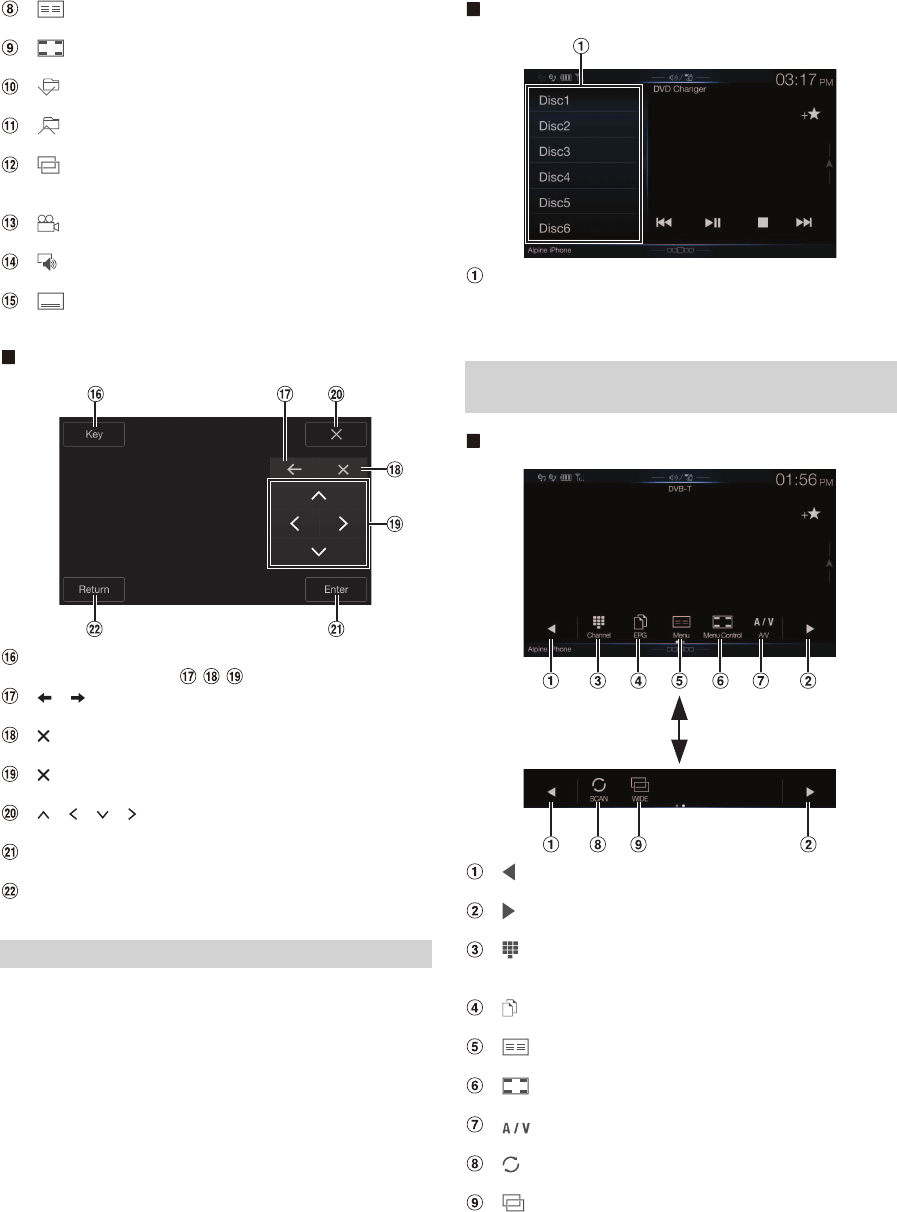
88-EN
[ ] (Menu)
Calls up the Menu screen.
[ ] (Menu Control)
Calls up the menu operation mode.
[ ]
Switches the program/playlist/folder down.
[ ]
Switches the program/playlist/folder up.
[ ] (Display Mode)
You can set the Display Mode. For details, see “Switching Display
Modes (During Video File Play Back)” (page 60).
[ ] (Angle)
Switches angle.
[ ] (Audio)
Switches audio.
[ ] (Sub Title)
Switches sub titles.
Menu operation mode screen example
[Key]
Displays the Key panel ( ).
[ ], [ ]
Moves key panel location.
[ ]
Closes menu operation mode.
[ ]
Closes key panel.
[ ], [ ], [ ], [ ]
Moves menu cursor.
[Enter]
Determines the selected item.
[Return]
Returns to the previous item/screen.
The DVD-CHG operation mode screen and the Menu operation mode
screen are the same as the external DVD player operation screen. See
“Operating an External DVD Player.”
External DVD changer screen example
[Disc1]-[Disc6]
Selects a Disc.
• Touch the left side of the operation screen or swipe the operation
screen to the right to display the Disc selection screen.
Menu operation mode screen example
[ ]
Switches the Channel number / Favorite channel number down.
[ ]
Switches the Channel number / Favorite channel number up.
[ ] (Tune) (Channel or Favorite)
Switches between the Channel mode and the Favorite channel
mode.
[ ] (EPG)
Call up the Electronic Program Guide (EPG).
[ ] (Menu)
Call up the menu screen.
[ ] (Menu Control)
Call up the menu operation mode.
[ ] (A/V)
Switches the source.
[ ] (Scan)
Touch the switch to start the scan procedure.
[ ] (Display Mode)
You can set the Display Mode. For details, see “Switching Display
Modes (During Video File Play Back)” (page 60).
Operating an External DVD Changer
Operating the Mobile Digital TV Receiver
(DVB-T)
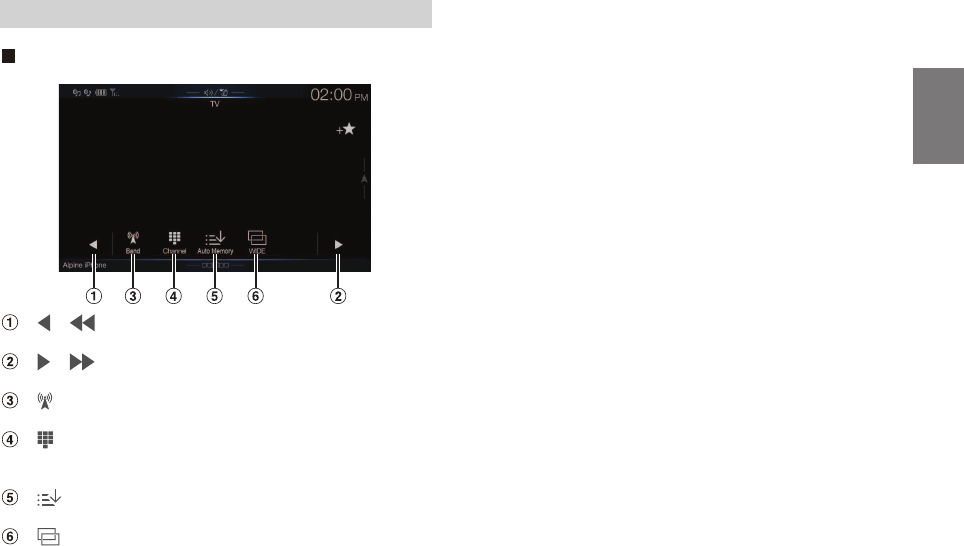
89-EN
Menu operation mode screen example
[ ], [ ]
Switches the Channel number / Preset channel down.
[ ], [ ]
Switches the Channel number / Preset channel up.
[ ] (Band)
Switches the band.
[ ] (Tune) (Channel or Preset or Manual)
Switches amongst Channel mode, Preset mode, and Manual
mode.
[ ] (Auto Memory)
The tuner automatically seeks and stores stations.
[ ] (Display Mode)
You can set the Display Mode. For details, see “Switching Display
Modes (During Video File Play Back)” (page 60).
Operating a TV
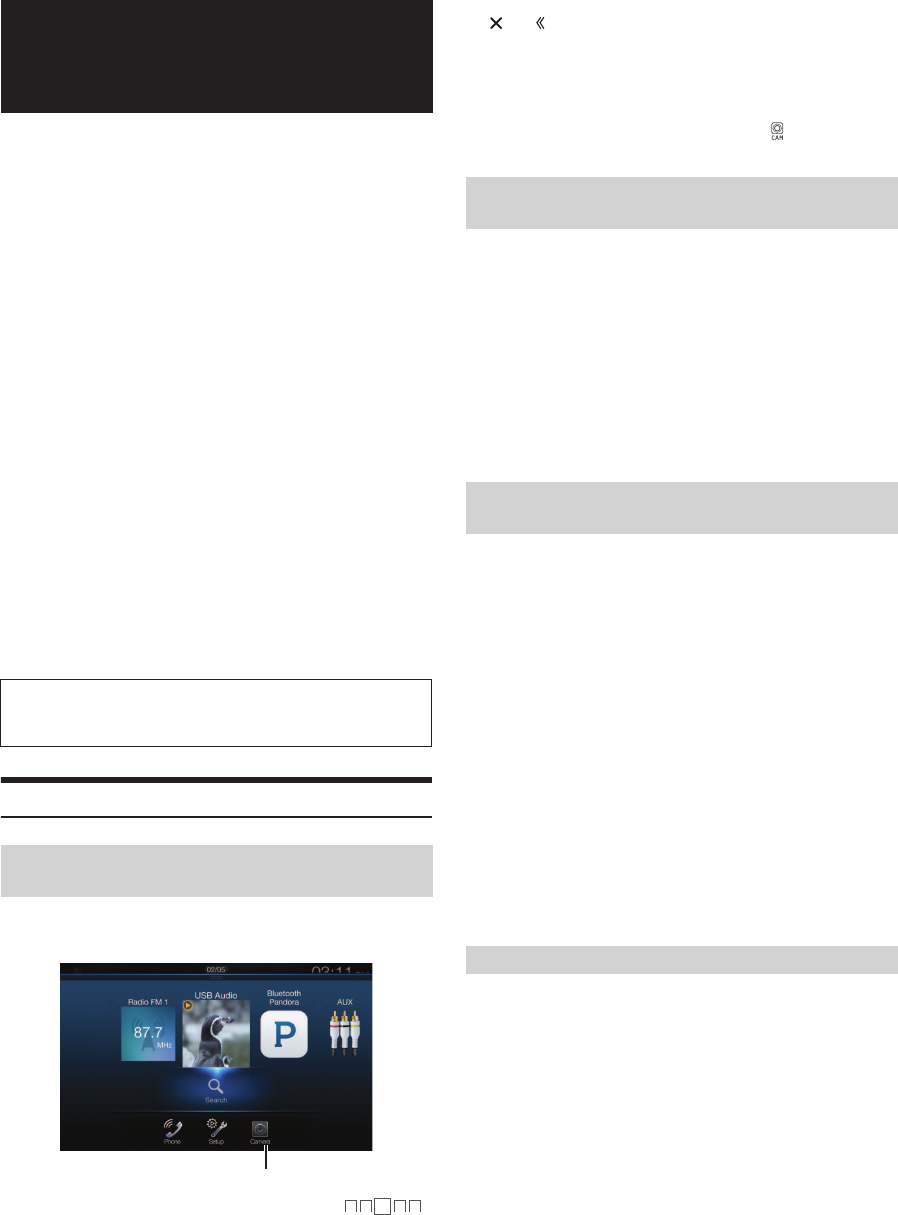
90-EN
When an optional camera is connected, the view video of camera can be
output to the monitor.
Front camera, Rear camera or Side camera can be connected to this unit.
Make the Camera Select setting (Front, Rear, Side or Other) according to
your connected camera. For details, see “Setting the Camera Input”
(page @@).
When using the optional Multi Camera Interface box, you can connect
up to 3 cameras: Front Camera, Rear Camera, and Side Camera. When
connecting the optional Multi Camera Interface box, you need to set
each camera to On/Off in “Setting Multi Camera to On/Off ” (page @@).
When displaying the camera view while connected to the optional Multi
Camera Interface box, you can switch the camera view using the switch
button at the top of the screen.
Front camera:
When the HCE-C257FD is connected, conditions in front of the
vehicle, such as objects, people and other hazards, can be seen.
Rear camera:
If an HCE-C127D/HCE-C157D/HCE-C252RD camera is connected,
when the vehicle is reversed, the rear camera view (guide marks for
vehicle width and available distance) is displayed automatically on
the screen of this unit.
Side camera:
If the HCE-C259SD is connected, you can check for obstacles in the
blind spot on the passenger side.
Other camera:
Set when connecting to a camera other than the Front camera or Rear
camera, such as a room camera and side camera.
Rear Camera Operation
1Press the MENU button.
The menu screen is displayed.
• You can also display the menu screen by touching [ ]
on the lower part of the Audio source screen or by swiping upward.
2Touch [Camera].
The Rear Camera view is displayed.
• Touch the screen while the camera image is being displayed, and touch
[ ] or [ ] to return to the main source screen or previous screen.
• You can perform a Guide Adjustment. For details, see “Adjusting the
Rear/Front/Side Camera Guide” (page 46).
• If you connect a Front Camera and Side Camera using the optional
Multi Camera Interface box, touch [Front] or [Side] to switch the
Camera display.
• You can also switch the Camera view by Pressing (CAMERA)
button. (X110 only)
1Shift the gear lever to the reverse (R) position.
The rear view image is displayed while the car remains in
reverse.
2If you shift the gear lever to a position other than reverse
(R), the monitor returns to the previous screen.
• Never depend solely on the camera when backing up. Always turn and
look and only use the camera for additional assistance.
• This function is effective when the reverse wire is properly connected.
• You can perform a Guide Adjustment. For details, see “Adjusting the
Rear/Front/Side Camera Guide” (page 46).
If the camera has a view switch function, the Direct Change switch is
displayed.
1Touch the screen when the image from the rear camera is
displayed.
The operation screen is displayed on the screen.
• After a 5-second time-out, the operation screen returns to the
camera display screen.
2Touch [Back], [Panorama], [Corner] or [Top].
The image pattern changes.
• For detailed information about image patterns, see the camera Owner’s
Manual.
• You can perform a Guide Adjustment. For details, see “Adjusting the
Rear/Front/Side Camera Guide” (page 46).
1Touch the screen when the image from the camera is
displayed.
The operation screen is displayed on the screen.
• After a 5-second time-out, the operation screen returns to the
camera display screen.
2Touch [Guide Off] or [Hitch Guide Off] on the Rear
camera display screen.
The guide disappears, and then the [Guide Off] or [Hitch Guide
Off] switch changes to [Guide On] or [Hitch Guide On].
3Touch [Guide On] or [Hitch Guide On] to turn on the
guide.
Camera Operation
(Optional)
You can adjust the quality of the camera image.
Setting items: Brightness / Color / Contrast
See “Picture Quality. Setup” (page 39).
Displaying the Rear Camera Image from the
Menu screen
[Camera] button
Displaying the rear view video while the car is
in reverse
Switching the Image Pattern for the Rear
Camera
[Back]: Rear View
[Panorama]: Panorama View
[Corner]: Corner View
[Top]: Ground View
Guide Display ON/OFF Setting
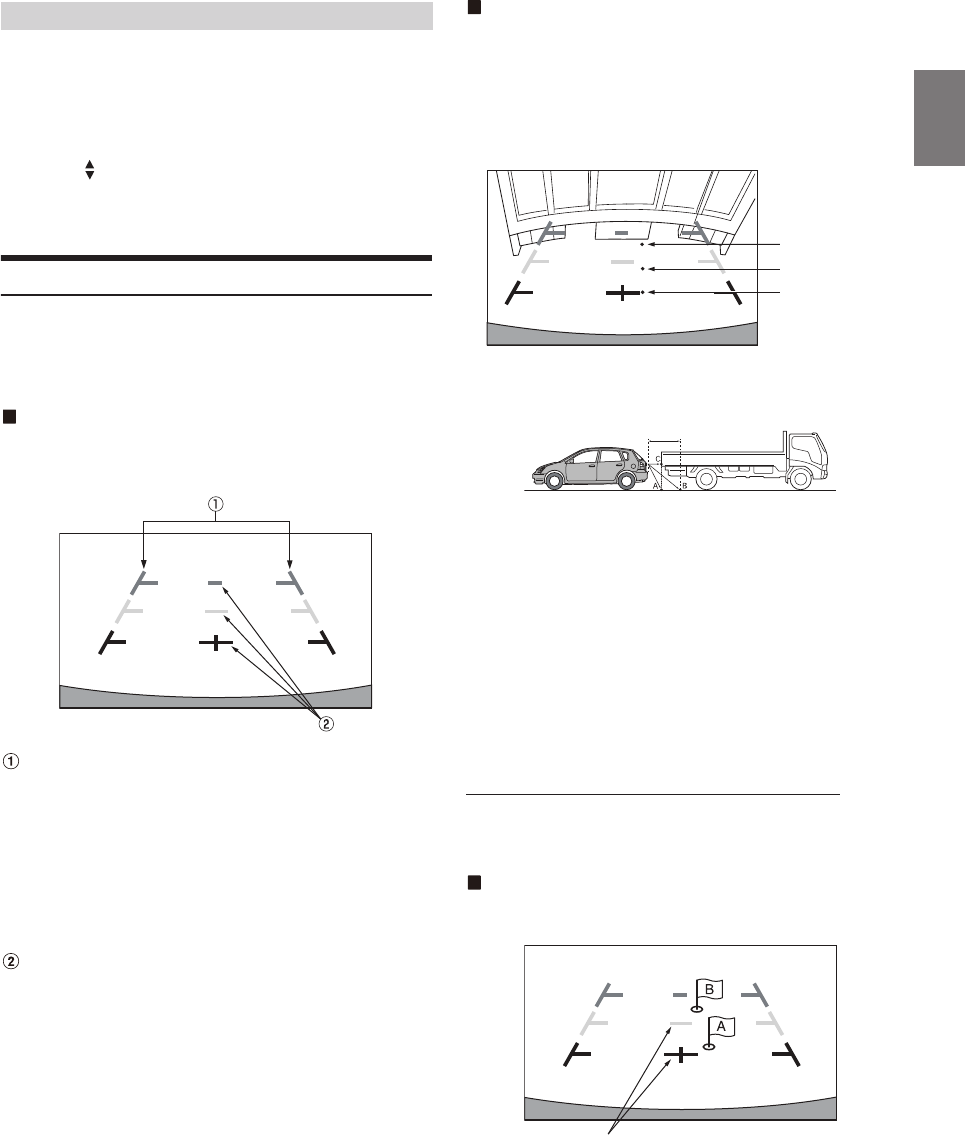
91-EN
1Touch the screen when the image from the camera is
displayed.
The operation screen is displayed on the screen.
• After a 5-second time-out, the operation screen returns to the
camera display screen.
2Touch [ Caution].
• For each touch, the caution location moves to the top or bottom of the
screen.
About the Rear Camera Guide
To display the guide, set “Guide Display ON/OFF Setting” (page 90) to
On. Also, to adjust the guide, see “Adjusting the Rear/Front/Side Camera
Guide” (page 46). You can also turn off the guide in the Rear camera
display screen.
Indication mark meaning
When the car is put into reverse gear, the monitor switches to the rear
view camera image. Guides appear to help visualize the car’s width and
distance from the rear bumper.
Car width extension marks (red, yellow and green in
order of distance)
If properly calibrated, the marks indicate the car’s width. This
helps guide the car’s path when backing up in a straight line.
The marks represent the distance from the rear of the car (from
the rear end of the bumper).
• The marks do not move in synchronization with the steering
wheel.
• Set the marks to suit the car’s width.
Distance guidance marks
The marks represent the distance from the rear of the car (from
the rear end of the bumper).
• The marks do not move in synchronization with the steering
wheel.
• We recommend that you measure the actual distance to the
marks when parked on a level surface.
• Depending on the condition of the car or road surface, the range of
vision may vary.
• The camera has a limited range of vision. Objects at extreme angles to
the camera (e.g. under the bumper or at opposite ends of the bumper)
may not be in the its field-of-vision.
• The rear camera image may have a tint which is different from the
actual surroundings.
• Depending on the car, the guidance may deviate to the right or left. This
is not a malfunction.
Distance guidance mark
The distance guides represent the ground level distance from the rear
bumper. It is difficult to accurately estimate the distance to objects above
ground level.
In the following example, the distance to A is 0.5 m and the distance to B
is 1 m.
<Screen>
<Positions of A, B and C>
In the screen, according to the distance guidance marks, the
truck seems to be parked about 1 m away (at the position B).
In actual fact, however, if you reversed to position A, you
would collide with the truck.
In the screen, positions A, B and C seem to be located in order
of proximity. However, in actual fact, the position A and C are
the same distance, and B is farther away than positions A and
C.
• The car width extension mark represents the distance to the road
surface. The distance to an object on the road is not accurately
represented by the guides.
Error between the screen and the actual road surface
In the following conditions, errors are produced between the screen
guidance and the actual road surface. (The illustrations represent a case
when the camera is installed in the standard position.)
When there is a steep upward slope behind the car
(example)
<Screen>
Adjusting the Caution Display Location
C
B
A (about 0.5 m)
about 1 m
Distance guidance marks
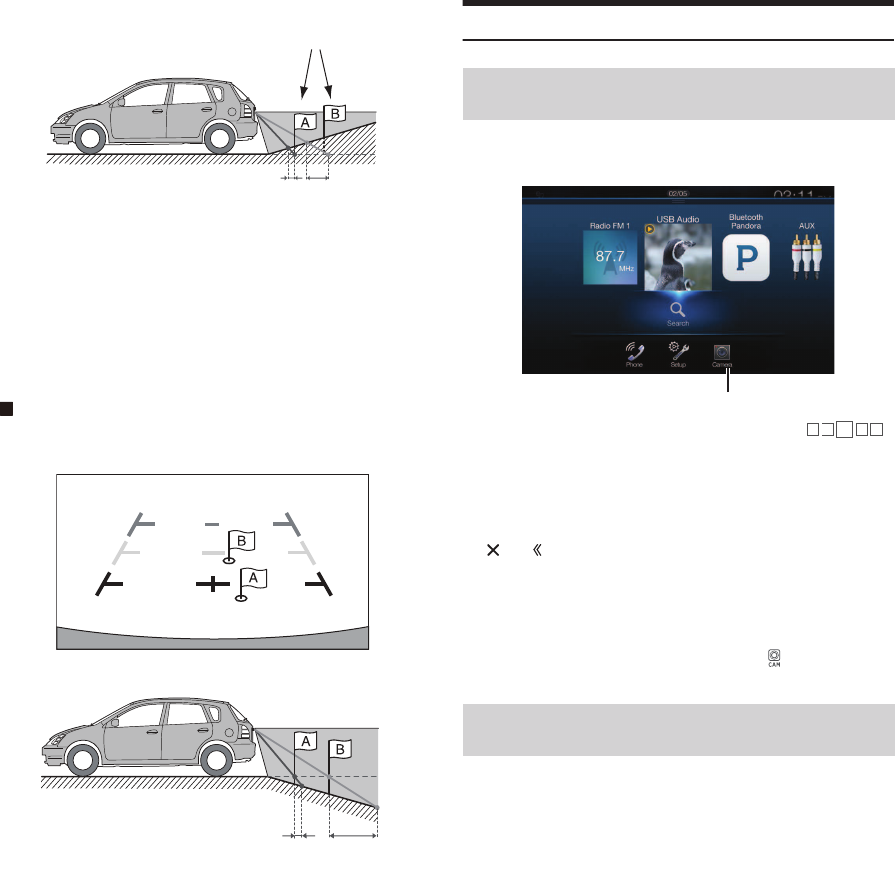
92-EN
<Situation of the car>
The distance guidance mark represents the distance to a flat
road surface. Therefore in the case of an upward slope
behind the car, the distance guides are displayed closer to
the rear bumper than the actual distance. For example, if
there is an obstacle on the upward slope, it may appear
farther away than its actual position.
Also, an error may occur between the guidance and the
actual path of the car on the road surface.
When there is a steep downward slope behind the car
(example)
<Screen>
<Situation of the car>
In the case of a downward slope behind the car, the distance
guides are displayed farther from the rear bumper than the
actual distance.
If there is an obstacle on the downward slope, it seems closer
than its actual position.
Also, an error may occur between the guidance and the
actual path of the car on the road surface.
Front Camera Operation
1Press the MENU button.
The menu screen is displayed.
• You can also display the menu screen by touching [ ]
on the lower part of the Audio source screen or by swiping upward.
2Touch [Camera].
The Front Camera view is displayed.
• Touch the screen while the camera image is being displayed, and touch
[ ] or [ ] to return to the main source screen or previous screen.
• You can perform a Guide Adjustment. For details, see “Adjusting the
Rear/Front/Side Camera Guide” (page 46).
• If you connect a Rear Camera and Side Camera using the optional
Multi Camera Interface box, touch [Rear] or [Side] to switch the
Camera display.
• You can also switch the Camera view by Pressing (CAMERA)
button. (X110 only)
If the camera has a view switch function, the Direct Change switch is
displayed.
1Touch the screen when the image from the front camera
is displayed.
The operation screen is displayed on the screen.
• After a 5-second time-out, the operation screen returns to the
camera display screen.
2Touch [Panorama], [Corner] or [Top].
The image pattern changes.
• For detailed information about image patterns, see the camera Owner’s
Manual.
• You can perform a Guide Adjustment. For details, see “Adjusting the
Rear/Front/Side Camera Guide” (page 46).
Actual distances
Error Error
Error Error
Displaying the Front Camera image from the
Menu screen.
Switching the Image Pattern for the Front
Camera
[Panorama]: Panorama View
[Corner]: Corner View
[Top]: Ground View
[Camera] button
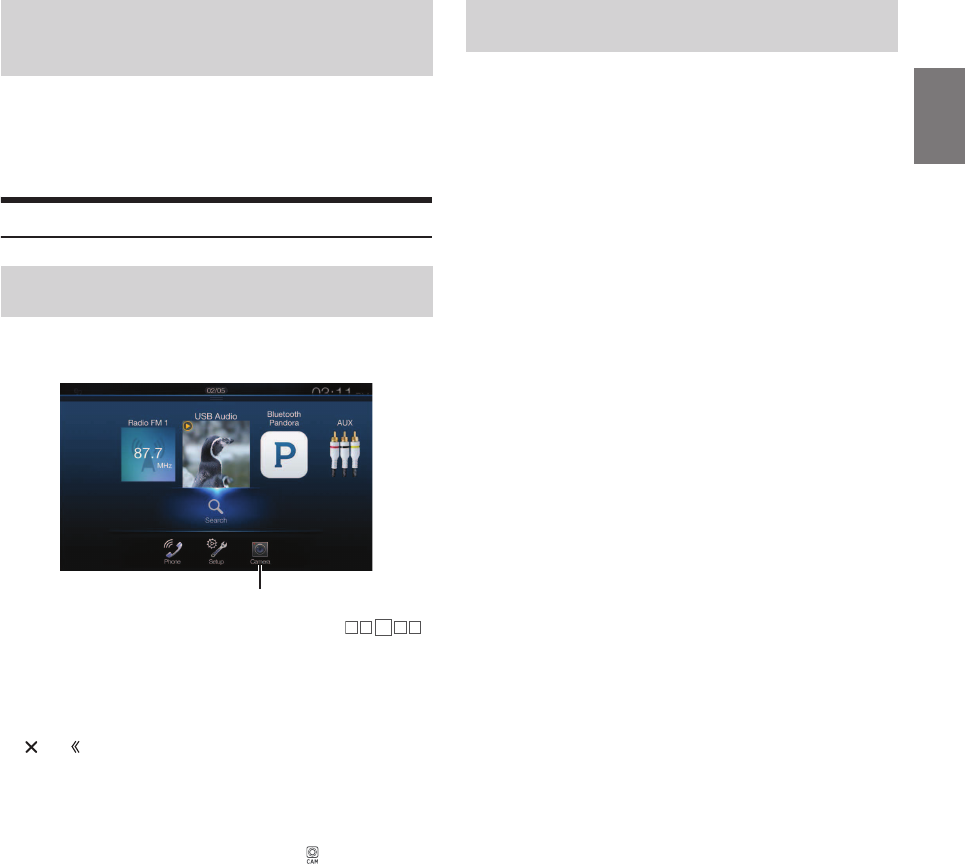
93-EN
As with the rear camera, the front camera guide display ON/OFF setting
and Caution display location can be adjusted. See “Guide Display ON/
OFF Setting” (page 90) and “Adjusting the Caution Display Location”
(page 91) for the operations.
Side Camera Operation
1Press the MENU button.
The menu screen is displayed.
• You can also display the menu screen by touching [ ]
on the lower part of the Audio source screen or by swiping upward.
2Touch [Camera].
The Side Camera view is displayed.
• Touch the screen while the camera image is being displayed, and touch
[ ] or [ ] to return to the main source screen or previous screen.
• You can perform a Guide Adjustment. For details, see “Adjusting the
Side Camera Guide” (page @@).
• If you connect a Rear Camera and Front Camera using the optional
Multi Camera Interface box, touch [Rear] or [Front] to switch the
Camera display.
• You can also switch the Camera view by Pressing (CAMERA)
button. (X110 only)
If the camera has a view switch function, the Direct Change switch is
displayed.
1Touch the screen when the image from the side camera
is displayed.
The operation screen is displayed on the screen.
• After a 5-second time-out, the operation screen returns to the
camera display screen.
2Touch [Rear] or [Front].
The image pattern changes.
• For detailed information about image patterns, see the camera Owner’s
Manual.
• You can perform a Guide Adjustment. For details, see “Adjusting the
Side Camera Guide” (page @@).
About the adjustment of guide display ON/
OFF setting and adjustment of Caution
display location
Displaying the Side Camera image from the
Menu screen.
[Camera] button
Switching the Image Pattern for the Side
Camera
Rear: Vehicle Rear view
Front: Vehicle Front view
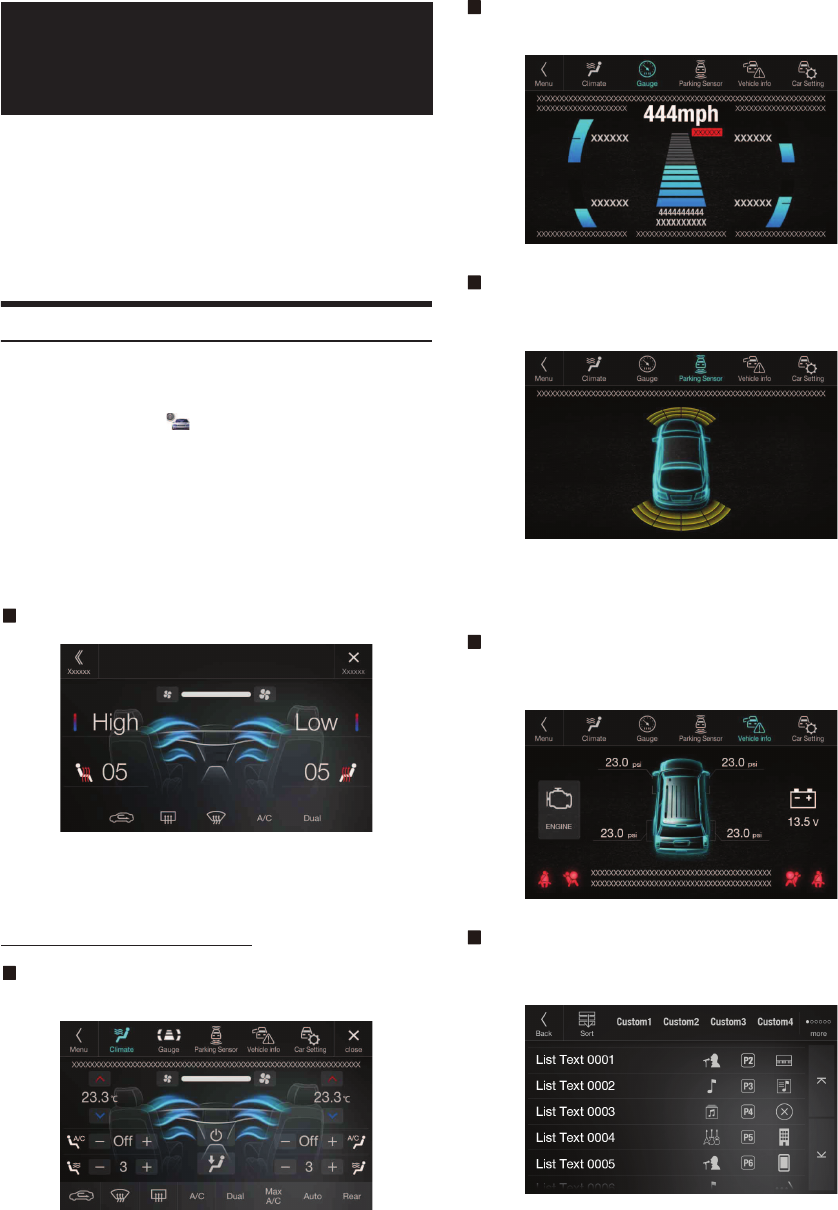
94-EN
When the unit is connected to the car’s iDataLink module, you can
transfer and receive data between the car and the unit to check the car’s
status, or to make various operations from the unit.
When you use iDataLink mode, set each setting other than
“Aftermarket” in “Setting the Source Category” (page @@).
• Available functions differ depending on your vehicle. For details, refer to
your vehicle’s instruction manual.
Access to iDataLink Mode
You can check the car’s status, set the air conditioning, etc.
1Press and hold the ## (Favorite) button for at least 2
seconds, or touch [ ] (Vehicle Info.) in the Menu
screen to activate iDataLink mode.
• The iDataLink mode screen selected in “Setting the Default
Vehicle Screen” (page @@) is displayed.
2Touch the desired tag on the top of the screen.
• The displayed tag options differ depending on the type of vehicle.
Setting contents:
Climate / Gauges / Park Sensor / Vehicle Info. / Car Setting
Climate screen example
3Adjust or confirm the item/information accordingly.
• Operable functions and displays may differ depending on the vehicle.
iDataLink Function Screen example
Climate screen example
You can control the temperature inside the vehicle, etc.
Gauges screen example
You can check the vehicle's speed, the engine's rotation speed, etc.
Parking sensor screen example
You can check the distance from the front and rear of the vehicle to an
obstacle.
• If the car sensor detects an obstacle, the screen automatically changes to
the Parking sensor screen. For details, see “About Parking Sensor screen”
(page @@).
Vehicle Information screen example
You can check for open doors, check the tire pressure, the battery life,
etc. for the vehicle.
Car Setting screen example (Generic List screen)
The Generic List/Popup Window/Current source control screen is
displayed.
iDataLink Operation
(Optional)
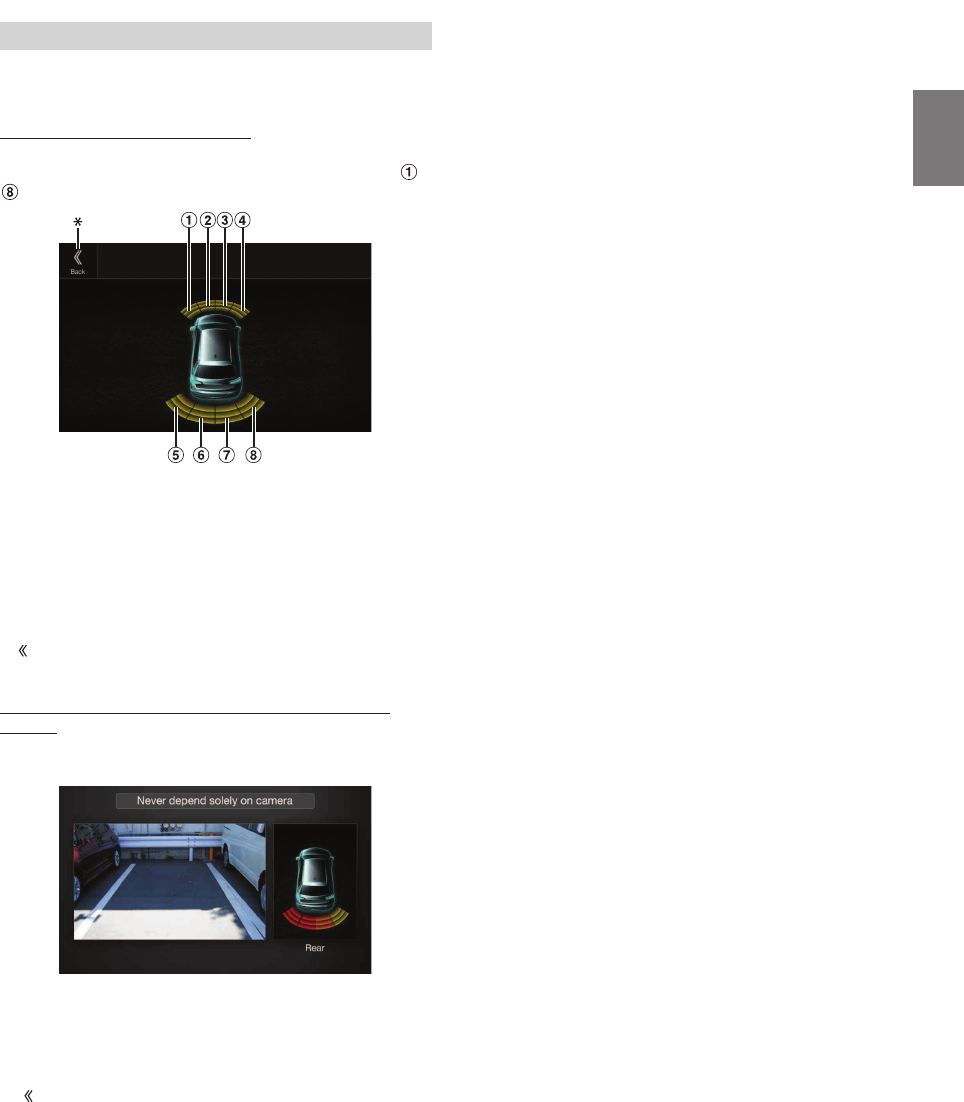
95-EN
The Parking sensor screen turns on when the front or rear sensor on
your vehicle detects an obstacle within a certain distance.
Parking Sensor Full screen example
When the front or rear sensor detects an obstacle within a certain
distance, the Parking Sensor screen is displayed, and the indicator ( -
) that corresponds with that area lights up.
Indicator colors when an obstacle is detected.
Red: close distance
Orange: medium distance
Yellow: long distance
• Depending on the speed of the vehicle, when moving faster than a
certain speed, the Parking Sensor screen may not be displayed.
• Vehicles that do not have the obstacle detection sensor cannot use this
function.
*[ ] is displayed only when the Front camera or Rear camera is
interlocked.
Parking Sensor Camera interlock screen example (Rear
camera)
You can check for obstacles through an interlocked camera image by
connecting a Front or Rear Camera.
• Touch the Camera image area to switch to the Camera full screen.
(While displaying the Camera full screen, touch the Camera screen,
then touch [Sensor] to return to the Parking Sensor Camera interlock
screen.)
• Touch the car icon to switch to the Parking sensor full screen. (Touch
[ ] on the Parking Sensor full screen to return to the Parking Sensor
Camera interlock display.)
• To use this function, set the Camera Select setting to “Front/Other” or
“Rear.” For details, see “Setting the Camera Input” (page 46).
• If you connect a Front Camera/Rear Camera/Side Camera using the
optional Multi Camera Interface box, you can switch the Camera
display. For details on the camera settings when connected to the Multi
Camera Interface box, see “Setting Multi Camera to On/Off” (page
@@). For details on how to switch the camera display, see “Camera
Operation (Optional)” (page @@).
External Accessory Control Operation
You can set the headlights to ON/OFF or adjust the air suspension from
this unit by connecting the optional External Accessory Control box.
The following explains how to edit the control switches, because the
functions that can be controlled differ depending on the type of vehicle.
1Touch [ ] (Ext Acc Ctrl) in the Menu screen to activate
External Accessory screen.
The External Accessory screen is displayed.
2Touch [ ] (Edit).
The Edit Control Switches screen is displayed.
About Parking Sensor screen
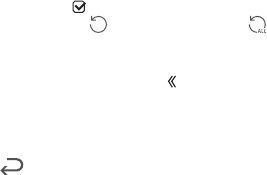
96-EN
3Edit each switch.
When changing an icon:
Touch the icon, and select your desired icon from the Icon Type
list. After selecting the icon, set the Output Type (Timing) for
each function.
*The Output Type (Timing) sets the operating time for that function
when you touch the icon on the External Accessory screen.
When changing the name:
Touch the icon name, then input characters into Edit Name
(Keypad). You can also select a basic name from the [Template]
of the Keypad. For details on how to input characters using the
keypad, see “How to Input Characters and Numbers (Keypad)”
(page @@). (When a basic name is selected from the Template,
the icon will be changed according to the basic name.)
When changing the layout of the switches:
Drag and drop an icon to the desired location.
To revert to a default icon:
Touch the check box “ ” of the icon that you want to revert to
default, and then touch [ ] (Reset). If you touch [ ] (Reset
All), all icons revert to default icons.
4After editing is complete, touch [ ] (Back).
5After the caption for the confirmation is displayed, touch
[OK].
• If you touch [ ] (Cancel) while editing, the screen switches to the
Edit screen.
Pulse: The operating time when you touch the icon. (Select
from 11 steps, ranging 0.5 sec. to 10 sec.)
Latch: Switch On/Off by touching the icon.
Momentary: Operating time lasts from when an icon is touched to
when it is released.
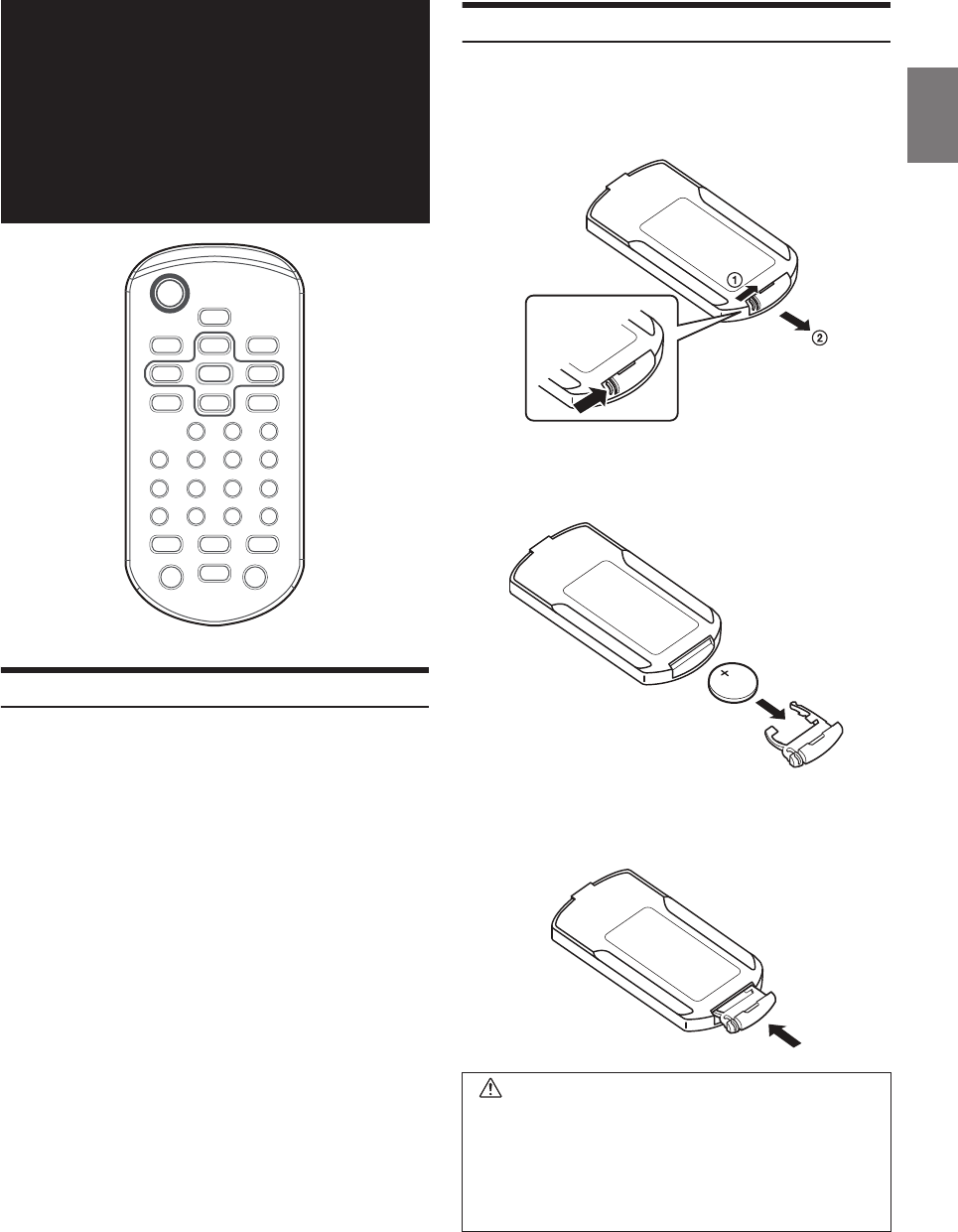
97-EN
When Using the Remote Control
• When you first use the remote control, please remove the insulation
sheet in the battery case.
• Point the remote control at the remote sensor within about 2 metres.
• It may not be possible to operate the remote control if the remote control
sensor is exposed to direct sunlight.
• The remote control is a small, lightweight precision device. To avoid
damage, short battery life, operational errors and poor response,
observe the following.
- Do not subject the remote control to excessive shock.
- Do not put in a trouser pocket.
- Keep away from food, moisture and dirt.
- Do not place in direct sunshine.
Battery Replacement
Battery type: CR2025 battery or equivalent.
1Opening the battery case
Slide out the battery cover while firmly pressing in the direction
of the arrow.
2Replacing the battery
Put the battery in the case with the (+) indication upward as
shown in the illustration.
• Placing a battery in backwards way may cause a malfunction.
3Closing the cover
Slide the cover as illustrated until a click is heard.
About Remote
Control Operation
(X110 with DVE-
5300X only)
WARNING
DO NOT OPERATE ANY FUNCTION THAT TAKES YOUR
ATTENTION AWAY FROM SAFELY DRIVING YOUR VEHICLE.
Any function that requires your prolonged attention should
only be performed after coming to a complete stop. Always stop
the vehicle in a safe location before performing these functions.
Failure to do so may result in an accident.
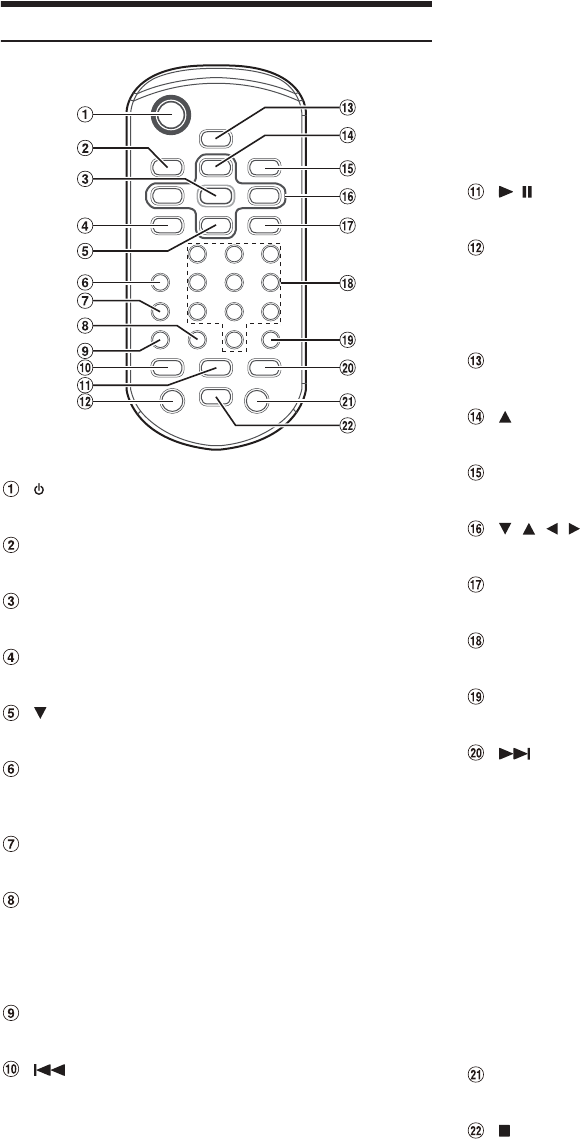
98-EN
Operating the DVD Player
button
Recalls the Menu screen.
DISP. button
Displays playback status on the screen.
ENT. button
Determines the selected item.
REPEAT button
Repeats playback.
button
Selects MP3/WMA/AAC/WAV folders.
AUDIO button
Video CD: Switches the audio output.
DVD: Switches the audio language.
SUBTITLE button
Switches the subtitle.
CLR (ALL CLR) button
Removes numbers (one character at a time) that have been
selected and input.
Press and hold for 2 seconds. All the characters which were
selected and input are erased.
ANGLE button
Switches the angle (DVD only).
button
CD mode:
Press the button to go back to the beginning of the current
track. Press and hold to fast reverse.
MP3/WMA/AAC/WAV mode:
Press the button to go back to the beginning of the current
file. Press and hold to fast reverse.
DVD/Video CD mode:
• Move to the desired position on the disc.
• During playback, press and hold for more than 1 second to
reverse the disc at double speed. Hold for more than 5
seconds to reverse the disc at 8 times the normal speed.
Hold for more than 10 seconds to reverse the disc at 32
times the normal speed.
• The picture is reversed by one frame each time the button
is pressed in the pause mode (DVD only).
/ button
Switches between play and pause.
MENU button
Video CD:
Switches between PBC ON and OFF.
DVD:
Displays the DVD menu.
SETUP button
Displays the SETUP (initial setting) screen.
button
Selects MP3/WMA/AAC/WAV folders.
RETURN button
Returns to the selection screen just prior to the current screen.
, , , buttons
Selects the items displayed on the screen.
M.I.X. button
M.I.X. play for CDs and MP3/WMA/AAC/WAV.
Numeric Keypad
Inputs numbers.
LIST button
MP3/WMA/AAC/WAV Folder and File Search.
button
CD mode:
Press the button to advance to the beginning of the next
track. Press and hold to fast forward.
MP3/WMA/AAC/WAV mode:
Press the button to advance to the beginning of the next file.
Press and hold to fast forward.
DVD/Video CD mode:
• Move to the desired position on the disc.
• During playback, press and hold for more than 1 second to
forward the disc at double speed. Hold for more than 5
seconds to forward the disc at 8 times the normal speed.
Hold for more than 10 seconds to forward the disc at 32
times the normal speed.
• The picture is forwarded by one frame each time the
button is pressed in the pause mode.
TOP M. button
Displays the Top Menu.
button
Stops the playback.
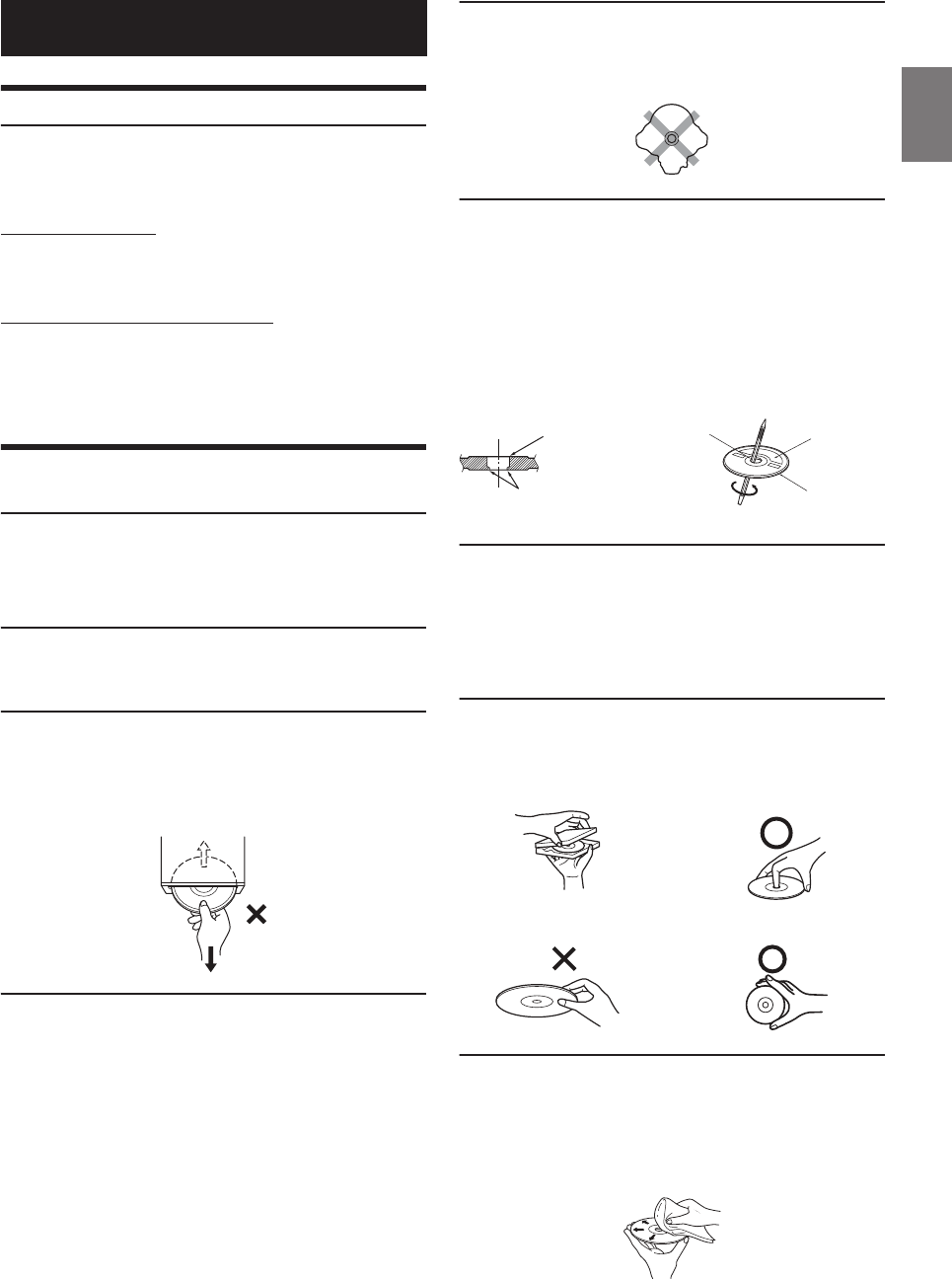
99-EN
Product Software Update
This product use software that can be updated through a USB flash
drive. Download the software from the Alpine website and update the
product using the USB flash drive.
Updating this product
Check the Alpine website for details on updating.
http://www.alpine-usa.com
Important information on the software
About the software license of the product
The software installed in the product contains open-source software.
See the following Alpine website for details on the open source software.
http://www.alpine.com/e/oss/download
Cautions about Discs (X110 with DVE-5300X
only)
Moisture Condensation
You may notice the disc playback sound wavering due to
condensation. If this happens, remove the disc from the player and
wait about an hour for the moisture to evaporate.
Damaged Disc
Do not attempt to play cracked, warped, or damaged discs. Playing
a bad disc could severely damage the playback mechanism.
Never Attempt the Following
Do not grip or pull out the disc while it is being pulled back into the
player by the automatic reloading mechanism.
Do not attempt to insert a disc into the unit when the unit power is
off.
Inserting Discs
Your player accepts only one disc at a time for playback. Do not
attempt to load more than one disc.
Make sure the label side is facing up when you insert the disc. “Disc
error” will be displayed on your player if you insert a disc
incorrectly. If “Disc error” continues to be displayed even though
the disc has been inserted correctly, push the RESET switch with a
pointed object such as a ballpoint pen.
Playing a disc while driving on a very bumpy road may result in
skips, but this will not scratch the disc or damage the player.
Irregular Shaped Discs
Be sure to use round shaped discs only for this unit and never use
any special shaped discs.
Use of special shaped discs may cause damage to the mechanism.
New Discs
To prevent the disc from jamming, “Disc error” is displayed if discs
with irregular surfaces are inserted or if discs are inserted
incorrectly. When a new disc is ejected immediately after initial
loading, use your finger to feel around the inside of the center hole
and outside edge of the disc. If you feel any small bumps or
irregularities, this could inhibit proper loading of the disc. To
remove the bumps, rub the inside edge of the hole and outside edge
of the disc with a ballpoint pen or other such instrument, then
insert the disc again.
Installation Location
Make sure the unit will not be installed in a location subjected to:
• Direct sun and heat
• High humidity and water
• Excessive dust
• Excessive vibrations
Correct Handling
Do not drop the disc while handling. Hold the disc so you will not
leave fingerprints on the surface. Do not affix tape, paper, or
gummed labels to the disc. Do not write on the disc.
Disc Cleaning
Fingerprints, dust, or soil on the surface of the disc could cause the
DVD player to skip. For routine cleaning, wipe the playing surface
with a clean, soft cloth from the center of the disc to the outer edge.
If the surface is heavily soiled, dampen a clean, soft cloth in a
solution of mild neutral detergent before cleaning the disc.
Information
Center Hole
Bumps
Center Hole
New Disc
Outside
(Bumps)
CORRECT
INCORRECT
CORRECT
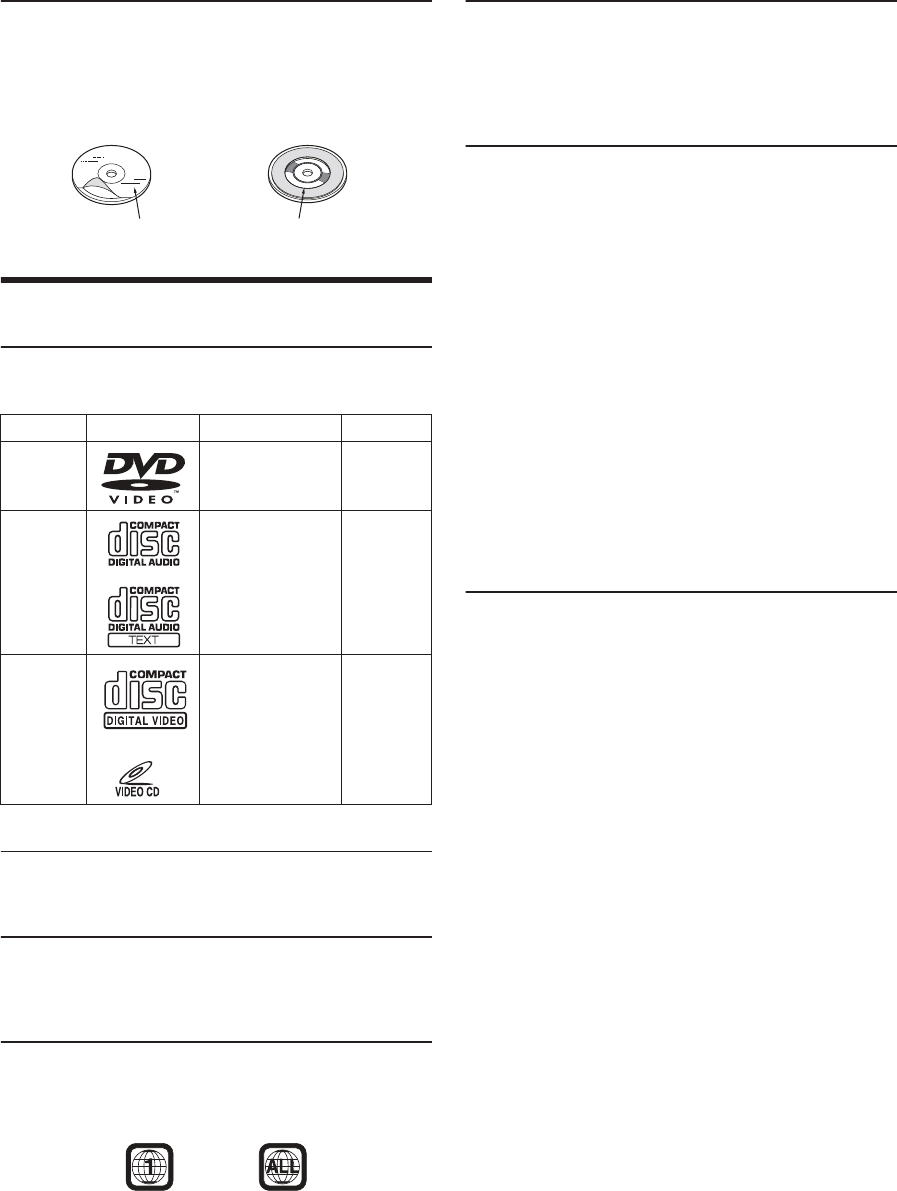
100-EN
Disc Accessories
There are various accessories available on the market for protecting
the disc surface and improving sound quality. However, most of
them will influence the thickness and/or diameter of the disc. Using
such accessories can cause operational problems. We recommend
not using these accessories on discs played in Alpine DVD players.
Discs Playable on This Unit (X110 with DVE-
5300X only)
Playable Discs
The discs listed below can be played on this unit.
* Two-layer DVD disc compatible
Discs that cannot be played
DVD-ROMs, DVD-RAMs, CD-ROMs (excluding MP3/WMA/
AAC/WAV files), photo CDs, etc.
DualDisc
This unit is not compatible with DualDisc.
Using a DualDisc may cause unit malfunction, and may cause disc
damage when the disc is inserted/ejected.
DVD region number (playable region number)
This DVD player will play back any disc whose region number is 2
(or All). DVDs with a region number other than those listed below,
cannot be played on this DVD player.
Video CDs
This DVD unit is compatible with playback control (PBC)
compatible video CDs (version 2.0).
“PBC” is a function by which you can use menu screens recorded
on the disc to find the scene you want to watch and view various
types of information in dialog style.
Using compact discs (CD/CD-R/CD-RW)
If you use unspecified compact discs, correct performance cannot
be guaranteed.
You can play CD-Rs (CD-Recordables)/CD-RWs (CD-
ReWritables) which have been recorded only on audio devices.
You can also play CD-Rs/CD-RWs containing MP3/WMA/AAC/
WAV formatted audio files.
• Some of the following discs may not play on this unit:
Flawed discs, discs with fingerprints, discs exposed to extreme
temperatures or sunlight (e.g., left in the car or this unit), discs
recorded under unstable conditions, discs on which a recording
failed or a re-recording was attempted, copy-protected CDs
which do not conform to the audio CD industry standard.
• Use discs with MP3/WMA/AAC/WAV files written in a format
compliant with this unit. For details, see pages 101 and 102.
To customers using CD-R/CD-RW
• If a CD-R/CD-RW cannot be played back, make sure the last
recording session was closed (finalized).
• Finalize the CD-R/CD-RW if necessary, and attempt playback
again.
Tips for making your own discs
The unit plays DVD Video, Video CD, Audio CD and has a built in
MP3/WMA/AAC decoder.
The following information is designed to help you create your own
music CDs (either Audio CD or MP3/WMA/AAC encoded CD-R/
RW files).
What is the difference between an Audio and MP3/WMA/AAC
CD?
An Audio CD is the same format as the commercial CDs you buy in
the store (also known as CD-DA). MP3 (MPEG Audio Layer 3)/
WMA (Windows Media Audio)/AAC (Advanced Audio Coding) is
a data file that uses a compression scheme to reduce the size of the
music file*.
*If the first session on a disc containing both CD-DA data and
MP3/WMA/AAC data is a CD-DA file, only CD-DA files will be
played.
Multisession CD-R/RW:
Once a recording has been stopped, this is considered one session.
If the disc is not closed (finalized), additional data may be added.
Once this additional data has been recorded, this becomes a
“multisession” CD.
Properly formatted MP3/WMA/AAC Discs:
Use ISO9660 formatting to insure proper playback. You may use
standard ISO naming Level 1 (8.3 DOS standard), Level 2
(32 characters) or Joliet (Windows or Macintosh long filenames) file
naming conventions*.
*Please consult the Owner’s manual for additional information.
Mark (logo) Recorded Content Disc size
DVD Video Audio + Video 12 cm*
Music CD Audio 12 cm
Video CD Audio + Video 12 cm
Transparent Sheet Disc Stabiliser
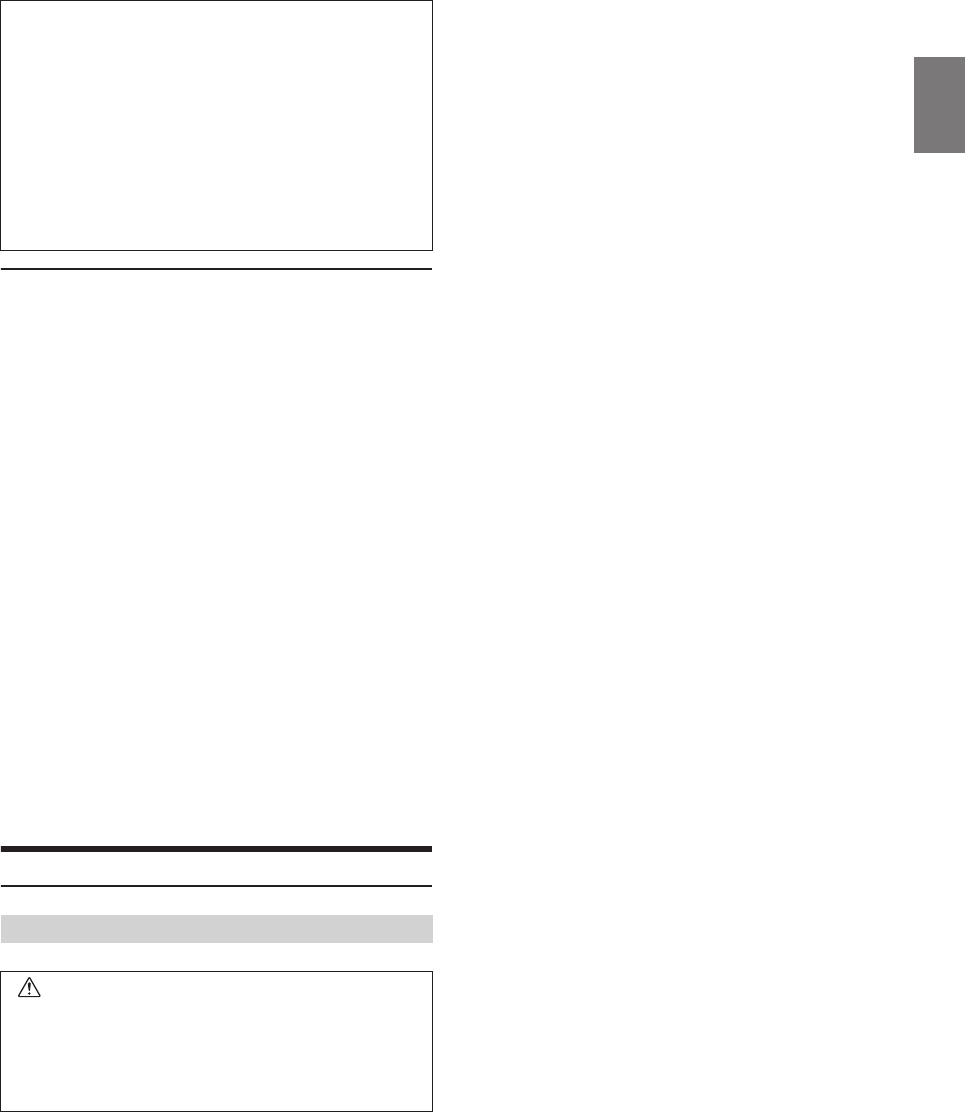
101-EN
Using DVD-Rs/DVD-RWs/DVD+Rs/DVD+RWs
• This unit is compatible with discs recorded in the standard
DVD-Video format.
• Note that discs not finalized (processed to enable to play on
playback-only DVD players) cannot be played on this DVD
player.
• Some discs may not play back, depending on the recording
device and disc format.
• Discs or files utilising copy protection, may not be playable.
Some recording systems may not properly format copied files to
enable proper playback.
• In the following cases, the disc may not play on this unit:
discs recorded by certain DVD recorders, certain irregular discs,
flawed discs, dirty discs, when the pickup lens of this DVD player
is dirty, or when moisture condensation has occurred inside the
unit.
• Be sure to follow all cautions included with your DVD-Rs/
DVD-RWs/DVD+Rs/DVD+RWs discs.
• Do not put stickers, seals, or tape on the label side of DVD-Rs/
DVD-RWs/DVD+Rs/DVD+RWs.
• Compared to the regular discs, DVD-Rs/DVD-RWs/DVD+Rs/
DVD+RWs are more affected by heat, moisture, and direct
sunlight. If left in a car, etc., damage may occur and it might not
play on this unit.
• The operable temperature range for disc playback is as follows:
DVD-R/DVD-RW: 25 to +70°C
DVD+R/DVD+RW: +5 to +55°C
About the Supported Formats
What is MP3?
MP3, whose official name is “MPEG Audio Layer 3,” is a compression
standard prescribed by the ISO, the International Standardisation
Organisation and MPEG which is a joint activity institution of the IEC.
MP3 files contain compressed audio data. MP3 encoding is capable
of compressing audio data at extremely high ratios, reducing the size
of music files to as much as one-tenth their original size. This is
achieved while still maintaining near CD quality. The MP3 format
realizes such high compression ratios by eliminating the sounds that
are either inaudible to the human ear or masked by other sounds.
What is WMA?
WMA, or “Windows Media™ Audio,” is compressed audio data.
WMA is similar to MP3 audio data.
What is AAC?
AAC is the abbreviation for “Advanced Audio Coding,” and is a basic
format of audio compression used by MPEG2 or MPEG4.
What is FLAC?
FLAC (Free Lossless Audio Codec) is an audio file codec for lossless
compression, developed and offered as open source software.
Codecs with lossy compression forms, such as MP3 and AAC, reduce
part of the data to improve compression efficiency.
However, FLAC can reconstruct compressed data to be an identical
copy of the original data by performing lossless compression. The
compression ratio of FLAC is about 50%.
Method for creating MP3/WMA/AAC/FLAC (USB Flash drive) files
Audio data is compressed using software with MP3/WMA/AAC/FLAC
(USB Flash drive) codecs. For details on creating MP3/WMA/AAC/
FLAC (USB Flash drive) files, refer to the user’s manual for that
software.
MP3/WMA/AAC/FLAC (USB Flash drive) files that are playable on this
device have the file extensions.
MP3: “mp3”
WMA: “wma”
AAC: “m4a”
FLAC: ”flac”/”fla”
WMA is not supported for the following files, Windows Media Audio
Professional, Windows Media Audio 10 std or Windows Media Audio
10 Pro Lossless.
There are many different versions of the AAC format. Confirm that the
software being used conforms to the acceptable formats listed
above. It’s possible that the format may be unplayable even though
the extension is valid.
Playback of AAC files encoded by iTunes is supported.
Supported playback sampling rates and bit rates
MP3 (USB Flash drive/Disc)
WMA (USB Flash drive/Disc)
AAC (USB Flash drive/Disc)
FLAC (USB Flash drive)
This device may not play back correctly depending on sampling
rates.
On handling compact discs (CD/CD-R/CD-RW)
• Do not touch the surface.
• Do not expose the disc to direct sunlight.
• Do not affix stickers or labels.
• Clean the disc when it is dusty.
• Make sure that the disc is smooth and flat.
• Do not use commercially available disc accessories.
Do not leave the disc in the car or the unit for a long time.
Never expose the disc to direct sunlight.
Heat and humidity may damage the disc and you may not be
able to play it again.
About MP3/WMA/AAC/FLAC
CAUTION
Except for private use, duplicating audio data (including
MP3/WMA/AAC/FLAC data) or distributing, transferring,
or copying it, whether for free or for a fee, without
permission of the copyright holder is strictly prohibited
by the Copyright Act and by international treaty.
Sampling rates: 48 kHz, 44.1 kHz, 32 kHz, 24 kHz, 22.05 kHz, 16 kHz,
12 kHz, 11.025 kHz, 8 kHz
Bit rates: 8 - 320 kbps
Sampling rates: 48 kHz, 44.1 kHz, 32 kHz, 22.05 kHz, 16 kHz,
11.025 kHz, 8 kHz
Bit rates: 48 - 320 kbps
Sampling rates: 48 kHz, 44.1 kHz, 32 kHz, 24 kHz, 22.05 kHz, 16 kHz,
12 kHz, 11.025 kHz, 8 kHz
Bit rates: 16 - 320 kbps
Sampling rates: 96kHz, 88.2kHz, 48kHz, 44.1kHz, 32kHz, 24kHz,
22.05kHz, 16kHz, 8kHz
Channel number: 1ch, 2ch
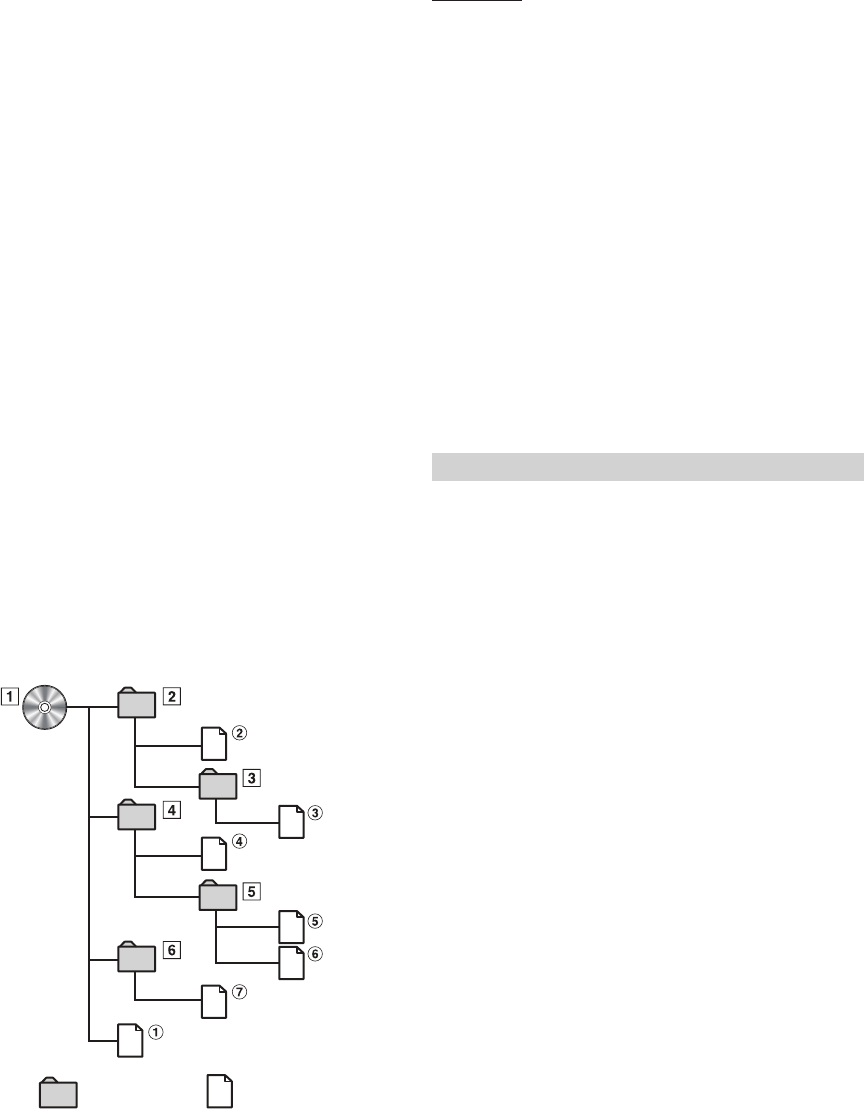
102-EN
ID3 tags/WMA tags
This device supports ID3 tag v1.0, v1.1, v2.2, v2.3, v2.4, and WMA tag
Ver.1.x. If tag data is in an MP3/WMA/AAC file, this device can display
the title (track title), artist name, and album name ID3 tag/WMA tag
data.
For non-supported characters, “?” is displayed.
The number of characters may be limited, or not correctly displayed,
depending on the tag information.
Playing back MP3/WMA/AAC/FLAC
MP3/WMA/AAC files are prepared, then written to a USB flash drive.
• Maximum numbers of playable files/folders
USB Flash drive: 10,000 files/folders (including Root Folder)
• Largest playable file size: 512 MB
Playback may not be performed if a disc exceeds the limitations
described above.
If a file/folder name is long, the maximum possible number of files
may decrease.
• Both Audio and Video files are counted if their formats are
playable on this unit.
Media supported
The media that this device can play back a USB flash drive.
Corresponding File Systems
This device supports FAT 16/32.
Order of files
Files are played back in the order that the writing software writes
them to the disc. Therefore, the playback order may not be what’s
expected. Verity the writing order in the software’s documentation.
The playback order of the folders and files is as follows. (The
following numbers may differ from actually displayed numbers.)
Terminology
Bit rate
This is the “sound” compression rate specified for encoding. The higher
the bit rate, the higher the sound quality, but also the larger the files.
Sampling rate
This value shows how many times per second the data is sampled
(recorded). For example, music CDs use a sampling rate of 44.1 kHz, so
the sound is sampled (recorded) 44,100 times per second. The higher the
sampling rate, the higher the sound quality, but also the larger the
volume of data.
Encoding
Converting music CDs, WAVE (AIFF) files, and other sound files into
the specified audio compression format.
Tag
Song information such as track titles, artist names, album names, etc.,
written into MP3/WMA/AAC/FLAC (USB flash drive) files.
Root folder
The root folder (or root directory) is found at the top of the file system.
The root folder contains all folders and files. It is created automatically
for all burned discs.
WAV, whose official name is “WAVE FORMAT” is a standard format of
Windows® audio file.
Extension: “.wav”
Sampling rate: 44.1 kHz
Quantization bit number: 16
Channel number: up to 2ch
Format: PCM only
The maximum nested folder depth is 8 (including the root
directory). File names are limited to 256 characters (including the
extension).
Valid characters for folder/file names are letters A-Z (all caps),
numbers 0-9, and ‘_’ (underscore).
Root
Folder
Folder MP3/WMA/AAC/FLAC/
WAV File
About WAV (Disc)
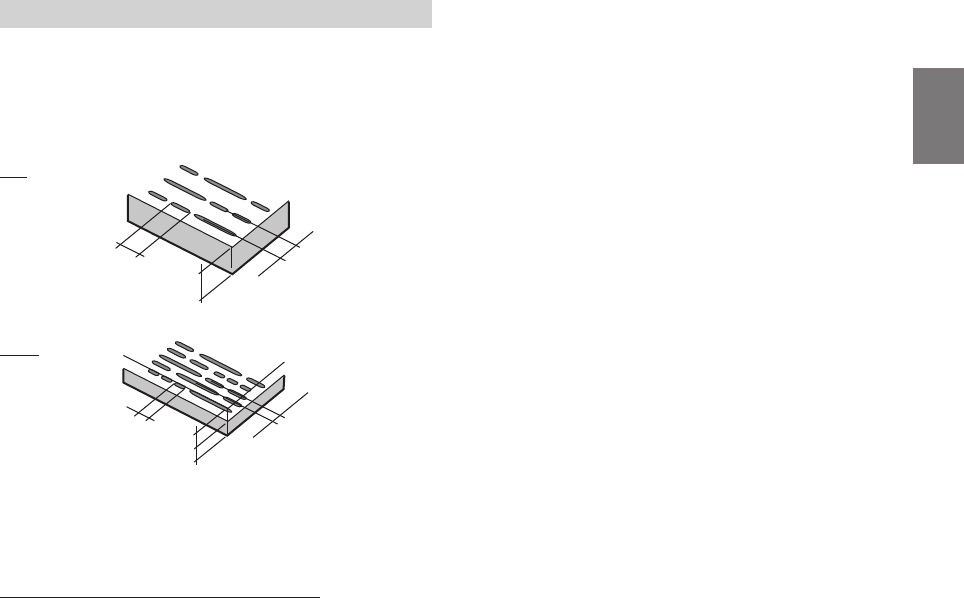
103-EN
Music CDs and DVDs have grooves (tracks) in which the digital data is
recorded. The data is represented as microscopic pits recorded into the
track – these pits are read by a laser beam to play the disc. On DVDs, the
density of the tracks and pits is twice that of CDs, so DVDs can contain
more data in less space.
A 12 cm disc can contain one movie or about four hours of music. In
addition, DVDs provide sharp picture quality with vivid colors thanks to
a horizontal resolution of over 500 lines (compared to less than 300 for
VHS tape).
In addition, DVDs offer a variety of functions.
Multiple audio* (page 77)
Movies can be recorded in up to eight languages. The desired
language can be selected from the unit.
Subtitles function* (page 77)
Movies can include subtitles in up to 32 languages. The desired
subtitle language can be selected from the unit.
Multi angle function* (page 77)
When the DVD contains a movie shot from multiple angles, the
desired angle can be selected from the unit.
Multi story function*
With this function, a single movie includes various story lines. You can
select different story lines to view various versions of the same movie.
Operation differs from disc to disc. Story line selection screens
including instructions appear during the movie. Just follow the
instructions.
*These functions differ from disc to disc. For details, refer to the disc’s
instructions.
About DVDs
CDs
Minimum pit
length -
0.9 µm 1.2 mm Track pitch -
1.6 µm
DVDs
Minimum pit
length -
0.9 µm
0.6 mm Track pitch -
0.74 µm
0.6 mm
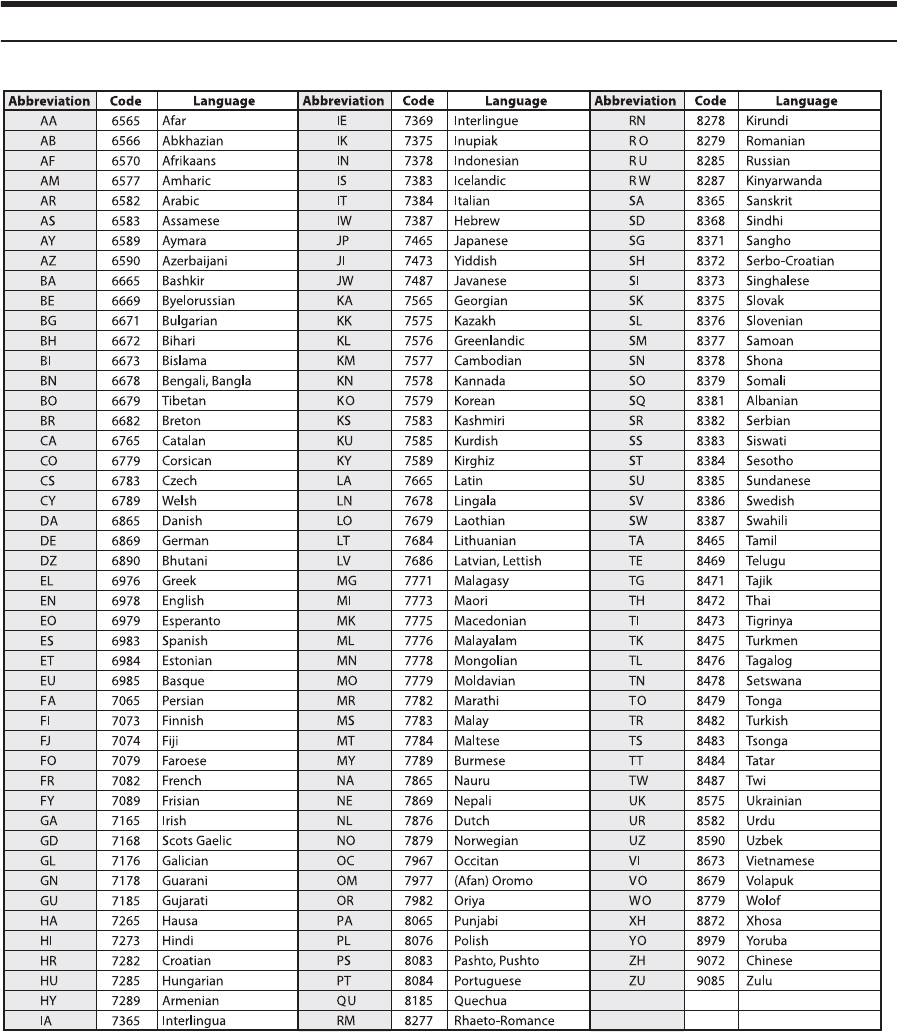
104-EN
List of Language Codes
(For details, see page 70.)

105-EN
In Case of Difficulty
Basic
No function or display.
• Vehicle’s ignition is off.
- If connected according to the instructions, the unit will not
operate with the vehicle’s ignition off.
• Improper power lead connections.
- Check power lead connections.
• Blown fuse.
- Check the fuse on the battery lead of the unit; replace with the
proper value if necessary.
• Internal micro-computer malfunctioned due to interference
noise, etc.
- Press the RESET switch with a ballpoint pen or other pointed
article.
No sound or unnatural sound.
• Incorrect setting of volume/balance/fader controls.
- Readjust the controls.
• Connections are not properly or securely made.
- Check the connections and firmly connect.
Screen not displayed.
• Brightness/Contrast control is set at the minimum position.
- Adjust the Brightness/Contrast control.
• Temperature in the vehicle is too low.
- Increase the vehicle’s interior temperature to operation
temperature range.
• Connections to the Auxiliary Device are not securely made.
- Check the connections and firmly connect.
• The Parking Brake Lead is not connected.
• The Parking Brake is not engaged.
- Connect the Parking Brake Lead, then engage the Parking
Brake.
Movement of displayed picture is abnormal.
• Temperature in the vehicle is too high.
- Allow the vehicle’s interior temperature to cool.
The optional remote control is inoperative.
• The remote control sensor setting of “Remote Sensor Setting”
(page 49) is not set to this unit (“Front”).
- Set for “Front”.
Radio
Unable to receive stations.
• No antenna, or open connection in the antenna cable.
- Make sure the antenna is properly connected; replace the
antenna or cable if necessary.
Unable to tune stations in the seek mode.
• You are in a weak signal area.
- Make sure the tuner is in DX mode.
• If the area you are in is a primary signal area, the antenna may
not be grounded and connected properly.
- Check your antenna connections; make sure the antenna is
properly grounded at its mounting location.
• The antenna may not be the proper length.
- Make sure the antenna is fully extended; if broken, replace the
antenna with a new one.
Broadcast is noisy.
• The antenna is not the proper length.
- Extend the antenna fully; replace it if it is broken.
• The antenna is poorly grounded.
- Make sure the antenna is grounded properly at its mounting
location.
• The station signal is weak and noisy.
- If above solution does not work, tune in another station.
USB Audio
Unit does not operate.
• Condensation.
- Wait a while (about 1 hour) for the condensation to dry.
Picture is unclear or noisy.
• Vehicle’s battery power is weak.
- Check the battery power and wiring.
(The unit may malfunction if the battery power is under 11
volts with a load applied.)
Rear Seat Entertainment System
DVD sound is not being output from the rear monitor
headphones.
• The external audio processor and DVD Player (DVE-5300) are
optically connected.
- Set the Audio Out of the DVD Player to “LPCM.”
Disc
Disc playback sound is wavering.
• Moisture condensation in the disc module.
- Allow enough time for the condensation to evaporate (about 1
hour).
Disc insertion not possible.
• A disc is already in this unit.
- Eject the disc and remove it.
• The disc is being improperly inserted.
- Insert the disc correctly. (See page 69)
Unable to fast forward or backward the disc.
• The disc has been damaged.
- Eject the disc and discard it; using a damaged disc in your unit
can cause damage to the mechanism.
If you encounter a problem, please turn the power off,
then on again. If the unit is still not functioning normally,
please review the items in the following checklist. This
guide will help you isolate the problem if the unit is at
fault. Otherwise, make sure the rest of your system is
properly connected, or then consult your authorized
Alpine dealer.

106-EN
Disc playback sound skips due to vibration.
• Improper mounting of the unit.
- Securely re-mount the unit.
• Disc is very dirty.
- Clean the disc.
• Disc has scratches.
- Change the disc.
• The pick-up lens is dirty.
- Do not use a commercially available lens cleaner disc. Consult
your nearest Alpine dealer.
Disc playback sound skips without vibration.
• Dirty or scratched disc.
- Clean the disc; a damaged disc should be replaced.
CD-R/CD-RW/DVD-R/DVD-RW/DVD+R/DVD+RW playback
not possible.
• Close session (finalization) has not been performed.
- Perform finalization and attempt playback again.
Error displays.
• Mechanical error.
- Press . After the error indication disappears, insert the disc
again. If the above-mentioned solution does not solve the
problem, consult your nearest Alpine dealer.
MP3/WMA/AAC is not played back.
• Writing error occurred. The CD format is not compatible.
- Make sure the CD has been written in a supported format.
Refer to “About MP3/WMA/AAC” (pages 101 to 102), then
rewrite in the format supported by this device.
Unit does not operate.
• Condensation.
- Wait a while (about 1 hour) for the condensation to dry.
Playback does not start.
• Disc is loaded upside-down.
- Check the disc and load it with the labelled side facing upward.
• Disc is dirty.
- Clean the disc.
• A disc not able to play back with this unit is loaded.
- Check if the disc is able to be played back.
• Parental lock is set.
- Cancel the parental lock or change the rating level.
Picture is unclear or noisy.
• Disc is being fast-forwarded or fast-reversed.
- The picture may be slightly disturbed, but this is normal.
• Vehicle’s battery power is weak.
- Check the battery power and wiring.
(The unit may malfunction if the battery power is under 11
volts with a load applied.)
Image stops sometimes.
• Disc is scratched.
- Replaced with a non-scratched disc.
Navigation
The Navigation cannot work properly.
• Reset Navigation system.
- Reinsert the SD card and turn the ignition key off, and then set
to ON again.
If this Message Appears
Various messages are displayed on the screen during operation. In
addition to the messages telling you the current status or providing
guidance for the next operation, there are also the following error
messages. If one of these error messages is displayed, carefully follow the
instructions in the solution column.
System
If you are driving, please pull over before using this function.
• A setup operation, etc., was carried out while the vehicle was
running.
- Move the vehicle to a safe location, stop, and engage the
parking brake, then carry out this operation.
USB current error.
• Abnormal current is run to the USB connector device.
- Turn the ignition key off, and then set to ON again.
- Attempt to connect another iPod/iPhone/USB Flash drive.
USB HUB is not supported.
• A USB flash drive with a hub is connected.
- You cannot play back from a USB flash drive with a hub. USB
hub connections are also not supported.
Audio/Visual
Connected USB device is not supported.
• An iPod/iPhone that is not supported by the unit is connected.
- Connect an iPod/iPhone that is supported by the unit.
- Reset the iPod.
• A USB device that is not supported by the unit is connected.
- Attempt to connect another USB flash drive.
• Communication error.
- Turn the ignition key off, and then set to ON again.
- Check the display by reconnecting between the iPod/iPhone
and the unit, using the iPod/iPhone cable.
- Check the display by reconnecting between the USB flash drive
and the unit.
• Caused by the iPod/iPhone Software Version not being
compatible with this unit.
- Update the iPod/iPhone Software Version to be compatible
with this unit.
• The iPod/iPhone is not verified.
- Change to another iPod/iPhone.
No data.
• There are no data in the iPod/iPhone.
- Download data to the iPod/iPhone and connect to the unit.
• There are no data in the USB flash drive.
- Download data to the USB flash drive and connect to this unit.
Un-readable song was skipped.
• A copy-protected WMA file has been detected.
- You can only play back non-copy-protected files.
• A sampling rate/bit rate not supported by the unit is used.
- Use a sampling rate/bit rate supported by the unit.

107-EN
Bluetooth
Please connect Bluetooth audio device.
• The Bluetooth audio device was not connected correctly.
- Check the settings for the unit and the Bluetooth audio device
and reconnect.
Unable to download phonebook.
• Phonebook failed to read due to mobile phone disconnection,
etc.
- Check the mobile phone connection, and then conduct
synchronizing and adding again. (See page 83)
• The connected mobile phone does not support synchronizing of
its phone book.
- Connect the mobile phone that supports synchronizing the
phone book, then synchronize again. (See page 83)
HDMI
HDMI communication error,
Please check your device and operate it again.
• Communication error.
- Turn the ignition key off, and then set to ON again.
- Check the display by reconnecting between the HDMI and the
unit, using the HDMI cable.
- Check the display by reconnecting between the HDMI device
and the unit.
HDMI current error,
Please Connect your device again.
• Abnormal current is run to the HDMI connector device.
- Turn the ignition key off, and then set to ON again.
- Disconnect the HDMI device from the unit, and then
reconnect it.
HDMI monitor communication error.
Please check the connection or ACC off / on.
• HDMI device communication error.
- Turn the engine (ACC) OFF/ON. Or, check the HDMI cable
where it connects to the HDMI monitor.
Monitor connect via HDMI has been exceeded.
Please check the connection.
• More than 4 HDMI monitors are connected.
• A cascade connection using more than 2 distributors is made.
- Use one distributor and less than 4 HDMI monitors when
connecting.
iDataLink
CAN Communication error
• Communication error.
- Check the iDataLink module connection.
SiriusXM
Check Tuner
• The SiriusXM Tuner is disconnected or the unit is having trouble
communicating with the Tuner.
- Connect the Tuner or check the Tuner connection to the back
of the unit.
Check Antenna
• The SiriusXM Satellite Radio antenna or cable is either damaged
or not connected correctly to the SiriusXM Tuner.
- Check that the SiriusXM antenna cable is connected to the
SiriusXM Tuner and check that the antenna cable is not kinked
or otherwise damaged. Replace the antenna if necessary.
No Signal
• The SiriusXM satellite signal is too weak at the current location.
- Move the vehicle to a location with a clear view of the southern
sky.
- Make sure the Satellite Radio antenna is properly mounted and
not obstructed by metal objects.
Channel <xxx> Not Subscribed
Call SiriusXM To Subscribe
• The active channel has become unsubscribed or the requested
channel is not available in your subscription package.
- Visit www.siriusxm.com for information on subscribing to this
channel.
- The unit will revert to the previous selected channel or to
channel 1 automatically.
Channel <xxx> Not Available
• The active channel is no longer in the SiriusXM channel lineup
or the user has entered an invalid channel number.
- Visit www.siriusxm.com for information on the current
channel lineup.
• The unit will revert to the previous channel or to channel 1
automatically.
Subscription Updated
Press OK to Continue
• Your subscription has been updated.
- Touch [OK] to clear this message.
Channel <xxx> Locked
• A locked channel is selected.
- Input the passcode on the number keypad screen, see “Parental
Lock Function” (page @@). If wrong passcode is input,
“Incorrect Pass Code entered” will be displayed and the unit
will revert to the previous channel.
Updating · · ·
• The Featured Favorites channels are during updating.
Updating Teams, please wait
• While the Game table is during updating, the [Game Alert Setup]
button in SiriusXM setup mode is touched.
Replay Memory Full
• Buffer for Replay is full.
Replay Memory Near Full
• Buffer for Replay will full within 11 seconds.
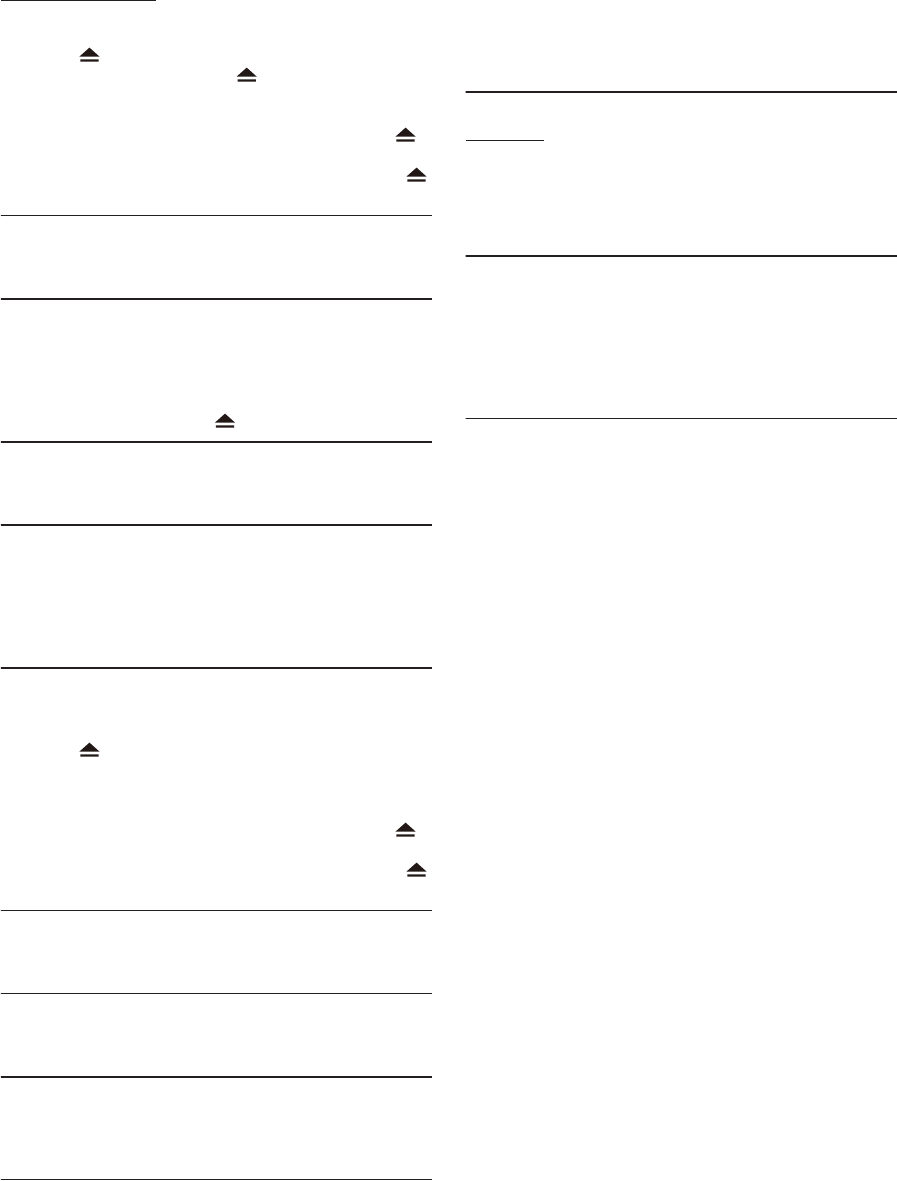
108-EN
X110 with DVE-5300X
DISC ERROR
• Mechanism error.
1) Press and eject the disc.
If the disc does not eject, press again for at least 3 seconds
and eject the disc.
If the disc still does not eject, consult your Alpine dealer.
2) When the error indication remains after ejecting, press
again.
If the error indication still does not turn off after pressing
a few times, consult your Alpine dealer.
LO-TEMP
• The temperature in the car is too low.
- Raise the temperature in the car to normal temperature.
NO DISC
• No disc is inserted.
- Insert a disc.
• Although a disc is inserted, “NO DISC” is displayed and the unit
does not start to play or eject the disc.
- Remove the disc by pressing again for at least 3 seconds.
REGIONAL CODE VIOLATION
• Disc does not match regional code number.
- Load a disc that matches the regional code number.
HI-TEMP
• Protective circuit is activated at high temperature.
- The indicator will disappear when the temperature returns to
within operation range.
- Leave the power OFF until the temperature decreases and then
turn the power ON again.
LOADING ERROR
EJECT ERROR
• Mechanism error.
1) Press and eject the disc.
If the disc does not eject, press c again for at least 3 seconds
and eject the disc.
If the disc still does not eject, consult your Alpine dealer.
2) When the error indication remains after ejecting, press
again.
If the error indication still does not turn off after pressing
a few times, consult your Alpine dealer.
PROTECTED
• A copy-protected WMA file was played back.
- You can only play back non-copy-protected files.
UNSUPPORTED
• A sampling rate/bit rate not supported by the unit is used.
- Use a sampling rate/bit rate that is supported by the unit.
ILLEGAL FORMAT
• A disc with an unsupported region code or other copyright
infringement has been inserted.
- Change to another disc.
READ ERROR
• The unit cannot read a disc's TOC because the disc has many
scratches or is very dirty.
- Clean the dirty disc, and insert it again. Damaged discs should
be replaced.
Navigation
The vehicle’s position is erroneous.
• The GPS reception is poor.
- Drive the vehicle in an area of good GPS reception to allow the
unit to recalibrate itself. Move to a location where strong GPS
reception is possible.
No operation
• Moisture condensation
- Allow enough time for the condensation to evaporate (about 1
hour).
• Ambient Temperature
- Make sure the temperature inside the vehicle is between 0°C
and 45°C (32°F and 113°F).

109-EN
Specifications
MONITOR SECTION
FM TUNER SECTION
AM TUNER SECTION
USB SECTION
HDMI SECTION
GPS SECTION
Bluetooth SECTION
GENERAL
CHASSIS SIZE
NOSE SIZE
• Due to continuous product improvement, specifications and design are
subject to change without notice.
• The LCD panel is manufactured using an extremely high precision
manufacturing technology. Its effective pixel ratio is over 99.99%. This
means that there is a possibility that 0.01% of the pixels could be either
always ON or OFF.
Screen Size 10” (X110)
8” (X108U)
7” (INE-W967HD)
LCD Type Transparent type TN LCD
Operation System TFT active matrix
Number of Picture Elements 1,152,000 pcs. (800 × 480 × 3
(RGB))
Effective Number of Picture Elements
99% or more
Illumination System LED
Tuning Range 87.7 – 107.9 MHz
Mono Usable Sensitivity 9.3 dBf (0.8 µV/75 ohms)
50 dB Quieting Sensitivity 13.5 dBf (1.3 µV/75 ohms)
Alternate Channel Selectivity 80 dB
Signal-to-Noise Ratio 65 dB
Stereo Separation 35 dB
Capture Ratio 2.0 dB
Tuning Range 531 – 1,602 kHz
Usable Sensitivity 25.1 μV/28 dBf
USB requirements USB 2.0
Max. Power Consumption 1,500 mA (CDP Support)
USB Class USB (Play From Device)/
USB (Mass Storage Class)
File System FAT16/32
Number of Channels 2-Channels (Stereo)
Frequency Response*15 – 20,000 Hz (±1 dB)
Total Harmonic Distortion 0.008% (at 1 kHz)
Dynamic Range 95 dB (at 1 kHz)
Signal-to-Noise Ratio 100 dB
Channel Separation 85 dB (at 1 kHz)
*1 Frequency response may differ depending on the encoder software/bit
rate.
Input Format 720p/480p/VGA
Output Format 480p
GPS Reception frequency 1,575.42 ±1 MHz
GPS Reception sensitivity -130 dB max.
Bluetooth Specification Bluetooth V2.1+EDR
Output Power +4 dBm Max. (Power class 2)
Profile HFP (Hands-Free Profile)
OPP (Object Push Profile)
PBAP (Phone Book Access Profile)
A2DP (Advanced Audio
Distribution Profile)
AVRCP (Audio/Video Remote
Control Profile)
SPP (Serial Port Profile)
Power Requirement 14.4 V DC
(11–16 V allowable)
Operating temperature -4°F to +140°F
(-20°C to + 60°C)
Maximum Power Output 50 W × 4
Weight 2.9 kg (6 lbs. 6 oz) (X108U)
2.7 kg (5 lbs. 15 oz) (INE-W967HD)
Audio output level
Preout (Front, Rear): 4V/10k ohms (max.)
Preout (Subwoofer): 4V/10k ohms (max.)
Width 178 mm (7-1/8”)
Height 100 mm (4”)
Depth 147 mm (5-7/8”)
Width 190.5 mm (7-1/2”) (X108U)
171 mm (6-3/4”) (INE-W967HD)
Height 120.5 mm (4-3/4”) (X108U)
96 mm (3-7/8”) (INE-W967HD)
Depth 19 mm (3/4”) (X108U)
19 mm (3/4”) (INE-W967HD)
V3.0
-2
Ave.
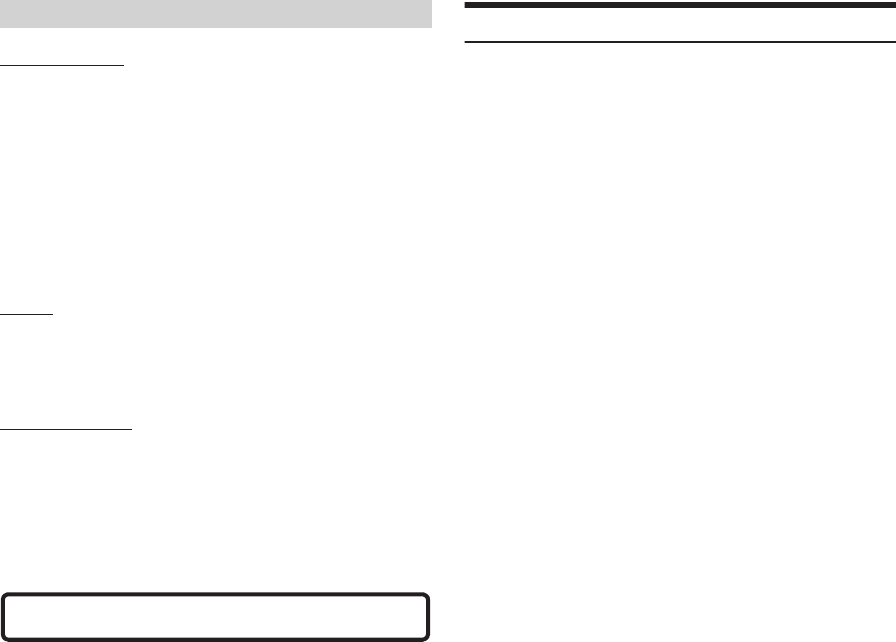
110-EN
CD/DVD SECTION
PICKUP
REMOTE CONTROL
END USER LICENSE AGREEMENT (HERE)
In using this Navigation System (hereinafter referred to as “System”),
which includes Alpine Electronics, Inc. (“Alpine”) Specifications, Space
Machine, Inc. (“Space Machine”) Software and HERE North America,
LLC. (“HERE”) Database, you are bound by the terms and conditions
set forth below. By breaking the seal on the System and using your
copy of the System, you have demonstrated your agreement to the
terms and conditions of this Agreement. You should, therefore, make
sure that you read and understand the following provisions.
The System may not be copied, duplicated or otherwise modified, in
whole or in part, without the express written permission of Alpine,
Space Machine and HERE.
The System may not be transferred or sublicensed to any third party
for profit, rent or loan or licensed for reuse in any manner.
The System may not be decompiled, reverse engineered or otherwise
disassembled, in whole or in part.
The System may not be used in a network or by any other manner of
simultaneous use in multiple systems.
The System is intended solely for personal use (or internal use where
the end-user is a business) by the consumer.
The System is not to be used for commercial purposes.
Neither Alpine, Space Machine nor HERE guarantees to the customer
that the System meet the specific objectives of the user.
Neither Alpine, Space Machine nor HERE shall be responsible for any
damages caused by the use of the System to the actual user and to
any third party.
The warranty on the System shall not extend to an exchange or
refund due to misspelling, omission of letters, or any other cosmetic
discrepancy in layout found in the System.
The right to use the System shall expire either when the user destroys
this software, or when any of the terms for use is violated and Alpine,
Space Machine and/or HERE exercise the option to revoke the license
to use this software.
The terms and conditions hereof apply to all subsequent users and
owner’s as well as to the original purchaser.
The HERE Database may include or reflect data of licensors, including
Her Majesty The Queen in right of CANADA. Such data is licensed on
an “AS IS” basis. The licensors, including Her Majesty The Queen, make
no guarantees, representations or warranties respecting such data,
either express or implied, arising by law or otherwise, accuracy or
fitness for a particular purpose.
The licensors, including Her Majesty The Queen, shall not be liable in
respect of any claim, demand or action, irrespective of the nature of
the cause of the claim, demand or action alleging any loss, injury or
damages, direct or indirect, which may result from the use or
possession of the data or the HERE database. The licensors, including
Her Majesty The Queen, shall not be liable in any way for loss of
revenues or contracts, or any other consequential loss of any kind
resulting from any defect in the data or the HERE database.
End User shall indemnify and save harmless the licensors, including
Her Majesty The Queen and the minister, and their officers,
employees and agents from and against any claim, demand or action,
irrespective of the nature of the cause of the claim, demand or action,
alleging loss, costs, expenses, damages or injuries (including injuries
resulting in death) arising out of the use or possession of the data or
the HERE database.
X110 with DVE-5300X
Frequency Response CD: 5 – 20,000 Hz (± 1 dB)
Wow & Flutter (% WRMS) Below measurable limits
Total Harmonic Distortion 0.02 % (at 1 kHz)
Dynamic Range 95 dB (at 1 kHz)
Channel Separation 65 dB (at 1 kHz)
Horizontal resolution 500 lines or greater
Video output level 1Vp-p (75 ohms)
Video S/N ratio DVD: 60 dB
Audio S/N ratio 95 dB
Wave length DVD: 665 nm
CD: 800 nm
Laser power CLASS II
Battery Type CR2025 battery
Width 42 mm (1-11/16”)
Height 90 mm (3-5/8”)
Depth 11.6 mm (15/32”)
Weight 50 g (2 oz) (battery excluded)
CAUTION-Laser radiation when open, DO NOT STARE INTO BEAM
(Bottom side of player)
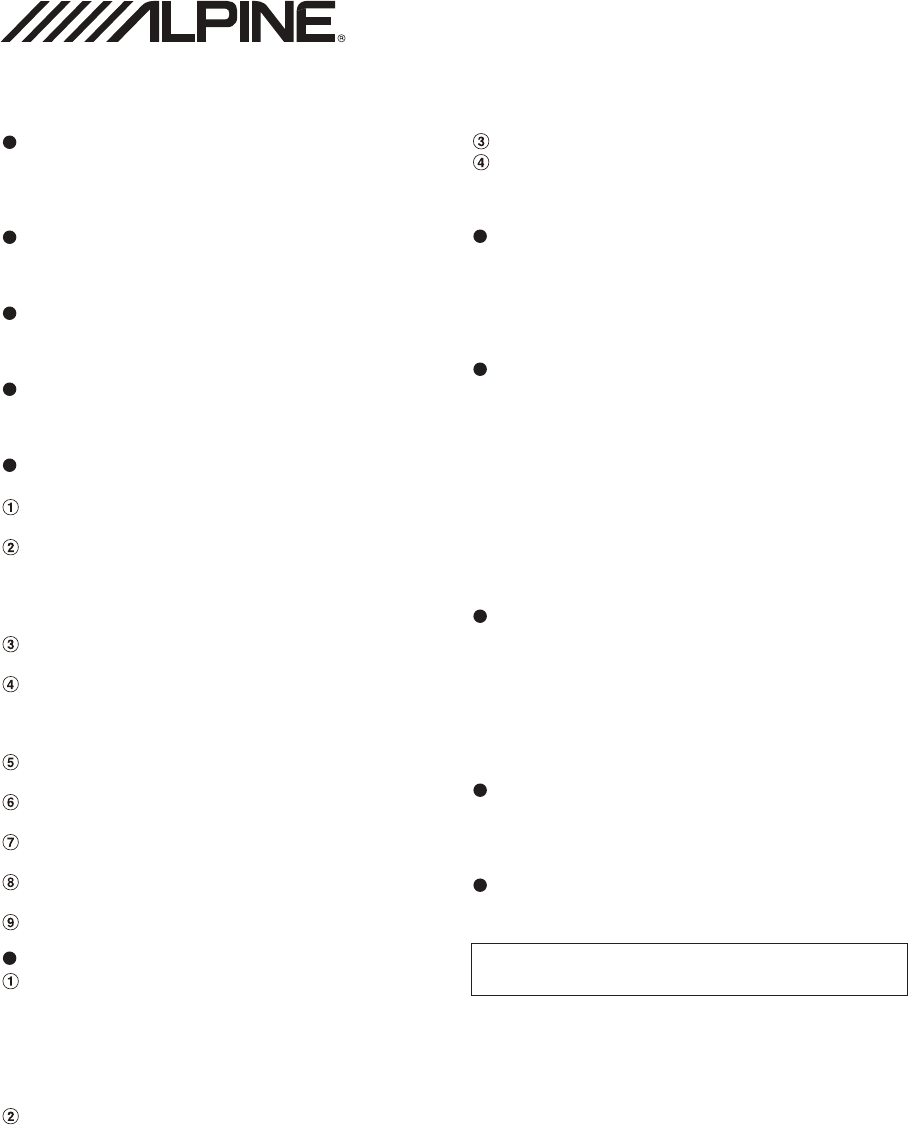
LIMITED WARRANTY
ALPINE ELECTRONICS OF AMERICA, INC. (“Alpine”), is dedicated to quality craftsmanship and is pleased to offer this Warranty. We suggest that you
read it thoroughly. Should you have any questions, please contact your Dealer or contact Alpine at one of the telephone numbers listed below.
PRODUCTS COVERED:
This Warranty covers Car Audio Products and Related Accessories (“the
product”). Products purchased in the Canada are covered only in the
Canada. Products purchased in the U.S.A. are covered only in the U.S.A.
LENGTH OF WARRANTY:
This Warranty is in effect for one year from the date of the first
consumer purchase.
WHO IS COVERED:
This Warranty only covers the original purchaser of the product, who
must reside in the United States, Puerto Rico or Canada.
WHAT IS COVERED:
This Warranty covers defects in materials or workmanship (parts and
labor) in the product.
WHAT IS NOT COVERED:
This Warranty does not cover the following:
Damage occurring during shipment of the product to Alpine for
repair (claims must be presented to the carrier).
Damage caused by accident or abuse, including burned voice coils
caused by over-driving the speaker (amplifier level is turned up
and driven into distortion or clipping). Speaker mechanical failure
(e.g. punctures, tears or rips). Cracked or damaged LCD panels.
Dropped or damaged hard drives.
Damage caused by negligence, misuse, improper operation or
failure to follow instructions contained in the Owner’s manual.
Damage caused by act of God, including without limitation,
earthquake, fire, flood, storms or other acts of nature.
Any cost or expense related to the removal or reinstallation of the
product.
Service performed by an unauthorized person, company or
association.
Any product which has the serial number defaced, altered or
removed.
Any product which has been adjusted, altered or modified without
Alpine’s consent.
Any product not distributed by Alpine within the United States,
Puerto Rico or Canada.
Any product not purchased from an Authorized Alpine Dealer.
HOW TO OBTAIN WARRANTY SERVICE:
You are responsible for delivery of the product to an Authorized
Alpine Service Center or Alpine for repair and for payment of any
initial shipping charges. Alpine will, at its option, repair or replace
the product with a new or reconditioned product without charge.
If the repairs are covered by the warranty, and if the product was
shipped to an Authorized Alpine Service Center or Alpine, Alpine
will pay the return shipping charges.
You should provide a detailed description of the problem(s) for
which service is required.
You must supply proof of your purchase of the product.
You must package the product securely to avoid damage during
shipment. To prevent lost packages it is recommended to use a
carrier that provides a tracking service.
HOW WE LIMIT IMPLIED WARRANTIES:
ANY IMPLIED WARRANTIES INCLUDING FITNESS FOR USE AND
MERCHANTABILITY ARE LIMITED IN DURATION TO THE PERIOD OF THE
EXPRESS WARRANTY SET FORTH ABOVE AND NO PERSON IS
AUTHORIZED TO ASSUME FOR ALPINE ANY OTHER LIABILITY IN
CONNECTION WITH THE SALE OF THE PRODUCT.
HOW WE EXCLUDE CERTAIN DAMAGES:
ALPINE EXPRESSLY DISCLAIMS LIABILITY FOR INCIDENTAL AND
CONSEQUENTIAL DAMAGES CAUSED BY THE PRODUCT. THE TERM
“INCIDENTAL DAMAGES” REFERS TO EXPENSES OF TRANSPORTING
THE PRODUCT TO THE ALPINE SERVICE CENTER, LOSS OF THE
ORIGINAL PURCHASER’S TIME, LOSS OF THE USE OF THE PRODUCT,
BUS FARES, CAR RENTALS OR OTHERS COSTS RELATING TO THE CARE
AND CUSTODY OF THE PRODUCT. THE TERM “CONSEQUENTIAL
DAMAGES” REFERS TO THE COST OF REPAIRING OR REPLACING OTHER
PROPERTY WHICH IS DAMAGED WHEN THIS PRODUCT DOES NOT
WORK PROPERLY. THE REMEDIES PROVIDED UNDER THIS WARRANTY
ARE EXCLUSIVE AND IN LIEU OF ALL OTHERS.
HOW STATE/PROVINCIAL LAW RELATES TO THE
WARRANTY:
This Warranty gives you specific legal rights, and you may also have
other rights which vary from state to state and province to province. In
addition, some states/provinces do not allow limitations on how long
an implied warranty lasts, and some do not allow the exclusion or
limitation of incidental or consequential damages. Accordingly,
limitations as to these matters contained herein may not apply to you.
IN CANADA ONLY:
This Warranty is not valid unless your Alpine car audio product has
been installed in your vehicle by an Authorized Installation Center, and
this warranty stamped upon installation by the installation center.
HOW TO CONTACT CUSTOMER SERVICE:
Should the product require service, please call the following number
for your nearest Authorized Alpine Service Center.
Or visit our website at; http://www.alpine-usa.com
CAR AUDIO 1-800-ALPINE-1 (1-800-257-4631)
NAVIGATION 1-888-NAV-HELP (1-888-628-4357)
ALPINE ELECTRONICS OF AMERICA, INC., 19145 Gramercy Place, Torrance, California 90501, U.S.A.
Do not send products to this address.
Call the toll free telephone number or visit the website to locate a service center.

About the Rules of Bluetooth Electromagnetic Radiation Regulation
USA/Canada
FCC CAUTION
Changes or modifications not expressly approved by the party responsible for compliance could void the user’s
authority to operate the equipment.
This equipment complies with FCC/IC radiation exposure limits set forth for an uncontrolled environment and
meets the FCC radio frequency (RF) Exposure Guidelines in Supplement C to OET65 and RSS-102 of the IC radio
frequency (RF) Exposure rules. This equipment has very low levels of RF energy that it deemed to comply without
maximum permissive exposure evaluation (MPE). But it is desirable that it should be installed and operated keeping
the radiator at least 20cm or more away from person’s body (excluding extremities: hands, wrists, feet and ankles).
Cet équipement est conforme aux limites d’exposition aux rayonnements énoncées pour un environnement non
contrôlé et respecte les règles les radioélectriques (RF) de la FCC lignes directrices d’exposition dans le Supplément
C à OET65 et d’exposition aux fréquences radioélectriques (RF) CNR-102 de l’IC. Cet équipement émet une énergie
RF très faible qui est considérée conforme sans évaluation de l’exposition maximale autorisée. Cependant, cet
équipement doit être installé et utilisé en gardant une distance de 20 cm ou plus entre le dispositif rayonnant et le
corps (à l’exception des extrémités : mains, poignets, pieds et chevilles).
Don’t forget to take a moment to protect your purchase by registering your product now at the following
address: www.alpine-usa.com/registration.
N’oubliez pas de consacrer un moment à la protection de votre achat en enregistrant votre produit dès
maintenant à l’adresse suivante : www.alpine-usa.com/registration.
Recuerde que con solo unos pocos pasos podrá proteger su producto, registrándolo a través de la siguiente
dirección: www.alpine-usa.com/registration.
USA/Canada
Changes or modifications not expressly approved by the party responsible for compliance could void the
user's authority to operate the equipment.
This equipment complies with FCC/IC radiation exposure limits set forth for an uncontrolled environment and
meets the FCC radio frequency (RF) Exposure Guidelines and RSS-102 of the IC radio frequency (RF)
Exposure rules. This equipment has very low levels of RF energy that it deemed to comply without maximum
permissive exposure evaluation (MPE). But it is desirable that it should be installed and operated keeping the
radiator at least 20cm or more away from person's body.
This device complies with Industry Canada’s licence-exempt RSSs. Operation is subject to the following two
conditions:
(1) This device may not cause interference; and
(2) This device must accept any interference, including interference that may cause undesired operation of
the device.
Cet équipement est conforme aux limites d'exposition aux rayonnements énoncées pour un environnement
non contrôlé et respecte les règles les radioélectriques (RF) de la FCC lignes directrices d'exposition et
d'exposition aux fréquences radioélectriques (RF) CNR-102 del'IC. Cet équipement émet une énergie RF très
faible qui est considérée conforme sans évaluation de l'exposition maximale autorisée (MPE). Cependant, il
est souhaitable qu'il devrait être installé et utilisé en gardant une distance de 20 cm ou plus entre le
radiateur et le corps humain.
Le présent appareil est conforme aux CNR d’Industrie Canada applicables aux appareils radio exempts de
licence.
L’exploitation est autorisée aux deux conditions suivantes :
1) l’appareil ne doit pas produire de brouillage;
2) l’utilisateur de l’appareil doit accepter tout brouillage radioélectrique subi, même si le brouillage est
susceptible d’en compromettre le fonctionnement.